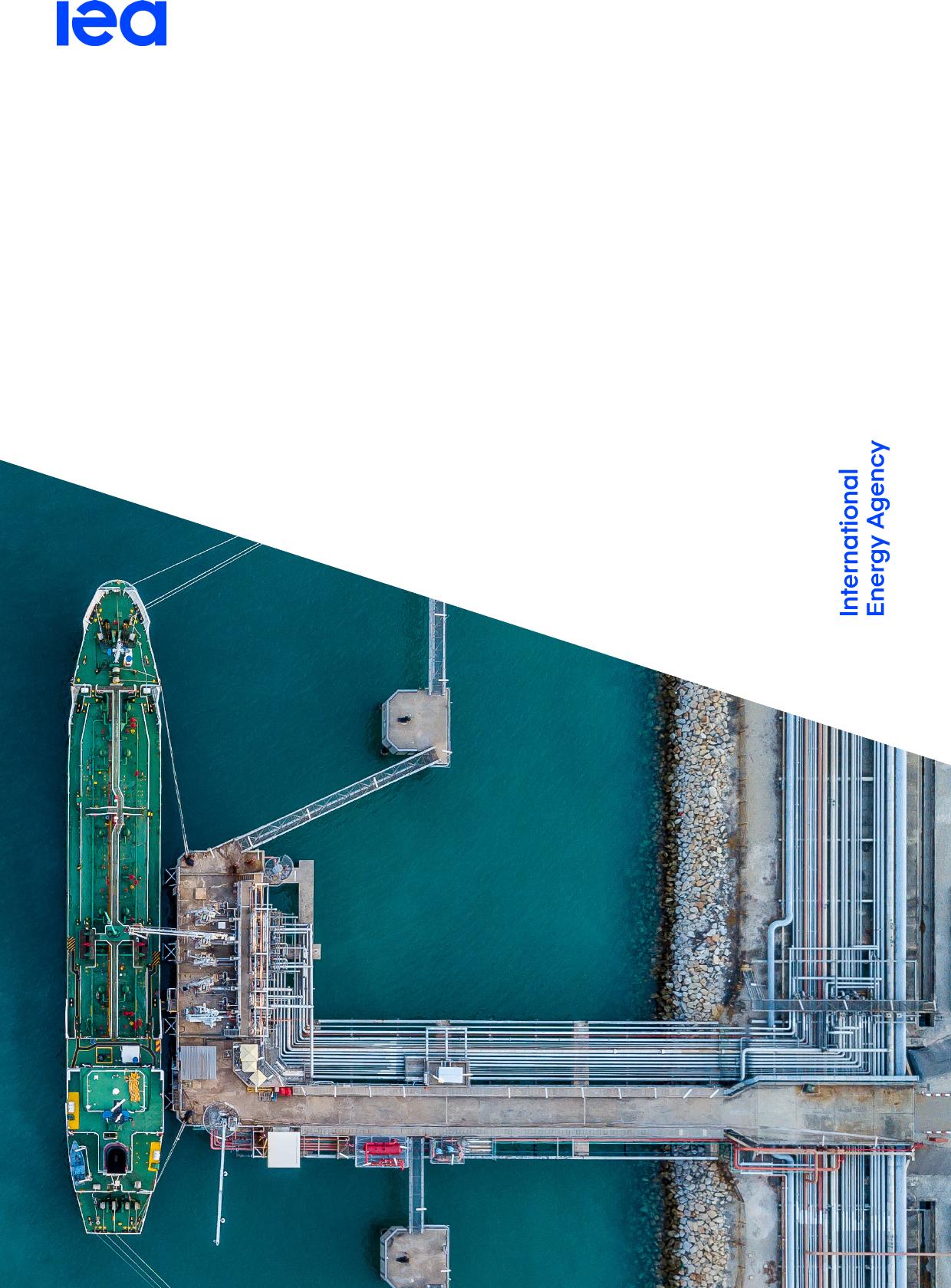CCUSPoliciesandBusinessModelsBuildingacommercialmarketINTERNATIONALENERGYAGENCYTheIEAexaminestheIEAmemberIEAassociationfullspectrumcountries:countries:ofenergyissuesincludingoil,gasandAustraliaArgentinacoalsupplyandAustriaBrazildemand,renewableBelgiumChinaenergytechnologies,CanadaEgyptelectricitymarkets,CzechRepublicIndiaenergyefficiency,DenmarkIndonesiaaccesstoenergy,EstoniaKenyademandsideFinlandMoroccomanagementandFranceSenegalmuchmore.ThroughGermanySingaporeitswork,theIEAGreeceSouthAfricaadvocatespoliciesthatHungaryThailandwillenhancetheIrelandUkrainereliability,affordabilityItalyandsustainabilityofJapanenergyinitsKorea31membercountries,Lithuania13associationLuxembourgcountriesandbeyond.MexicoNetherlandsThispublicationandanyNewZealandmapincludedhereinareNorwaywithoutprejudicetothePolandstatusoforsovereigntyoverPortugalanyterritory,totheSlovakRepublicdelimitationofinternationalSpainfrontiersandboundariesandSwedentothenameofanyterritory,Switzerlandcityorarea.RepublicofTürkiyeUnitedKingdomUnitedStatesTheEuropeanCommissionalsoparticipatesintheworkoftheIEASource:IEA.InternationalEnergyAgencyWebsite:www.iea.orgCCUSPoliciesandBusinessModels:buildingacommercialmarketAbstractAbstractCarboncapture,utilisationandstorage(CCUS)isanimportanttechnologyforachievingglobalnetzeroemissions.MomentumonCCUShasincreasedinrecentyears,butthedeploymentofprojectshasremainedrelativelyflat.Emergingbusinessmodelsareopeningthedoortonewinvestmentopportunities,andwiththatbringingnewchallengestobeovercome.Thescale-upneededtoreachnetzeroemissionsbymid-centuryrepresentsamajorundertaking,andpolicysupportandco-ordinationarecrucial.Policymakershaveasuiteoftoolsattheirdisposaltocreatetheconditionsnecessarytodrivelong-terminvestment,enablingindustrytotakethenextstepforwardandpushCCUSintoaviableandsustainablecommercialmarket.ThisIEACCUSHandbookprovidesgovernmentswithapolicytoolkittotackletheoverarchingchallengestoCCUSdeployment.ItgivesanoverviewofexistingpoliciesthathavehelpedlaunchCCUSprojectstodateandidentifiesthemainchallengestofuturelarge-scaledeployment.Thehandbookalsohighlightsinternationalbestpractices,drawingonexistingandproposedgovernmenteffortstoaddressthesechallenges.ThehandbookissupportedbyourCCUSProjectsDatabase1andcomplementstheIEACCUSHandbooksonLegalandRegulatoryFrameworksforCCUSandonCO2StorageResourcesandtheirDevelopment.1TheIEACCUSProjectsDatabaseavailablefordownloadcontainsprojectsupdatesasofFebruary2023.ThisreportreliesIEA.CCBY4.0.onaninternalversionofthedatabasewithprojectupdatesasofQ22023,withtheexceptionofmajorprojectupdates,whichincludeprojects(re)enteringoperationorconstruction,whichareincludeduptoOctober2023.PAGE3CCUSPoliciesandBusinessModels:buildingacommercialmarketAcknowledgementsAcknowledgementsThisstudywaspreparedbytheEnergyTechnologyPolicy(ETP)DivisionoftheDirectorateofSustainability,TechnologyandOutlooks(STO)oftheInternationalEnergyAgency(IEA).ThestudywasdesignedanddirectedbyTimurGül,ChiefEnergyTechnologyOfficerandHeadoftheEnergyTechnologyPolicyDivision.Theanalysisandproductionwasco-ordinatedbySaraBudinis.Theleadauthorswere(inalphabeticalorder)SaraBudinis,MathildeFajardy,CarlGreenfieldandFlowra(Yuting)Zhang.Per-AndersWidellprovidedessentialsupportthroughouttheprocess.LizzieSayereditedandproducedthemanuscript.ThanksalsototheIEACommunicationsandDigitalOfficefortheirhelp,particularlytoJethroMullen,PoeliBojorquez,CurtisBrainard,HortensedeRoffignac,AstridDumond,MerveErdil,GraceGordon,JuliaHorowitz,OliverJoyandAyaAbuShaqra.ValuablecommentsandfeedbackwereprovidedbyothercolleagueswithintheIEA,inparticularSimonBennett,LucaLoReandTiffanyVass.Valuableinputtotheanalysiswasprovidedbyaseriesofconsultationswithkeygovernmentofficialsincluding(inalphabeticalorder)NielsBerghout(MinistryofEconomicAffairsandClimatePolicy,TheNetherlands),Krzysztof(Chris)Bolesta,(DGEnergy,EuropeanCommission),AlexandreDedo(DGEnergy,EuropeanCommission),NoahDeich(USDepartmentofEnergy),AlexanderEngh(NorwegianMinistryofPetroleumandEnergy),RamseyFahs(USDepartmentofEnergy),JohannaFiksdahl(DGEnergy,EuropeanCommission),JasonGadoury(NaturalResourcesCanada),KathrynGagnon(NaturalResourcesCanada),RoryJacobson(USDepartmentofEnergy),WillLochhead(UKDepartmentforEnergySecurityandNetZero),JessicaMackenzie(UKDepartmentforEnergySecurityandNetZero),SavizMortazavi(NaturalResourcesCanada)HenrietteNesheim(NorwegianMinistryofPetroleumandEnergy),MonicaReed(NaturalResourcesCanada),NorihikoSaeki(JapanMinistryofEconomy,TradeandIndustry),TinaSchøn(DanishEnergyAgency),HenrikSulsbrück(DanishEnergyAgency),StigSvenningsen(NorwegianMinistryofPetroleumandEnergy),MatthewTaylor(UKDepartmentforEnergySecurityandNetZero),ChrisThackeray(UKDepartmentforEnergySecurityandNetZero)andPilKroghTygesen(DanishEnergyAgency).PAGE4IEA.CCBY4.0.CCUSPoliciesandBusinessModels:buildingacommercialmarketAcknowledgementsSeveralseniorgovernmentofficialsandexpertsprovidedessentialinputandfeedbacktoimprovethequalityofthereport.Theyinclude:NabilAlBulushiPetroleumDevelopmentOmanNawalAl-HanaeeMinistryofEnergyandInfrastructure,UnitedArabEmiratesAbdul'AzizAliyuTechnologyCollaborationProgrammeonGreenhouseGasR&DJackAndreasenBreakthroughEnergyMarkPrestonBellonaAragonesPaulinaBecerraGeneralElectricPowerBrendanBeckAustralianEnergyProducersNielsBerghoutMinistryofEconomicAffairsandClimatePolicy,TheNetherlandsKrzysztof(Chris)DGEnergy,EuropeanCommissionBolestaKeithBurnardTechnologyCollaborationProgrammeonGreenhouseGasR&DJohannaFiksdahlDGEnergy,EuropeanCommissionKathrynGagnonNaturalResourcesCanadaRoryJacobsonUSDepartmentofEnergyMariaLeisBreakthroughEnergyJuhoLipponenCleanEnergyMinisterialCCUSInitiativeWillLochheadUKDepartmentforEnergySecurityandNetZeroTobyLockwoodCleanAirTaskForceClaudeLoreaGlobalCementandConcreteAssociationWilfredMaasCarbonDirectIainMacdonaldShellRachaelMooreWorldBankPAGE5IEA.CCBY4.0.CCUSPoliciesandBusinessModels:buildingacommercialmarketAcknowledgementsIsabelaMorbachCCSBrazilNicolaiMykleby-AkerCarbonCaptureSkaaraNaserOdehKingAbdullahPetroleumStudiesandResearchCenterDavidPhillipsAkerCarbonCaptureAndrewPurvisWorldSteelAssociationSimonRoussalanySINTEFEdRubinCarnegieMellonUniversityStijnSantenEuropeanBusinessandInnovationCentreNetworkRobertKennedyUSDepartmentofEnergySmithHenrikSulsbrückDanishEnergyAgencyEveTammeClimatePrinciplesJamesTarltonUKCommitteeonClimateChangePaoloTestiniSnamJanTheuleunHeidelbergMaterialsMartinTownsBPFridtjofUnanderAkerHorizonsMachteldvandenDelftUniversityofTechnologyBroekVikramVishalIndianInstituteofTechnologyBombayZhangXianAdministrativeCentreforChina'sAgenda21DongXuChinaEnergyRuinaXuTsinghuaUniversityAlexZapantisGlobalCCSInstitutePAGE6IEA.CCBY4.0.CCUSPoliciesandBusinessModels:buildingacommercialmarketTableofcontentsTableofcontentsExecutivesummary................................................................................................................10Chapter1:Settingthecontext..............................................................................................14Overview..................................................................................................................................14NetzeropledgesandtheroleofCCUS...................................................................................18IsCCUSontrack?...................................................................................................................21CCUSdashboards...................................................................................................................27TheIEACCUSHandbookseries.............................................................................................32Chapter2:Policytrends........................................................................................................34Overview..................................................................................................................................34ExistingCCUSpolicies............................................................................................................35CCUSpolicygaps....................................................................................................................47Chapter3:Businessmodeltrends........................................................................................49Overview..................................................................................................................................49Fromfull-chaintopart-chainmodel..........................................................................................51Possiblerevenuestreams........................................................................................................57Chapter4:Challengesforfuturedeployment.......................................................................61Economicviability.....................................................................................................................61Longleadtimes........................................................................................................................73Projectcomplexity....................................................................................................................78Theinnovationgap...................................................................................................................84Chapter5:ApolicytoolkittoacceleratedeploymentandbuildacommercialmarketforCCUS........................................................................................................................................86Overviewontypesofapproachestobuildacommercialmarket............................................86Howcanpolicyeffectivelyandefficientlytackleexistinggapsandchallenges?.....................89Conclusions..............................................................................................................................90Apolicytoolkit........................................................................................................................105Generalannex.....................................................................................................................107AnnexA:Large-scaleCCUSoperatingprojects,2023..........................................................107AnnexB:Principalcapturetechnologies...............................................................................110AnnexC:CCUScostmetrics.................................................................................................112AnnexD:Dashboardnotes....................................................................................................113AnnexE:Regionalandcountrygroupings.............................................................................116Abbreviationsandacronyms..................................................................................................119Unitsofmeasure....................................................................................................................120PAGE7IEA.CCBY4.0.CCUSPoliciesandBusinessModels:buildingacommercialmarketTableofcontentsListoffiguresApolicytoolkitforCCUS.................................................................................................................13SchematicofapotentialCO2managementvaluechain.................................................................15Large-scaleCCUSprojects,operatingandunderconstruction,2023............................................17EvolutionoftheCO2captureprojectpipeline,2012-Q22023........................................................18Capacityofcurrentandplannedlarge-scaleCO2captureandstorageprojectsvs.theNetZeroby2050Scenario,2022-2030....................................................................................22OperatingandplannedCO2capturecapacitybyapplication,Q22023vs.2030...........................23OperatingandplannedCO2capturecapacitybyregion,Q22023vs.2030..................................25OperatingandplannedCO2storagefacilitiesbytypeofstorage,2023.........................................26KeyelementsofaCCUSbusinessmodel......................................................................................50LevelisedcostofCO2avoidedbetweenCCUSandunabatedrouteacrosssectors......................63Impactofcostofcapitalonlevelisedcostofcaptureforselectedsectors.....................................64Levelisedcostofcapturefordifferentstreamcaptureratesincoalandgaspowergeneration(left)andplantcaptureratesinbiodiesel,bioethanolandgasSMR(right)66Levelisedcostofproductsfordifferentindustriesandproductionroutes.......................................68Levelisedcostofhydrogenproductionfordifferentregionsandgasprices,2022.........................69Levelisedcostofelectricityofselectedtechnologies,2022............................................................70LevelisedcostofCO2-basedfuelproduction,2022........................................................................72Costofremovalandstoragepermanencefordifferentremovalmethods......................................73High-levelplanningandindicativetimelinesofaCCUSproject.....................................................75LeadtimesofselectedoperatingandplannedCCUSprojects......................................................76CaptureandstoragecapacityinplanningaroundtheNorthSea,2019-2023................................80CO2emissionsclustersandstoragehubsinplanninginselectedregions,2023...........................82CumulativeCO2capturedbyTechnologyReadinessLevel(2022-2050)intheNetZeroby2050Scenario,bysector...................................................................................85SpectrumofexistingapproachestobuildingacommercialmarketforCCUS...............................87ApolicytoolkitforCCUS...............................................................................................................106ListofboxesWhatisCCUSandhowdoesitwork?............................................................................................14HowcanavaluepropositionforCCUStechnologiesbeestablished?...........................................50SelectedCCUShubsapproaches...................................................................................................55IsEORagoodrevenuestreamforCCUS?....................................................................................58RevenuestreamsbyTechnologyReadinessLevel(TRL)..............................................................60Canhighplantcaptureratesbeachieved?.....................................................................................65DatasharingandtransparencyeffortsforCO2storageintheUnitedKingdomandEuropeanUnion.......................................................................................................................94EnablingsocialacceptanceofCCUSbyshowingcommunitybenefits..........................................95ListoftablesCountrieswithanetzerotargetexplicitlymentioningCCUS..........................................................19SelectedcarbonmanagementandCCUSstrategies.....................................................................20Selectedstoragehubsindevelopmentbyregion,2023.................................................................31CurrentpolicymechanismsforCCUS.............................................................................................35ExistingCCUSpolicymechanismsbycountry...............................................................................37Legalandregulatoryframeworksofselectedcountries..................................................................38PAGE8IEA.CCBY4.0.CCUSPoliciesandBusinessModels:buildingacommercialmarketTableofcontentsCostreductionpolicies....................................................................................................................40State-ownedenterprisesinvolvedinCCUS....................................................................................42Carbonpricingpoliciesofselectedjurisdictions..............................................................................44SelectedexamplesofCCUSbusinessmodels...............................................................................53OverviewofpotentialrisksforCCUSprojects................................................................................78PolicytoolstoaddresschallengestoCCUSdeployment...............................................................91ObligationsundertheLondonProtocol.........................................................................................102Large-scaleCCUSoperatingprojects,2023.................................................................................107PAGE9IEA.CCBY4.0.CCUSPoliciesandBusinessModels:buildingacommercialmarketExecutivesummaryExecutivesummaryCarboncapture,utilisationandstorage(CCUS)isanimportanttoolforemissionsreductionandremovalCCUSaccountsfor8%ofcumulativeemissionsreductionintheNetZeroEmissionsby2050Scenario(NZEScenario)to2050.CCUSisparticularlywellsuitedtoapplicationscharacterisedbyhighlyconcentratedCO2streamsandthoselackingtechnicallyorcommerciallyavailablesolutionsforcarbonabatement.Moreover,itistheonlytechnology-basedsolutionforcarbonremoval,whereCO2iscaptureddirectlyorindirectlyfromtheairandpermanentlystoredunderground.Carbonremovalcanhelpbalanceresidualemissionsfromheavyindustriesandlong-distancetransport.GovernmentshavetakendifferentapproachestosupportingCCUSprojects,eitherthroughbroadfundingincentivesortargetedsupportforselectedprojects.TwotypesofpoliciesinparticularhavecontributedtotheCCUSprojectsinoperationtoday:legalandregulatoryframeworksthatfacilitateandenabledeployment,andcostreductionmeasures,suchasgrants,taxcreditsandtheuseofstate-ownedenterprises(SOEs).Thesemeasurescombinedhavesupportedearlylarge-scaleprojectstomoveintooperation.Newbusinessmodelsareemerging,shiftingriskallocationacrossthevaluechainThefull-chainbusinessmodelhasplayedanimportantroleintheearlydevelopmentphaseofCCUS.Insuchmodels,asingleprojectframeworkisusedforthefullCCUSvaluechainfromCO2capturetotransportandstorage.Theoilandgasindustryhasplayedamajorroleintheseprojects,thankstoitsexpertiseinoperatinglarge-scaleprojectsandknowledgeofthesubsurface.However,theindustry’shistoricalfocushasbeenenhancedoilrecovery(EOR)andashiftisnowrequiredtoonethatcentresondedicatedCO2storage.Whilethefull-chainbusinessmodelhassomeadvantages,itcomeswithmultiplerisksateachstepofthechain.Thesearetypicallyassociatedwithaneedfortechnicalandoperationalexpertiseinallfields,andhighCAPEX.Full-chainbusinessmodelsalonearenotwellsuitedtoCCUSapplicationsneededfornetzero,assomeemittersmaynothavetheinternalexpertise.Forcapture,thisisparticularlyrelevantforapplicationswhereCO2isnotalreadyseparatedaspartoftheprocess,andwhichrequirededicatedcaptureequipment.PAGE10IEACCBY4.0.CCUSPoliciesandBusinessModels:buildingacommercialmarketExecutivesummaryNewpart-chainbusinessmodelsareemerging,characterisedbyseparateentitiesspecialisingindifferentpartsoftheCCUSvaluechain.Whiletheoilandgassectorcontinuestoplayarole,newspecialisedplayersareenteringthemarket,suchaschemicalandengineeringcompaniestoprovideCO2capturesolutionsandinfrastructure,shippingcompaniesthatareexpandingtheirportfolio,andnewcompaniesfocusingexclusivelyonCCUS.OldandnewplayersarenowestablishingjointventuresinaCCUShubconfiguration,whichtodayappearstopresentapromisingopportunity.CCUShubscanshortenleadtimesforconnectingtosharedinfrastructure,reducecoststhroughincreasedcompetitionwithinamorespecialisedcorporatelandscapeandthroughcost-sharingoninfrastructure,andallowmoredispersedandsmalleremitterstoconnecttoCO2transportandstorage(duetoeconomiesofscale).Withnewbusinessmodelscomenewprojectcomplexities.Theseincludegreaterneedforco-ordinationacrossthevaluechain,mitigationofcounter-partyrisks,allocationoflong-termliability,andmanagementofshared,cross-borderCO2transportandstorageinfrastructure.Governmentscansupportthedeploymentofthesenewmodelsandstepinwherechallengesremainandtheprivatesectorstrugglestoprogress.Globalprojectannouncementsaregrowingexponentially,butchallengesfordeploymentremainCCUSdeploymenthasremainedrelativelyflatinthelastdecade,partiallyduetoalackofpoliciestosupporttheestablishmentofasustainablemarketforCCUS.ThislackofprogresshasledtoprogressivedownwardrevisionsintheroleofCCUSintheIEA’supdatedNZEScenario.Momentum,however,isgrowing.Overthepast3years,morethan400newprojectshavebeenannouncedalongtheCCUSvaluechain,andover45countrieshaveCCUSprojectsindevelopment.Whilethecurrentprojectpipelinewouldonlymeetjustoverone-thirdofdeploymentneededby2030intheNZEScenario,theseneedscouldbemetinfullifmomentumcontinues,projectsreachcommissioningontime,andleadtimesarereduced.ThecallisonindustrytosuccessfullydeliveronCCUSprojects,andforpolicymakerstosupportthem.ThereisaneedforcontinuousinnovationtoreduceenergypenaltyandcostsforCCUSapplications.WhilesomeCCUStechnologieshavebeeninusefordecades,operatingCCUSprojectshavebeenlargelyconcentratedinlowest-costareassuchasnaturalgasprocessing.Incontrast,aroundthree-quartersofcapturecapacityby2050intheNZEScenarioreliesontechnologiesandapplicationsthatarestillatdemonstrationorprototypescale.ForallCCUSapplications,economicviabilityremainsasignificanthurdle,ascostscanbeprohibitivelyhighcomparedtounabatedtechnologies.Inaddition,longleadtimesPAGE11IEACCBY4.0.CCUSPoliciesandBusinessModels:buildingacommercialmarketExecutivesummaryforprojectdevelopmentandimplementationcanfurtherimpedeprogress,particularlyrelatedtoCO2storagedevelopment.AsuiteofpolicytoolsisneededCountriesarerecognisingthevalueofCCUSinmeetingtheirclimateandenergygoals,butthereisagapbetweenintentionandaction.Aroundhalfofthecountrieswithanetzeropledgeinplace(48outof93countriesplustheEuropeanUnion)haveidentifiedCCUSascontributinginsomewaytothetarget.Despitethis,under20countrieshaveCCUSpoliciesonthebooksthatgobeyondR&Dinitiatives.Grantsandtaxcredits,andanenablinglegalandregulatoryframeworkaloneareinsufficienttoscaleupCCUSacrossapplicationsattherequiredpace.ThecreationofacommercialmarketforCCUSrequiresasuiteofpolicytoolstoaddressallthechallengesassociatedwithCCUSdeployment,andensurethatinvestmentcontinuestoflowintoCCUSprojects,andprojectsarecompletedontime.ParticularattentionmustbeplacedonsupportingCCUSdeploymentinemergingmarketsanddevelopingeconomies(EMDEs).ApproximatelyhalfofallCO2capturecapacityintheNZEScenarioislocatedinEMDEsby2030,upfromone-thirdtoday.FollowingtheclosureoftheAsianDevelopmentBank’sCCSTrustFundin2022,andwiththeplannedclosureoftheWorldBank’sCCSTrustFundin2024,therewillbeamajorgapinmultilateraldevelopmentfundingsupportforCCUSinEMDEs.DedicatedinternationalfundinginstrumentsareneededtosupportthedevelopmentofCCUS-enablingenvironmentsand/orpiloting,asmostEMDEstypicallyrelyonsomelevelofmultilateraldevelopmentfundingtoperformthetechnicalassistancestudiesthatunderpinthedevelopmentoflegalandregulatoryframeworksandCCUSpolicies.TheIEAhasdevelopedapolicytoolkitforgovernmentstobuildacommercialmarketforCCUSandtackletheoverarchingeconomic,leadtime,innovationandcomplexitychallengestodeployment.Howgovernmentsapproachthiswilldependoninstitutional,economicandpoliticalfactorsthatwillinfluencewhethertheyoptformoreorlessintervention,orshifttheirapproachasthemarketdevelops.ThesetoolswillhelptocreateanenablingenvironmentforCCUS,andcanhelpreducecoststospurearlymarketmovement,supportrevenuestreamstosecurenecessaryinfrastructure,setstrategictargetstosignallong-termcommitmentandregulateindustrialactivitiestodrivemarketdemand.PAGE12IEACCBY4.0.CCUSPoliciesandBusinessModels:buildingacommercialmarketExecutivesummaryApolicytoolkitforCCUSPolicyapproachesforCCUSdeploymentThereisnoonesingleapproachtobuildingacommercialmarketforCCUS.Variousapproachesshouldbethoughtofasexistingonaspectrum:incentive-orpenalty-based,sharedcostallocationandfullcontrolapproach.Institutional,economicandpoliticalfactorswillinfluencewhatpartoftheCCUSpolicyspectrumacountrymayendupon,andcountriesmaymovealongthespectrumasthesefactorschangeandasthedomesticmarketforCCUSmatures.Whereacountrysitsonthespectrummayimpactthetypesofpolicytoolsthatitchoosestouse.ApproachesIncentive-orpenalty-basedapproachSharedcostallocationapproachFullcontrolapproachPoliciestoinfluencehowaprivateEconomicparametersgovernthecostInsteadofsolelyrelyingontheprivatecompanywillmakeitsinvestmentandrevenuestructuresofacompany,sectortodevelopamarket,thisapproachdecisions.Thisiseitherdonewithwhichissharedbetweenthepublicleansonstate-ownedenterprisestoincentives(e.g.grants,loansortaxandprivatesectors.Thisapproachfinance,build,ownandoperateprojects.credits)toprivatecompaniestodeployamaybewellsuitedforlargeItmaystillrelyonsomelevelofprivatecertaintechnologyoradoptacertaininfrastructureendeavours,suchasthesectorinvolvement,whetheritisthroughpractice,orwithpenalties(e.g.taxesordevelopmentofaCO2transportationjointlydevelopingprojects,asacustomerfees)fornotcomplyingwithregulations.andstoragenetwork.orasaninvestor.LevelofLowinterventionHighinterventiongovernmentinterventionPolicytoolkittoaddressCCUSchallengesGovernmentshaveseveralpolicytoolstoaddresschallengestoCCUSdeployment.Itisimportantthatthesetoolsworktogethertotackleeconomicviability,leadtime,innovationandcomplexitychallenges.Whatevertoolsagovernmentchoosestoemploywillbeuniquetothatcountry,butitisvitalthatthetoolsareeffectiveandefficient,settingupaviableandsustainablecommercialmarketforCCUSthatattractsinvestmentandretainsitoverthelongterm.ChallengesEconomicviabilityLeadtimesInnovationgapsProjectcomplexityAbsentanypolicysupport,theeconomicviabilityofaCCUSprojectLeadtimes(i.e.thetotalThetechnologymaturityofTheshifttoahubmodelisamajorbarriertowide-scaletimerequiredbetweenameansacomplexprojectdeployment.Highcostsandalackofproject’sconceptionandCCUSvariesconsiderablybystructure,withimplicationsforrevenuestreamsforprojectsdirectlycommissioning)currentlyrisk,timingandco-ordination.impactaproject’seconomicviability.averagearoundsixyears.technologytypeandSpecialconsiderationsareReachingnetzerogoalsalsoneededforcarbonGrants,taxcredits,loanshingesoncuttingtheseapplication.Technologieswhichdioxideremovaltechnologies.State-ownedenterprisesleadtimes.CarbonpricingandleakagearematuretodayarealsonotOne-stopshopforpolicypermittingnecessarilytheonesconsistentPublicprocurementLow-emissionsmandatesClearapprovalwithanetzeroenergysystem.(Carbon)contracts-for-timelinesPolicytoolsResearch,Long-termliabilitydifferenceInternalregulatorydevelopmentandlegislationRegulatedassetbasecapacitydemonstrationEmergingmarketandCompetitivePrecompetitivePlatformsforsolicitationsforhubsdevelopingeconomyresourceassessmentsinternationalco-considerations:concessionaloperationOne-offbackstopfinance,sustainabledebt,DatasharingandagreementsforfirstmultilateralfundinginstrumentstransparencyForeigndirectmoversinvestmentforCommunitytechnologyco-LondonProtocolengagementdevelopmentspecificationsrequirementsDefinitionofhigh-qualityremovalsMonitoring,reportingandverificationmechanismsIEA.CCBY4.0.PAGE13IEACCBY4.0.CCUSPoliciesandBusinessModels:buildingacommercialmarketChapter1:SettingthecontextChapter1:SettingthecontextOverviewCarboncapture,utilisationandstorage(CCUS)isanimportantsuiteoftechnologiesforthedecarbonisationoftheenergysystemtowardsglobalnetzeroemissionsby2050.CCUStechnologiescanreduceemissionsinsomeindustrialsectorsinwhichemissionsarehardtoabate,whereothertechnologyoptionsarelimitedornotyetmature(e.g.cement,ironandsteel,chemicals).Theycanalsoenablelow-emissionshydrogenproduction,supportingthedecarbonisationofotherpartsoftheenergysystem,includingindustryandlong-distancetransport.Moreover,CCUStechnologiescanfacilitatethecontinuedoperationofexistingindustrialandpowerplants,avoidingearlyandpotentiallycostlyretirementofvaluableassets.Finally,CCUStechnologiescanremoveCO2fromtheairthroughbioenergywithcarboncaptureandstorage(BECCS)anddirectaircapturewithstorage(DACS).WhatisCCUSandhowdoesitwork?CCUSinvolvesthecaptureofCO2,generallyfromlargepointsourcessuchasindustrialorpowergenerationfacilitiesthatuseeitherfossilfuelsorbiomassasfuel,orfromtheair.Ifnotbeingusedon-site,thecapturedCO2iscompressedandtransportedbypipeline,ship,barge,railortrucktobeusedinarangeofindustrialapplications(e.g.syntheticfuels,buildingmaterials),orinjectedintodeepgeologicalformationssuchassalineformations,depletedoilandgasreservoirsorunconventionalstorageresources(e.g.basalts,peridotites)forpermanentstorage.CCUStechnologiesareparticularlywellsuitedforapplicationswherealternativedecarbonisationmethodsarenottechnicallyorcommerciallyavailable,suchasheavyindustryandcarbonremoval.Theyareoneofthefewoptionsavailableforaddressingindustrialprocessemissions,andtheycanalsohelptobalancetheintermittencyofrenewableenergythroughthedecarbonisationofbaseloadpowergeneration.WhileCO2usecandeliverclimatebenefits,itisacomplementratherthananalternativetoCO2storage,whichisexpectedtobedeployedatamuchlargerscaleinordertoreachinternationalclimategoals.IntheIEANetZeroEmissionsby2050Scenario(NZEScenario),around95%oftotalcapturedCO2(acrossallCCUSapplications)isdestinedforCO2storageratherthanuse.PAGE14IEACCBY4.0.CCUSPoliciesandBusinessModels:buildingacommercialmarketChapter1:SettingthecontextCarbondioxideremoval(CDR)canbalanceoutresidualemissionsfromsectorssuchasheavyindustryandlong-distancetransport.Technology-basedCDRincludesBECCSandDACS.BECCSinvolvescapturingandpermanentlystoringCO2fromprocesseswherebiomass(whichextractsCO2fromtheatmosphereasitgrows)isrefinedorburnedtogenerateenergy.DACSinvolvesthecaptureofCO2directlyfromambientair(asopposedtoapointsource)forpermanentstorage.Thesetechnology-basedapproachesarepartofamuchbroaderCDRportfolioincludingnature-basedsolutions(suchasafforestationandreforestation)andenhancednaturalprocesses(suchasbiocharandenhancedweathering).BioenergywithcarboncaptureanddirectaircapturearealsoabletosupplyCO2thatisnotfossil-basedforCO2utilisation.SchematicofapotentialCO2managementvaluechainIEA.CCBY4.0.Notes:CO2transportcanalsoincludebarges,trainandtanktrucks.Inthisreport:Carboncaptureandstorage(CCS):includesapplicationswheretheCO2iscapturedandpermanentlystored.ThisincludesDACSandBECCS.Carboncaptureandutilisation(CCU)orCO2use:includesapplicationswheretheCO2iscapturedandused,forexampleintheproductionoffuelsPAGE15IEACCBY4.0.CCUSPoliciesandBusinessModels:buildingacommercialmarketChapter1:Settingthecontextandchemicals.ThisincludesbothbioenergywithcarboncaptureanddirectaircaptureforCO2utilisation.Carboncapture,utilisationandstorage(CCUS):includesCCS,CCU,aswellasapplicationswheretheCO2isbothusedandstored,forexampleinenhancedoilrecovery(EOR)orinbuildingmaterials,wheretheuseresultsinsomeoralloftheCO2beingpermanentlystored.Fromacommercialperspective,CO2separationtechnologieshavebeensuccessfullyimplementedandoperatedfordecadeswhereitmakescommercialsensetodoso,forinstancetoseparateCO2frommethaneafteritisextractedfromanaturalgasreservoir,ortoseparateCO2fromhydrogenduringammoniaproduction(inordertoproduceurea).DespitethefirstCCUSprojectshavingbeenoperationalsincethe1970sand1980s,progresstowardsCCUSasaclimatechangemitigationapproachhasbeenslow.Thelackofdedicatedrevenuestreams,incentivesandregulationsforcarboncaptureapplicationsaimedatemissionsreductionhastranslatedintolowdeploymentofCCUSfordedicatedCO2storagepurposes.Ofthe41facilitiescapturingCO2today,2only9aretransportingCO2todedicatedCO2storagesites,whiletheremainderareinjectingtheCO2forthepurposeofincreasingproductionfromdepletingoilfieldsthroughEOR,orforotherindustrialuses.2IncludesthePetraNovaplantintheUnitedStateswhichresumedoperationinSeptember2023.IEACCBY4.0.PAGE16CCUSPoliciesandBusinessModels:buildingacommercialmarketChapter1:SettingthecontextLarge-scaleCCUSprojects,operatingandunderconstruction,2023IEA.CCBY4.0.IEACCBY4.0.Notes:Large-scalereferstoacapturecapacityequaltoorabove100000tCO2/yr(or1000tCO2/yrfordirectaircaptureapplications).StorageincludesbothdedicatedCO2storageandCO2-enhancedoilrecovery(EOR).WhilemostoftheCO2injectedforEORisretainedinthereservoiroverthelifeoftheproject,additionalmonitoringandverificationisrequiredtoconfirmthattheCO2hasbeenpermanentlystored.Source:IEA(2023),CCUSProjectsDatabase.Someprogresshasbeenrecordedduringthepastfiveyears,withover500projectscurrentlyindevelopmentgloballyacrosstheentireCCUSvaluechain,andnewpoliciestosupportcommercialdeploymentbeingproposed.Whilethispositivemomentumisencouraging,evenifalltheseprojectsmaterialiseintooperatingplants,theywouldonlyrepresentjustoverathirdofwhatisneededin2030togetontrackwiththeNZEScenario.3Achievingthe2030levelofglobaldeploymentofCCUSintheNZEScenariohingesonplannedprojectsreachingcompletion,aswellasareductioninprojectleadtimes,whichcurrentlyaveragearound6years.4Adoptionofbestpracticescouldcompressleadtimestoaround3to4years,ifCO2transportandstorageinfrastructureisalreadyinplace.Onaglobalscale,ifthecurrentmomentumcontinuesuntil2026andprojectleadtimes(fromannouncementtooperation)decreasetoaround4yearsonaverage,5the2030deploymenttargetintheNZEScenariocouldbeachieved.3ThisreportisbasedonanupdatedandrevisedNZEScenario,whichsetsoutapathwayfortheglobalenergysectortoachievenetzeroCO2emissionsby2050.4Projectleadtimeisdefinedhereasthetotaltimerequiredbetweenconceptionandcommissioningofafacility.5Pleaserefertothesection‘’Longleadtimes’’fortheassumptionsbehindthisestimate.PAGE17CCUSPoliciesandBusinessModels:buildingacommercialmarketChapter1:SettingthecontextEvolutionoftheCO2captureprojectpipeline,2012-Q22023500Numberofcapturefacilities4003002001000201220132014201520162017201820192020202120222023Q2ConceptandfeasibilityAdvanceddevelopmentUnderconstructionOperatingIEA.CCBY4.0.Notes:Includescommercial-scaleprojectswithacapturecapacityover100000tCO2/yr(or1000tCO2/yrfordirectaircaptureapplications).Includescaptureprojectsfordedicatedstorage,enhancedoilrecovery(EOR),anduseaslongasCO2isusedinfuels,chemicals,polymers,buildingmaterials,orforyieldboosting.Withinplannedindustrialclusters,onlyidentifiedCO2captureprojectsareincluded(notthefullpotentialcapturecapacityofindustrialclustersforwhichcapturesourcesarenotspecified).‘’Underconstruction’’alsoincludesprojectswhichhavereachedafinalinvestmentdecision(FID)andforwhichconstructionisimminent.Source:IEA(2023),CCUSProjectsDatabase.NetzeropledgesandtheroleofCCUSThenumberofcountriesthathavepledgedtoachievenetzeroemissionshasgrownrapidlyoverthepastfewyears.WhentheIEAreleaseditslandmarkNetZeroby2050reportin2021,ouranalysisshowedthatpledgesatthattime–evenifimplementedinfullandontime–wouldstillputtheworldonapathto2.1°Cofwarmingbytheendofthecentury,missingthegoalsoftheParisAgreementandhugelyincreasingclimaterisks.Sincethen,countrieshaveraisedtheirambitionsandmorehavepledgedtoreachnetzeroby2050orsoonafter.Ourupdatedanalysisofthesenewtargets–ontopofallofthosemadepreviously–showsthatiftheyaremetinfullandontime,theywouldbeenoughtoholdtheriseinglobaltemperaturesto1.7°Cbytheendofthecentury.AsofOctober2023,93countriesplustheEuropeanUnionhavepledgedtomeetanetzeroemissionstarget.Representingmorethan85%ofglobalenergy-relatedCO2emissions,thesenetzeropledgesareeitherenshrinedinlegislation(i.e.legallymandated),mentionedinapolicydocument,orannounced.GovernmentsareincreasinglyrecognisingtherolethatCCUScanplayinachievingtheirnetzeroambitions.Ofthecountrieswithanetzeropledgeinplace,PAGE18IEACCBY4.0.CCUSPoliciesandBusinessModels:buildingacommercialmarketChapter1:SettingthecontextaroundhalfhaveidentifiedCCUSascontributinginsomewaytothetarget,thoughthereisawiderangeacrosscountries.Forexample,somecountriesseeCCUSasakeypillarofeconomy-widedecarbonisation,includingCCUSasanoptiontodecarbonisethepowerandindustrialsectors.OthersseeCCUSashavingaverylimitedrole,suchasfocusingonlyoncementdecarbonisation,ortechnology-basedcarbonremovals,orrestrictingCCUSactivitiestoR&Defforts.Thisisalsoreflectedinsomecountries’NationallyDeterminedContributions(NDCs)undertheParisAgreement.WhilethelevelofdetailcanvaryconsiderablyacrossNDCs,morethan15NDCsubmissions(outof168)includeCCUS.6Amongthem,onlySaudiArabiaandBahrainexplicitlymentiondirectaircapture(DAC).CountrieswithanetzerotargetexplicitlymentioningCCUSCountryTargetYearLegallyMandatedCCUSinNDCGuyanaAchievedNoNoFinland2035YesNoIceland2040YesYesGermany2045YesNoNepal2045NoNoSweden2045YesNoAustralia2050YesYesCambodia2050NoNoCanada2050YesYesDenmark2050YesNoFrance2050YesNoGreece2050YesNoHungary2050YesNoIreland2050YesNoItaly2050NoNoJapan2050YesYesKorea2050YesNoLatvia2050NoNoLithuania2050NoNoMalta2050NoNoMorocco2050NoYesNetherlands2050YesNoNewZealand2050YesNoNorway2050NoYesOman2050NoNoSingapore2050NoNoSlovakRepublic2050NoNo6Australia,Bahrain,Canada,China,Egypt,Iceland,Iran,Japan,Morocco,Norway,Pakistan,SaudiArabia,Türkiye,UnitedArabEmirates,UnitedKingdom,UnitedStatesandVietNam.PAGE19IEACCBY4.0.CCUSPoliciesandBusinessModels:buildingacommercialmarketChapter1:SettingthecontextCountryTargetYearLegallyMandatedCCUSinNDCSlovenia2050NoNoSouthAfrica2050NoNoSpain2050YesNoSriLanka2050NoNoSwitzerland2050YesNoTunisia2050NoNoUnitedArabEmirates2050NoYesUnitedKingdom2050YesYesUnitedStates2050NoYesVietNam2050NoYesTürkiye2053NoYesBahrain2060NoYesChina2060NoYesGhana2060NoNoIndonesia2060NoNoKazakhstan2060NoNoSaudiArabia2060NoYesUkraine2060NoNoThailand2065NoNoIndia2070NoNoNigeria2070YesNoNotes:NewZealandhasonlyidentifieddirectaircaptureasapossibleremovalsolution;Swedenonlyidentifiesbiogeniccarboncaptureasapossibleremovalsolution;Slovenia’snetzerogoalisunderproposedlegislation;MaltahasidentifiedCO2useasapromisingresearcharea.Source:IEAClimatePledgesExplorerandCleanAirTaskForce.InstepwiththerecognitionofCCUSinnetzeroplans,governmentsarealsostartingtoissuecarbonmanagementandCCUSstrategiestosignalhowtheyintendtodeployCCUSandinwhatareas.Thesestrategies,whichmayalsoincludespecificCO2captureorstoragetargets,canbeintheformoftechnologyroadmapsorhigh-levelplans.Inothercases,suchasinDenmarkandtheNetherlands,thesestrategiesareenshrinedinbroaderlegislationorpoliticalstrategy.Therearecurrentlyatleastsixstrategiesinplace–allofwhichhavebeenpublishedinthepastfewyears–andatleastanotherfiveindevelopment.SelectedcarbonmanagementandCCUSstrategiesGovernmentStrategyNameSpecificTargetorCapacityStatusCanadaCarbonManagementStrategy2030:16.3MtCO2/yrPublishedDenmarkAgreementonStrengthenedPublishedFrameworkConditionsforCCSinNospecifictarget,buttheJapanDenmarkstrategyexpectsaroundPublishedCCSLong-TermRoadmap3.2MtCO2/yrby2030NetherlandsPublishedNationalClimateAgreement2030:6-12MtCO2/yrPublishedUnited2050:120-140MtCO2/yrKingdomCCUSNetZeroInvestmentRoadmapNospecifictarget,butthestrategysetaninitialcapat7.2MtCO2/yrby20302030:20-30MtCO2/yrPAGE20IEACCBY4.0.CCUSPoliciesandBusinessModels:buildingacommercialmarketChapter1:SettingthecontextGovernmentStrategyNameSpecificTargetorCapacityStatusUnitedStatesStrategicVisionPublishedEuropeanIndustrialcarbonmanagementIndevelopmentCommissionstrategyCCUSStrategy2030:4-8.5MtCO2/yrIndevelopmentFrance2050:15-20MtCO2/yrGermanyCarbonManagementStrategyIndevelopment2030RoadmapforCCUSforIndevelopmentIndiaUpstreamE&P[explorationandproduction]CompaniesCarbonDioxideCaptureandIndevelopmentUtilizationTechnologiesRoadmapTürkiyeandImplementationPlanNotes:Thisdoesnotrepresentanexhaustivelist;inthecaseofDenmarkandtheNetherlands,thestrategyisenshrinedinbroaderlegislationratherthanaseparatedocumentedimplementationplan;theNetherlands’strategyoriginallysuggesteda7.2MtCO2/yrcapforitssubsidyscheme,howeverthiscapwasthenincreasedandsubsequentlyremovedintermsofMt/yr;Canada’scapacityin2030representsapoint-in-timeestimatebasedonexistingpolicycommitmentsandassumptionsregardingthetimingofprojectinvestmentdecisions,approvalsandconstruction.IsCCUSontrack?OveralldeploymentToday,morethan45countrieshaveCCUSprojectsindevelopment.Ifallannouncedcaptureprojectsarebuilt,around400MtCO2couldbecapturedeveryyeargloballyby2030–morethaneighttimescurrentcapacity.Currently,around65%ofoperatingCO2capturecapacityisatnaturalgasprocessingplants,oneofthelowest-costCO2captureapplications,butnewCCUSdevelopmentsareincreasinglytargetingotherapplications.Basedonthecurrentprojectpipeline,by2030annualcapturecapacityfrombothnewconstructionandretrofitscouldamounttoaround80MtCO2fromhydrogenproduction,around80MtCO2frompowergenerationandaround35MtCO2fromindustrialfacilities(e.g.cementandsteelproduction).PlannedcapacitiesforCO2transportandstoragehavealsoincreased.Basedonthecurrentprojectpipeline,CO2storagecapacitycouldreachmorethan430MtCO2peryearby2030.Despiterecentmomentum,deploymentofCCUSprojectshasbeenveryslowoverthelongerterm,toalargeextentduetothelackofpoliciesandbusinesscasesthatwouldmakeinvestmentpossible.Thispointstotheneedforamorecomprehensiveapproachtopolicy-makingforCCUS.ThelackofprogresshasledtoprogressivedownwardrevisionsoftheroleofCCUSinclimatemitigationscenarios,includingtheupdatedNZEScenario.GapbetweenannounceddeploymentandtheNZEScenarioDespitetherecentsurgeinCCUSannouncementsforcapture,transport,storageandfull-chainprojects,itisstillthecasethatCCUSdeploymentby2030wouldPAGE21IEACCBY4.0.CCUSPoliciesandBusinessModels:buildingacommercialmarketChapter1:Settingthecontextremainsubstantiallybelow(littlemorethanone-thirdof)thearound1GtCO2peryearthatisrequiredintheNZEScenario.ThisgapbetweentheCCUSprojectpipelineandthe2030NZEScenariodeploymenttargethighlightstheurgentneedforfurtherindustryeffortsandpolicysupport.WhileannouncementsindicatethatthebalancebetweendedicatedCO2storagesupplyandplanneddemandbasedoncapturecapacitiesfor2030canleveloutglobally,gapscouldemergeonaregionalscale,particularlygiventhelongleadtimesassociatedwithdevelopingnewCO2storageresources.IntheabsenceoffurthereffortstoaccelerateCO2storagedevelopmentthroughgovernmentorprivatesectorresourceassessment,theavailabilityofwell-characterisedCO2storagesitescouldbecomeabottlenecktoCCUSdeployment.Capacityofcurrentandplannedlarge-scaleCO2captureandstorageprojectsvs.theNetZeroby2050Scenario,2022-2030MtCO₂peryear1200OperatingUnderconstruction800AdvanceddevelopmentConceptand400feasibilityGaptoNZE:storageGaptoNZE:0utilisationCaptureStorageCaptureStorageCaptureStorageCaptureStorageCaptureStorage20222024202620282030IEA.CCBY4.0.Notes:NZE=NetZeroEmissionsby2050Scenario.ThedifferencebetweenCO2capturedandstoredin2030intheNZEScenarioisduetoCO2capturedforutilisationinsyntheticfuelproduction.StorageincludesbothdedicatedCO2storageandCO2-enhancedoilrecovery(EOR).WhilemostoftheCO2injectedforEORisretainedinthereservoiroverthelifeoftheproject,additionalmonitoringandverificationisrequiredtoconfirmthattheCO2hasbeenpermanentlystored.Source:IEA(2023),CCUSProjectsDatabase.CO2captureapplicationsarediversifyingTherearenow41commercialcapturefacilitiesinoperationglobally,applyingCCUStoindustrialprocesses,fueltransformationandpowergeneration.Globalcapturecapacityculminatesatjustover45MtCO2/yr.Mostinstalledcapturecapacityisassociatedwithnaturalgasprocessing(65%oftotaloperationalcapturecapacity),followedbyhydrogenproductioninfertiliser,refiningandcoal-to-gasplants(25%),andcoal-basedpower(5%).PAGE22IEACCBY4.0.CCUSPoliciesandBusinessModels:buildingacommercialmarketChapter1:SettingthecontextSofar,projectdevelopershaveannouncedambitionstoreachover400MtCO2peryearofinstalledcapturecapacityby2030.Basedonthecurrentprojectpipeline,captureapplicationsarelikelytodiversifyovertime:by2030theshareofannualcapturecapacityfrombothnewconstructionandretrofitscouldamountto20%frommerchanthydrogenandammoniaproduction,20%frompowergeneration,15%fromDACand8%fromindustrialfacilities(mostlycementandchemicalsproduction).Ontheotherhand,onlyaround25commercialcaptureprojectsunderdevelopment(6%ofplannedcapacityfor2030)havetakenafinalinvestmentdecision(FID)7.CCUSisoneofthemaindecarbonisationpillarsrequiredtogetontracktowardsnetzero,anditslarge-scaledeploymentisthereforenecessary.However,itiscurrentlynotcostcompetitive,notfinanceableandnotevenlegalformanyapplicationsandregions.Thegapbetweenplanneddeploymentandneededlevelby2030isparticularlypronouncedforindustryandpowergeneration(seeCaptureDashboard).OperatingandplannedCO2capturecapacitybyapplication,Q22023vs.2030Shareofcapacity(%)Operating20300%10%20%30%40%50%60%70%80%90%100%NaturalgasprocessingMerchanthydrogenorammoniaBiofuelsOtherfueltransformationPowerandheatCementIronandsteelOtherindustryDirectaircaptureIEA.CCBY4.0.Note:Merchanthydrogenorammoniaexcludeson-sitehydrogenproductioninindustry(includedinotherindustryorotherfueltransformation).Source:IEA(2023),CCUSProjectsDatabase.7ProjectupdatesareasofQ22023,withtheexceptionofmajorprojectupdateswhichincludeprojects(re)enteringoperationIEACCBY4.0.orconstruction,whichareincludeduptoOctober2023.PAGE23CCUSPoliciesandBusinessModels:buildingacommercialmarketChapter1:SettingthecontextMorecountriesaredevelopingCCUSprojectsPlansforCO2capturefacilitiesareexpandingglobally.Currently,90%ofoperationalcapacityislocatedintheUnitedStates,Brazil,Australia,thePeople’sRepublicofChina(hereafterChina),CanadaandQatar.OutofthefourCCUSprojectsthatbecameoperationalduringthefirsthalfof2023,threearebasedinChina,8whileoneisbasedintheUnitedStates.9TheUnitedStatesalsohoststhreeofthefivelargestcapturefacilities,10whilethelargestisinBrazil,11andthethirdlargestplant12inAustralia.However,thegeographicdistributionofCO2captureprojectsindevelopmentisdiversifying,withprojectsnowbeingdevelopedinmorethan45countries.Advancedeconomiesarecontributingsubstantiallytothetotalnumberofannouncedprojectsto2030,withNorthAmericaandEuropetogethermakingupover70%ofplannedcapacityby2030.Incontrast,emergingeconomiesarelaggingbehind,withlittleover10%ofplannedcapacityby2030(withthelargemajorityofittobelocatedinChina,IndonesiaandtheMiddleEast).GoodprogresshasbeenmadeintheAsiaPacificregion(wherearound20captureprojectshavebeenannouncedsinceJanuary2022,whichwouldbringtotalcapturecapacitytoaround45MtCO2peryearby2030)andtheMiddleEast(wherearound10projectsareindevelopmentacrosstheregion,inadditiontothe3alreadyinoperation).ManyadvancedeconomieshaverecentlyproposednewpoliciestosupportCCUSdeployment,includingtheInfrastructureInvestmentandJobsActandtheInflationReductionActintheUnitedStates,theCCUSInvestmentTaxCreditinCanada,theNetZeroIndustryActintheEuropeanUnion,the2023SpringBudgetintheUnitedKingdom,andtheCCSRoadmapinJapan.Ontheotherhand,despiteemergingeconomieshavingtheyoungestindustrialandpowerfleets,theyaretypicallytrailingbehindonCCUSwithonlyafewcountriestakingstepstowardsdeployment.ExamplesincludeIndonesia,whichhasadoptedthefirstCCUSlegalandregulatoryframeworkinSoutheastAsia,andafewnewoperationalprojectsinChina.Asfirst-of-a-kindCCUShubsarefiringupinadvancedeconomies,thereisaneedtotranslatebusinessmodelsandpoliciesforemergingeconomies.8ChinaEnergyTaizhoupowerplant,CNOOCEnpingoffshoreCCSplant,JilingPetrochemicalCCUSplantIEACCBY4.0.9GlobalThermostatheadquartersplant.10TheCenturyplantinTexas,andtheoriginalplantandexpansionoftheLabargeShuteCreekGasProcessingPlantinWyoming.11PetrobrasSantosBasinpre-saltoilfieldEORproject.12GorgonCCS.PAGE24CCUSPoliciesandBusinessModels:buildingacommercialmarketChapter1:SettingthecontextOperatingandplannedCO2capturecapacitybyregion,Q22023vs.2030Shareofcapacity(%)Operating20300%20%40%60%80%100%NorthAmericaEuropeChinaOtherAsiaPacificAustraliaandNewZealandCentralandSouthAmericaMiddleEastAfricaEurasiaUnknownIEA.CCBY4.0.Note:‘’Unknown’’referstocompanyannouncementswithnodisclosedlocation.Source:IEA(2023),CCUSProjectsDatabase.DevelopmentofdedicatedCO2storageacceleratesOverthepastyear,therehasbeenalargeaccelerationofdedicatedgeologicalstoragedevelopment.TotalplannedstoragecapacityhasmorethandoubledsinceJanuary2022,reachingover430MtCO2/yrby2030.Generally,thisprovidesapositiveoutlookforCCUS,signallingstrengthenedmarketconditionsdrivenprimarilybypolicyimplementationandco-ordinatedalignmentoftheCCUSvaluechainbyoperators.AmonumentalshiftfromEORtowardsdedicatedCO2storageinthenearfutureisasignofstrengthenedactiontowardsnetzerocommitments.Today,justover10MtCO2/yrofcapturedCO2isinjectedfordedicatedstoragewithinninecommercial-scalesites,butbasedontheprojectpipeline,dedicatedstoragecapacitycouldincreasetoover350MtCO2/yrby2030.ThesubstantialmoveawayfromEOR(fromaround80%ofcapacitytodaytolittleover10%ofcapacityin2030)towardsdedicatedstorageisdrivenbyacombinationoffactors,includingtherecognitionofCCUSinfacilitatingthetransitiontonetzero(seeprevioussectionNetzeropledgesandtheroleofCCUS)andthededicatedstoragerequirementsinsomepoliciesinordertoreceivepublicfunding(seeChapter2).PAGE25IEACCBY4.0.CCUSPoliciesandBusinessModels:buildingacommercialmarketChapter1:SettingthecontextOperatingandplannedCO2storagefacilitiesbytypeofstorage,2023100%Shareofcapacity(%)80%60%40%20%0%CO₂-EORPlannedfor2030OperatingDedicatedstorageUnspecifiedstoragetypeIEA.CCBY4.0.Notes:EOR=enhancedoilrecovery.WhilemostoftheCO2injectedforEORisretainedinthereservoiroverthelifeoftheproject,additionalmonitoringandverificationisrequiredtoconfirmthattheCO2hasbeenpermanentlystored.Source:IEA(2023),CCUSProjectsDatabase.IncreasingoptionsforCO2transportThereareatleast14500kmofCO2pipelinescurrentlyunderdifferentstagesofdevelopmentaroundtheglobe,aswellasmanyprojectsthatareyettodisclosetheirplannedpipelinelength.IntheUnitedStates,inadditiontotheapproximate9000kmofoperatingpipelinethatistransportingaround70MtofCO2annually,threecross-statepipelineprojectsacrosstheUpperMidwestregionhadbeenplannedtocollectivelyaddnearly6000kmofnewpipelinetotheexistinginfrastructurenetwork.However,recentrejectionsofpermitapplicationshavecreatedsetbacksfortheseprojects,andresultedinthecancellationoftheHeartlandGreenwaypipeline(plannedtobelongerthan2000km).InEurope,multiplecross-borderinfrastructureprojectsarebeingdevelopedtoaccessstorageresourcesintheNorthSea.InMarch2023WintershallDeaandFluxysjointlyproposedamajoropen-accessCO2transmissionnetworktoconnectindustrialclustersinGermanytoBelgium’sZeebruggePort,withcapacitytotransport30MtCO2/yr.TherearealsoplansforanonshorecarbontransitgridthatwillserveasacollectionpointattheZeebruggeporttofacilitateonwardstransportforstorageintheNorthSeabytheoffshoreBelgium-Norwaytrunkline(1000km).ThisjointventurebetweenEquinorandFluxyswillaimtotransport20to40MtCO2/yr.Inadditiontopipelinedevelopment,shippingisalsoconsideredtobeaneconomicaloptionthatprovidesaccessforfirst-comeremitterstooffshorePAGE26IEACCBY4.0.CCUSPoliciesandBusinessModels:buildingacommercialmarketChapter1:Settingthecontexttrunklines.Incrementalexpansionofmulti-usertransportnetworkscanbeanattractiveapproachforprojectinvestorswhentherearedemanduncertaintiesforsuchaservice–asisthecasefortheNorthernLightstransportnetwork13inNorway.Theprojectwillconsistofshipping(initiallythreededicatedCO2vessels,eachwithacapacityof7500m3,totransport1.5MtCO2/yr)andanoffshorepipeline(100kmwithacapacityof5MtCO2/yr).Inearly2023,inDenmark,thepilotphaseofProjectGreensandpioneeredthefirstcross-borderCO2shipmentfromBelgiumtoanoffshoredepletedoilfieldintheDanishNorthSeaforstorage.Thisproject–notablyfacilitatedbythefirst-everbilateralagreementofitskind–highlightsalandmarkachievementthatpavesthewayforfuturecross-borderCO2transportationandstorage,especiallygiventhattheLondonProtocolhasthusfarbeenposingasignificantbarriertotransnationalexportandstorageofCO2.CCUSdashboardsFollowingthe2023NetZeroby2050report,thedashboardsbelowpresentthemajormilestonesforthemainCCUSsteps(capture,transport,storage)andtechnologiesonthepathwaytoreachnetzeroemissionsfromtheglobalenergysectorby2050.13NorthernLightsisthetransportandstoragepartoftheLongshipCCSproject.IEACCBY4.0.PAGE27Capture•41capturefacilitiesinoperationworldwidecapturingaround45MtCO2peryear.•7newplantscomingonlinesinceJanuary2022inChina,theUnitedStatesandEurope.•Around400MtCO2ofcapacityplannedfor2030.•UnitedStatesandEuropeleadcapturedevelopments,butover10projectsannouncedinChina,theMiddleEastandSoutheastAsiasinceJanuary2022.•Lessthan10%ofplannedcapturecapacityhasreachedafinalinvestmentdecision.DeploymentbysectorDeploymentbyregionMtCO2peryear20232030MtCO2peryear20232030PlannedNZEPlannedNZEPower379233Advancedeconomies32316471Cement015167Emergingeconomies1553553UnknownOtherindustry420104NorthAmerica0380Naturalgasprocessing317092Europe26192.5ChinaBiofuels128114MiddleEast2105.0RestoftheworldHydrogen080161314.9Other84674414.0DAC0.0168801380.3TechnologyReadinessLevel(selectedtechnologies)CoalGasBiomassCementSteelChemicalsprocGeasssingRefineryHydrogenBiofuelsDACpowerpowerpowerCornS-DACAmmoniaSMRSMRethanolL-DAC(partial)(partial)DRI(partial)BiodieselPCKilnFTPre-CCCGT(partial)PCKilnBlast-SMR(full)IGCC(full)furnaceFluidcatalyticAmmoniacracker(full)ChemicalabsorptionPhysicalseparationOxy-fuellingMembraneSolidloopingDryingandcompressionCostsUSD/tCO₂140700120Costrange600Costsdependon:100Gasprocessing500•CO2concentrationinBiofuels400thegasstream80300•Numberofpointsof60Ammonia(partial)200capture40Hydrogen(full)100•Capturetechnology20CoalPC•Capture0efficiency/rate0Power(biomass)DAC•EnergysourceandSteelblastfurnaceheatintegrationConcentratedAir•Retrofitornew-buildAmmonia(full)•ScaleGasCCGT•Impuritiesinstream.CementRefinery(FCC)DilutedStorage•Morethan390MtofnewannualCO2storagecapacityannouncedsinceJanuary2022.•TotalplannedstoragecapacityhasmorethandoubledsinceJanuary2022,reachingaround430MtCO2/yrby2030.•PlannedglobalstoragecapacityofCO2for2030iscurrentlygreaterthanplannedcapture.•CO2storageprojectsareshiftingawayfromEORtowardsdedicatedstorage.DeploymentbystoragetypeDeploymentbyregionMtCO2peryear20232030MtCO2peryearPlannedfor2030Total45NorthAmericaPlannedNZECaptureStorage435997190165Dedicated10355Europe101143China1313EOR3555MiddleEast1423Unspecified/unknown049RestoftheWorld7991TechnologyReadinessLevelTRLNotesDepleted7-8TpihloetfpirhsatsinejeocftiPornojoefcCtGOr2eweinthsiannddeipnlethteedDfaienldisshhNaosrbtheeSneac.ompletedin2023duringthefieldsSalineCO2injectioninsalineaquifershasbeensuccessfullydemonstratedoverthepasttwoaquifers9decadeswithmanyoperationallarge-scalefirst-of-a-kindprojectsaroundtheworld(e.g.SleipnerinNorway,QuestinCanada).Aqueousinjections,whereCO2isdissolvedinwaterandinjectedintomaficigneousDinijsescotilovnesdCO25rcoocnkdsu,chteavdeinbjeecetnindgeCmOo2nsdtirsastoeldvebdyiCnararbinfiwxainteIrcienltaonpde.rInidoOtmiteafno,rtmwaotipoinlostsfohraavcecebleeerantedmineralisationandsequestrationofCO2.AdvancedAdvancedmonitoringtechnologies,suchasoffshoreseismicmonitoringmethodsaremonitoring7-8currentlybeingdemonstratedaspartofprojectGreensandinDenmark.Theyprovideantechnologiesalternativesolutionfortakingseismicsurveysmoreefficientlythantraditionalmethods.CostsOffshore80Onshore80USD/tCO₂6060404020200102030405060708090100001020304050607080900-20-20-40-40in%oftotalstoragecapacityin%oftotalstoragecapacityKeycostfactorsinclude:ProjectsCapacityCapitalcost•Location,whichdeterminesaccessibilityandtheuniquesite(MtCO2/yr)(USDmillion)characteristics,i.e.thegeologySleipner•Existinginfrastructure(e.g.platforms,wells)thatcanbeusedSnøhvit1180•Uncertaintyinstorage-specificregulationsGorgon260(initial)+•SocialacceptanceQuest0.7•Contingenciestocompensateforuncertaintiesinflowbehaviour.2754(mitigation)1.22240100Transport•Multi-userCCUShubsaregainingmomentumovertheworld,witharound90dedicatedCO2transportprojects(someincludingstorage)inplanning.•NorthSearegion:around40dedicatedtransportprojectsinplanning,andthepilotphaseofProjectGreensandpioneeredthefirstcross-borderCO2shipmentinearly2023.ConstructionisunderwayforthefirstCO2-receivingterminalandthreededicatedCO2ships(NorthernLightsproject)inNorway,forcommissioningin2024.•NorthAmerica:nearly9000kmofCO2pipelineinoperationandaround20projectsinplanning.NewpipelinedevelopmentsarefacingsocialoppositionwithHeartlandGreenwayrecentlycancelledfollowingpermitrejection.•AsiaPacific:around20transportprojectsinplanning,includingplansforcross-bordershippingbetweenSingaporeandAustralia,andJapan,AustraliaandMalaysia.Deploymentkm2023Planned2030Pipelines9500>14500NZE30000–50000TechnologyReadinessLevel(selectedtechnologies)TRLNotesCO2pipelineshavebeenextensivelyusedforEOR,andmorerecentlyfordedicatedstorage,Pipelines10witharound9500kmdeployed.ShippingLow-volumeCO2vesselsareoperatingaroundtheworldatmedianpressure(15bar)forthe6-7fNooordthinerdnusLtirgyh.tTshprreoeje7ct5.0H0igmhe3ravnodlummeedisuhmippsr(ees.sgu.r4e0s0h0ip0s-7o0p0e0ra0timng3)aorepebreaitninggbautilltofworertheRailpressure(7bar)arecurrentlyatprototypescale.Costs6-7TclhuestMerovreiacraamil.beNetZeroClusterintheUnitedKingdomplanstotransportCO2fromthePeakPipelinesOffshorepipelinesandshipping20(capacity:2Mtpa)USD/tCO₂/250kmUSD/tCO₂60154010205003Mtpa10303Mtpa103005001000MtpaMtpaMtpaMtpaDistance[km]OnshoreOffshoreMedianRangeOffshorepipelineShippingPipelinecapacityistheleadingfactorinfluencingcost.ProjectsCapacityLength(km)UnitcostCostsdecreasefromUSD9-11/tCO2fora3MtCO2/yr(MtCO2/yr)(USD/tpipelinedowntoUSD2-3/tCO2fora30MtCO2/yrQuest80CO2/yr)pipelineover250kmdistance.1.224030Otherfactorsimpactingtransportcostsinclude:AlbertaOperating:240CarbonTrunk2•DistanceLine1.6Design21•Modeoftransport(e.g.pipeline,ship,truck,barge)capacity:15•TransportconditionofCO2•TopologyCCUSPoliciesandBusinessModels:buildingacommercialmarketChapter1:SettingthecontextCCUShubsCCUSprojectsindevelopmentnowincreasinglyfollowa‘’many-to-many’’deploymentmodel,wherecaptureprojectsaredevelopedaspartofCCUShubsthatconsistofsharedtransportandstorageinfrastructureconnectingmultipleemitters(oftenpartofanindustrialcluster).Therearenowatleast110storagehubsindevelopmentaroundtheworld,withplanstosequesteraround280MtCO2peryearby2030,mainlyinEuropeandNorthAmerica,withafewexamplesstartingtoemergeinAsiaandtheMiddleEastaswell.Selectedstoragehubsindevelopmentbyregion,2023Region/countryNumberofstorageTotalstoragecapacityTotalstoragecapacityinhubsindevelopmentinplanningby2030planning(Mt)NorthAmerica(Mt)Europe59107192AustraliaandNewZealand292191213452148Japan4816China0Indonesia469SaudiArabia2Malaysia105001912Total112279Source:AnalysisbasedonIEA(2023),CCUSProjectsDatabase.TheCCUShubmodelspreadsinfrastructurecostsbetweenemittersandgenerateseconomiesofscale,allowingemittersthataresmallerinscaleorfartherawayfromidentifiedCO2storagesitestostillbeabletoconnecttothecommoninfrastructure.Themainstreamingofthismodelcouldalsohelpreduceleadtimes,asnewcapturefacilitiescouldconnecttoanexistingCCUShubinaround3to4years.Largetrunklineswithunder-usedCO2infrastructurecapacityareavailableandplannedinsomeregions.Dependingonlocation,thiscanenableagreaternumberofsmall-scaleemitterstoconsiderCO2captureafeasibleoptionfordecarbonisingtheiroperations.Examplesofmajorpipelinenetworksrunbyspecialistoperatorswherethismaybepossibleinclude:The240kmAlbertaCarbonTrunkLine(ACTL)inCanada,ownedandoperatedbyWolfMidstreamsince2020,transports1.6MtCO2/yrfromtwoindustrialsourcesforutilisationandpermanentstorage.Withadesigncapacityofaround15MtCO2/yr,ACTLwasdevelopedwithexcesscapacitytoconnectmorefacilitiesinthefuture.InSeptember2023,WolfMidstreamannouncedthatanew40kmpipelineextensionisunderway,the"EdmontonConnector",whichwillexpandtheACTLnetworkintotheEdmontonregiontoenablegreateremissions-reductionPAGE31IEA.CCBY4.0.CCUSPoliciesandBusinessModels:buildingacommercialmarketChapter1:Settingthecontextopportunities.ThisincludesanagreementwithAirProductstotransportCO2fromtheirnew,underconstruction,NetZeroHydrogenEnergyComplex.IncontinentalEurope,multiplecross-borderinfrastructureprojectsarebeingdevelopedtoaccessstorageresourcesintheNorthSea.Thelatestannouncement,fromMarch2023,includesamajoropen-accessCO2transmissionnetworkjointlyproposedby,WintershallDeaandFluxystoconnectindustrialclustersinGermanytoBelgium’sZeebruggePort.Despitethenumerousadvantagesofthehubsandclustersmodel,thisapproachalsocomeswithchallengesrelatedtotheco-ordinationofthevariousstepsofthechainandthevariousplayers(seeChapter4).Moreover,anon-negligibleshareofdispersedandsmall-scaleapplicationsareunlikelytobewithinareasonabledistanceofindustrialclustersandthereforelesslikelytobenefitfromeconomiesofscaleinconnectingtothestoragehub.Finally,CCUShubsrelyingonoversizedtransportandstorageinfrastructureincreasecounterpartyriskfortransportandstoragedevelopers,potentiallymakingitharderforthoseprojectstogetfinancing.TheIEACCUSHandbookseriesMeetingnetzerogoalswillrequirearapidscale-upofCCUSglobally,fromtensofmillionsoftonnesofCO2capturedtodaytooverabillionoftonnesby2030.Asmallnumberofcountriesalonecannotmeetthisgoal,andgettingontrackwithanetzeroemissionsfuturewillrequireatrulyglobaleffort.TheIEACCUSHandbookseriesaimstosupporttheaccelerateddevelopmentanddeploymentofCCUSbysharingglobalgoodpracticeandexperience.Thehandbooksprovideapracticalresourceforpolicymakersandstakeholdersacrosstheenergyindustrytonavigatearangeoftechnical,economic,policy,legalandsocialissuesforCCUSimplementation.ThishandbookaimstoprovidegovernmentswithapolicytoolkittobuildacommercialmarketforCCUS.Policiestodatehaveallowedtheexistingfleetofprojectstomoveintooperation,butamoreholisticviewofthechallengesfacingCCUSdeploymentisneededinordertodeployatthepaceandscalerequiredintheNZEScenario.Overcomingthesechallengesisentirelypossiblewiththerightpolicyenvironmentandinvestmentfromindustry.Chapter2providesacomprehensivelistofexistingpoliciestofacilitateandpromoteCCUSdeployment,highlightingcountryexamplesacrossfivemacro-categoriesofpolicies.Chapter3outlinesemergingbusinessmodeltrendsforCCUS,includinghowbothnewandoldplayersareworkingtosplitupandspecialiseacrosstheCCUSvaluechain.Chapter4identifiesthemajorchallengestolarge-scaleCCUSdeployment,includingeconomicviability,longleadtimes,innovationgapsandprojectcomplexity.Finally,keepinginmindtheseemergingPAGE32IEA.CCBY4.0.CCUSPoliciesandBusinessModels:buildingacommercialmarketChapter1:Settingthecontextbusinessmodeltrendsandoverarchingchallengestodeployment,Chapter5presentsapolicytoolkittoaidgovernmentsinestablishinganeconomicallysustainablemarketforCCUSdeployment,indevelopedaswellasemergingeconomies.ThisisthethirdintheIEACCUSHandbookseriesandcomplementsthehandbooksonLegalandRegulatoryFrameworksforCCUSandonCO2StorageResourcesandtheirDevelopment.Assuch,thishandbookdoesnotgointogreatdetailonthelegalandregulatoryconsiderationsforenablingCCUSdeployment,nordoesitcoverthetechnicalandprocessmattersassociatedwithdevelopingCO2storage.Wereferthoseinterestedinthesetopicstotheotherhandbooks.PAGE33IEA.CCBY4.0.CCUSPoliciesandBusinessModels:buildingacommercialmarketChapter2:PolicytrendsChapter2:PolicytrendsOverviewInitialdeploymentandscale-upofenergytechnologiesgenerallyrequiressomelevelofrisk-sharingbetweenthepublicandprivatesectorstogetfirstprojectsoffthegroundandeventuallycreateaneconomicallysustainableandviablemarket.Successfulpolicyframeworksforenergytechnologieshavetypicallyreliedonmultiple,sustainedlayersofsupportthatworkbysharingrisksbetweenthepublicandprivatesectorsandincreasingthevaluepropositionofthetechnology.Governmentsaroundtheworldhavetakendifferentapproachestosupportingcarboncapture,utilisationandstorage(CCUS)projects.Somehavetakenabroadapproachthatisnotfocusedonaparticularproject,whileothershaveconcentratedincentivesonafewselectedprojects.Asastart,includingCCUSinclimateandenergypoliciescansendaclearsignaltoinvestorsandprojectdevelopersontheimportanceandstrategicvalueofCCUS.Fromthereonwards,governmentshavearangeofpolicymechanismsavailabletosupportthedeploymentofprojects.Thesecanbebroadlyclassifiedintofivegeneralcategories:enablinglegislationandrules,costreductionmeasures,regulationofindustrialactivities,strategicsignallingandrevenuesupport.EverycountrywithanoperatingCCUSprojecthasatleastoneofthesepolicymechanismscurrentlyinplace,andcountrieswithahealthyprojectpipelinetendtohavemultiplemechanismsinplaceorinplanning.WhilethelatterfourmechanismsfocusonpromotingandencouragingCCUSdeployment,thefirst(enablinglegislationandrules)facilitatesbycreatingtheenablingconditionsnecessaryforCCUSactivities.Thesepolicymechanismsgenerallyapplytoprojectswithinacountry’sborders,especiallyifpublicfundsareused.Forexample,publicfundingtoreducethecostofCCUStypicallyrequiresthefundingrecipienttobelocatedwithinthatcountry.However,therecanbeexceptionstothisinsomecountriesifpartoftheCCUSproject’svaluechainislinkedtothefundingcountry.Forexample,inJune2023theJapanOrganizationforMetalsandEnergySecurity(JOGMEC)selectedsevenCCUSprojectstosupportfinancially,twoofwhichwouldtransportCO2thatiscapturedinJapantoothercountriesforstorage.OtherexamplesincludetheEuropeanUnion’sInnovationFundandConnectingEuropeFacility.Thetypesofpolicymechanismsthatmorecommonlyincludeinternationalaspectsareregulationofindustrialactivities,whichcanincludecarbonpricingprogrammesPAGE34IEA.CCBY4.0.CCUSPoliciesandBusinessModels:buildingacommercialmarketChapter2:Policytrendsthatextendbeyondacountry’sborders,andenablinglegislationandrules,whichcanhavespecificationsforthecross-bordertransportandstorageofCO2.Thereisnoone-size-fits-allsolutionwhenitcomestopolicy-makingforCCUS,butprojectstendtohavethemostsuccesswhencountriesputinplacemultiplelayersofpolicysupport.CurrentpolicymechanismsforCCUSCategoryTypesandDescriptionThismechanismfacilitatesandprovidesaplatformforCCUSdeployment.LegalEnablinglegislationandregulatoryframeworkssetalegalbasisforCCUSactivitiesandensureandrulesthesafeandsecurestorageofCO2.NearlyeveryoperatingCCUSprojecthasbenefitedfromtheestablishmentofalegalandregulatoryframework.Governmentsupportcanreducethecapitaland/oroperatingcostsofCCUSprojects.Thisisacommonmechanismthathasbeenappliedtomanyoperatingprojectstodate.CostreductionGrantsareacommonfinancingmechanismthathavebeenusedbythemeasuresmajorityofCCUSprojectstodateandcanhelpfundexpensiveactivitiessuchasfeasibilityorFront-EndEngineeringandDesign(FEED)studies.GrantfundingcanalsodriveadvancesinR&Dandinnovation.Governmentscanalsoprovideloansupport,suchasthroughpreferentialinterestrates,accesstodebtcapitalandloanguarantees.TaxcreditscanreducecostsbyallowingprojectstorecovercapitaloroperatingcostsassociatedwithinvestmentinqualifiedequipmentorpertonneofCO2stored.Forsomecountries,partiallyorfullystate-ownedenterprises(SOEs)havebeendirectlyinvolvedinCCUSprojects.Thiscanindirectlyreducecostsbyallowingthepublicsectortomanagemoreoftheinvestmentrisks.PuttingapriceonCO2canincentiviseemitterstoinvestintechnologiestoRegulationofreduceemissions.Thiscanbeintheformofacarbontaxorthroughcarbonindustrialactivitiesmarkets,suchasanemissionstradingscheme,wherefacilitiesarepenalisedforemittingCO2orotherGHGs,encouraginginvestmentinemissions-reductiontechnologies.Governmentscansendstrategicsignalsthatworktoincentiviselong-termStrategicsignallinginvestmentinCCUSprojects.Forexample,deploymenttargetsthatoutlineacertainlevelofdesiredCCUScapacitycancommunicateagovernment’sclearintention.NewerpolicymechanismsthatseektoprovideapredictablerevenuestreamforRevenuesupportCCUSprojectsarebeingconsidered,suchas(carbon)contracts-for-differenceandtheregulatedassetbasemodel.Whilethesemechanismshavebeenusedforothercleanenergytechnologies,theyarenowbeingtestedinsomecountriesforCCUS.Source:FormoreinformationonpoliciesandmeasurestosupportCCUSpleasevisittheIEAPoliciesandMeasures(PAMS)database.ExistingCCUSpoliciesIntotal,around15countrieshaveCCUSpoliciesonthebooksthatgobeyondR&Dinitiatives.AroughlyequalnumberofcountrieshaveCCUSprojectsinoperation.TwopolicymechanismsinparticularhavecommonlysupportedCCUSprojectsinoperation:enablinglegislationandrulesandcostreductionmeasures.InPAGE35IEA.CCBY4.0.CCUSPoliciesandBusinessModels:buildingacommercialmarketChapter2:Policytrendsadvancedeconomies,enablinglegislationandrules(throughtheestablishmentoflegalandregulatoryframeworksforCCUS)haveprovidedthenecessaryplatformforthefirstprojectsstoringCO2atdedicatedsites.Inaddition,costreductionmeasuresinsomecountries,suchasone-offgrantstospecificprojectsandtaxcreditsforthestorageoruseofCO2,havemovedprojectstoapointwheretheycouldstartoperation.Inemergingmarketsanddevelopingeconomies(EMDEs),aswellassomeadvancedeconomies,costreductionmeasureshavebeenseenthroughstate-ownedenterprises(SOEs)thatoffloadinvestmentrisksfromtheprivatesector.ThishashadanoticeableimpactonthetypesofapplicationswhereCCUSisdeployed.AsshowninChapter1,mostoftheinstalledCO2capturecapacity(two-thirds)isassociatedwithnaturalgasprocessing,oneofthelowest-costCO2captureapplications.Thisis,inpart,afunctionofthetypesofpolicymechanismsthatgovernmentshaveemployedovertheyears:enablinglegislationandrulesandcertaincostreductionmeasuresincentivisethe“low-hangingfruit”(i.e.thelowest-costapplications)first.Asaresult,thegapindeployedprojectsisparticularlypronouncedforhigher-costapplicationssuchaspowergenerationandindustry(seetheCapturedashboard).Atthesametime,governmentshavealsoimplementedregulationsonindustrialactivitiestopromoteemissions-reductiontechnologies–commonlythroughcarbonpricingprogrammes.However,inpracticetheseprogrammeshaveshownthatcarbonpricingonitsown(iftoolowandtoovolatile)isnotenoughtoincentiviseCCUSdeployment.DeploymentofCCUSbeyondlow-costapplicationsrequiresseveral,ifnotall,typesofpolicymechanisms.Experiencehasshownthatenablingframeworksandcostreductionpoliciesaretheminimumneededtogetprojectsofftheground,butaglobalscale-upofCCUSattheraterequiredintheNetZeroEmissionsby2050Scenario(NZEScenario)requirespoliciestosupportrevenue,strategictargetstosignallong-termcommitmentandregulationofindustrialactivitiestodrivemarketdemand.Movingforward,theCCUSprojectpipelineshowsagreaterdiversityinCO2captureapplicationsaswellasagreatergeographicdistributionofprojects.Thispartiallyreflectsgovernmentactiontoproposepoliciesthatfitacrossallcategories.Infact,forcountrieswithCCUSprojectsinthepipelinebutnoprojectscurrentlyinoperation,policiestendtospanmultiplemechanisms.PAGE36IEA.CCBY4.0.CCUSPoliciesandBusinessModels:buildingacommercialmarketChapter2:PolicytrendsExistingCCUSpolicymechanismsbycountryCountryOperationalEnablingCostRegulationStrategicRevenueandplannedlegislationreductionofindustrialsignallingsupportUnitedStatesandrulesmeasuresBrazilcaptureactivitiesXcapacity(Mtpa)XXAustraliaXXCanada21(operation)XXXChina140(planned)XXXQatarXNorway8.7(operation)XXX0.4(planned)X4(operation)11(planned)4.1(operation)27(planned)3(operation)12(planned)2.1(operation)2.9(planned)1.7(operation)2.8(planned)SaudiArabia0.8(operation)XUnEimteidraAtersab07.8.4(o(pplearnantieodn))XJapan0.2(operation)XXKUinngitdeodm57(planned)XXXXXNetherlands14(planned)XXXXIndonesia10(planned)XXXFrance4.7(planned)XXXXDenmark1.8(planned)XXXXNotes:Plannedcapturecapacityonlyincludesprojectswithanannouncedtimelinebefore2030andclearlyidentifiedfacilities.CountriesingreydonothaveanyoperatingCCUSprojectsatthetimeofpublication.CountriesthatonlyfundCCUSR&Darenotincluded.TheUnitedStatesdoesnothaveacarbonpricingprogrammeatthenationallevel,buttherearevariouscarbonpricingprogrammesatthestatelevel.CountriesintheEuropeanUnionareeligibleforEUcostreductionprogrammesandarerequiredtoimplementtheEuropeanUnion’scarbonpricingandregulatoryframework–assuchonlycountrieswithsupportmechanismsinadditiontothoseoftheEuropeanUnionareincluded.AustraliapreviouslyprovidedcostreductionsupporttoCCUSprojects,thoughthisfundingprogrammehassincebeencancelledandreplacedbyasmallerprogrammetosupportemergingCO2captureandutilisationinsectorswhereemissionsarehardtoabate.EnablinglegislationandrulesEnablinglegislationandrulesprovideasupportiveenvironmentforCCUSandactasaplatformtobuildfrom.ThispolicymechanismfacilitatesCCUSdeployment,ratherthanpromotes.ItofteninvolvestheestablishmentoflegalandregulatoryframeworksforCCUSthatprovidealegalbasisfortheeffectivestewardshipofCCUSactivitiesandthesafeandsecurestorageofCO2.SeveralcountrieshavealreadydevelopedcomprehensivelegalandregulatoryframeworksforCCUS.TheseformavaluableknowledgebaseforthegrowingnumberofcountriesthathaveidentifiedaroleforCCUSinmeetingtheirclimategoals,butwhichareyettoestablishalegalfoundationforCCUS,andparticularlyforCO2storage.Over20jurisdictions(subnational,nationalorregional)havelegalandregulatoryframeworksinplaceforCCUSprojects.IndonesiaisoneofthemostrecentcountriestoputalegalframeworkinplaceforCO2storage,andBrazilisworkingtofinaliseitsfirstframeworkfordedicatedCO2storage.PAGE37IEA.CCBY4.0.CCUSPoliciesandBusinessModels:buildingacommercialmarketChapter2:PolicytrendsLegalandregulatoryframeworksofselectedcountriesCountryPolicyEuropeanTheCCSDirectiveestablishesthelegalframeworkintheEuropeanUnionforgeologicalstorageofCO2.ThestateassumesresponsibilityoftheCO2storagesitefollowingaUnionminimum20-yearperiodfromtheclosureofthesite,andonlyafterthestorageoperatorCanadaprovidesevidenceindicatingthatthestoredCO2willbecompletelyandpermanentlycontained,andthattherehasbeenafinancialtransferwhichcoversmonitoringcostsforUnitedStatesapproximately20years.CanadadoesnothaveacomprehensiveregulatoryframeworkforCO2storageinfederaljurisdictions,buttheprovincesofAlberta,BritishColumbiaandSaskatchewanhaveframeworksinplacetosupportsafeandsecuregeologicalCO2storage.Otherprovinces,suchasManitoba,OntarioandNovaScotia,aretakingstepstowardsdevelopingenablingframeworksforCO2storage.ThelegalframeworkforCO2storageintheUnitedStatesisbasedinthecountry’sundergrounddrinkingwaterlegislation,andonlyappliestoporespacethatisprivatelyownedorunderstatejurisdiction;thereisnolegalframeworkforCO2storageinfederaljurisdiction(onshoreandoffshore).Assuch,thereisnotransferofliabilityatthefederallevel,thoughoperatorsarerequiredtomonitortheCO2storagesiteforupto50yearsafteritsclosure.SeveralstateshavetheirownlegalframeworksforCCUSontopofthefederalrequirements.ThisincludesIndiana,Kansas,Louisiana,Montana,Nebraska,NewMexico,NorthDakota,TexasandWyoming.Outoftheninestateswithaframework,sixhaveprovisionsforthetransferofsiteownershiporliabilitytothegovernmentafterthestoragesiteisclosed.AustraliaInAustralia,thelegalframeworkforCO2storageonlyappliestooffshoreareaswithinUnitedthefederalgovernment’sjurisdiction,whilestatesandterritorieshavetheirownlegalframeworksforonshoreandoffshorestorage.Queensland,SouthAustraliaandVictoriaKingdomhavecomprehensiveCCUSframeworksinplace,whileWesternAustraliahasspecificJapanlegislationtoenabletheGorgonproject.IndonesiaTheUnitedKingdom’slegalframeworkfollowstheEuropeanUnion’sCCSDirective,includingthetransferofresponsibilitytothegovernmentaftera20-yearperiodfollowingtheclosureoftheCO2storagesite.JapancurrentlydoesnothavealegalframeworkforCO2storage,howeveritisintheprocessofdesigninglegislationtoenablethecountrytostartstoringCO2by2030.Indonesia’sframeworkisbasedinitsupstreamoilandgasregulation.HoldersofoilandgasleasesareallowedtostoreCO2withinexistingleasingareas,suchasindepletedoilandgasfields.TheframeworkallowsforthecaptureofCO2outsideoftheoilandgasindustry,buttheCO2mustultimatelybestoredinaleasearea.InadditiontothetechnicalandlegalrequirementsneededtoensuresafeandsecureCO2storage,theframeworkalsooutlinesseveralbusinessandeconomicaspects.Forexample,theframeworkoutlinespotentialpathwaystomonetisingcarboncreditsfortheprojectanditspartners.Inaddition,theframeworkoutlinesconditionsunderwhichstorageoperatorsmaygrantthird-partyaccesstostoragefacilities.Source:IEA(2022),CCUSLegalandRegulatoryDatabase.CostreductionmeasuresEnergyprojectstendtobecapital-intensiveandtoinvolvelargeamountsofup-frontinvestment.Toreducethesecosts,governmentscanprovidegrants,loansandtaxcredits.Costreductionmeasuressuchasthesearethemostcommonpolicymechanismemployedbygovernmentsandcancutacrossseveraldifferentpolicyprogrammesinagivencountry.AnothercostreductionmeasurethatgovernmentscantakeisthroughtheinvolvementofSOEs.ByincludingSOEsinCCUSprojects,costsareindirectlyreducedbyshiftingsomeoftheinvestmentriskassociatedwiththeprojecttothepublicsector.PAGE38IEA.CCBY4.0.CCUSPoliciesandBusinessModels:buildingacommercialmarketChapter2:PolicytrendsGrantsareadirectfinancialcontributionthatcaneitherbeprovidedspecificallytotargetedprojectsorthroughcompetitiveprogrammes.WhilegrantscancovervariousupfrontcostsofCCUSprojects,suchasconstructioncosts,severalcountrieshavetargetedgrantfundingforfeasibilityandFront-EndEngineeringandDesign(FEED)studies.AFEEDstudyisacomprehensive(andoftencostly)effortthatrequiressignificantengineeringanddesignworktoinformwhetherornotaprojectmovesforward.GrantshavealsobeenusedtofundgeologicalstorageatlasestoidentifypotentialCO2storageresources.Governmentscanalsoprovideloansupporttoprojectsforwhichthecommerciallendingsectormightnotbeasactive.ThiscanbeaneffectivepolicytoolforcleanenergytechnologiessuchasCCUSthathavedifficultyaccessingdebtfromprivatelenders.Thiscanbeintheformofprovidingdebtcapital(i.e.adirectloan)withpreferentialratesorvialoanguarantees(wherebythegovernmentpromisestopurchasethedebtfromtheprivatelendinginstitutionandtakeonresponsibilityfortheloanintheeventthattheborrowerdefaults).Taxcreditsareacommonpolicymechanismtopromotespecificbehavioursorencouragetheadoptionofcertainpractices,technologiesorequipment.Ataxcreditallowsanindividualorcompanytosubtractanamountofmoneydirectlyfromthetaxesthattheyowe(i.e.theirtaxliability).Forexample,aninvestmenttaxcreditallowsthecompanytosubtractacertainpercentageofitsinvestmentcostsinaprojectfromitstaxliability.Well-designedtaxcreditscanallowforthetransferofthecredittootherprojectpartners(forinstance,ifthecompanyreceivingthecreditdoesnothaveahighenoughtaxliabilityitmaybeeligibletopassthecredittoaninvestorinexchangeforfinancing).Further,refundableinvestmenttaxcreditsforCCUSprojectscanbepaidtothetaxpayerasarefundinsituationswherethecreditexceedsthetaxpayer’sliabilityorintheabsenceofanytaxliability.Thisisexpectedtobenefitearlierstagecompaniesthatdonotyethavethetaxableincometobenefitfromanon-refundableinvestmenttaxcredit.CanadaisnowfinalisingthedetailsofitsinvestmenttaxcreditforCCUS,whichwasfirstproposedin2021.In2023,MalaysiaproposedaninvestmenttaxcreditforCCUS.Inadditiontocoveringcapitalexpenditures,taxcreditscanalsocoveroperatingexpenses,or–inthecaseofCCUSprojects–provideacreditamountfortheamountofCO2storedonapertonnebasis.CurrentlythisformoftaxcreditforCCUSprojectsisonlyavailableintheUnitedStates.IntheNetherlands,theStimulationofsustainableenergyproductionandclimatetransition(SDE++)subsidyschemeprovidessubsidiesforqualifyingcleanenergytechnologies.ForCCUSprojects,thesubsidyisawardedtothecaptureprojectovera15-yearperiodandbridgesthecostgapbetweenproductionwithCCUSandwithoutCCUS,linkedtothecarbonpriceundertheEUemissionstradingsystem(ETS).UndertheSDE++theprojectoperatorisnotrequiredtopaythegovernmentbackshouldtheEUETSpricegoabovetheoperator’sproductionPAGE39IEA.CCBY4.0.CCUSPoliciesandBusinessModels:buildingacommercialmarketChapter2:Policytrendscosts–inthiscase,theprojectwouldnolongerrequirepublicfundingasthecarbonpricewouldbeenoughtocovertheproject’scosts.Underthescheme,fouremittersassociatedwiththePorthosprojectswereselectedtoreceiveuptoEUR2.1billion(USD2.5billion),andeightemittersassociatedwiththeAramisprojectwereselectedtoreceiveuptoEUR6.7billion(USD7billion).CostreductionpoliciesCountryPolicyTheInnovationFundprovidesregulargrantsthatsupportupto60%ofalow-carbontechnologyproject’scosts,withupto40%ofthegrantavailabletoprojectsbeforeoperation,providedcertainmilestonesaremet.TheFundhasissuedthreefundingcallseachforlarge-scale(capitalcostsaboveEUR7.5million[USD8.2billion])andsmall-scaleprojects,awardingoverEUR1.7billion(USD1.9billion)to15projectswithaCCUScomponentsince2020.Thethirdlarge-scalefundingcallselectedsevenCCUSprojects,thoughtheexactfundingamountforeachhasyettobeannounced.NorwayandIcelandarealsoeligibleunderthisfund.EuropeanTheConnectingEuropeFacility(CEF)awardsgrantstocross-borderenergy,transportUnionanddigitalinfrastructureprojectsthatconnecttwoormorememberstates.CO2transportandstorageinfrastructure(includingpipelines,storagefacilitieslinkedtocross-borderGranttransportofCO2,andfixedfacilitiesforliquefactionandbufferstorage)areeligibleforfunding.EarlyCEFfundingforCCUSprojectsfocusedonfeasibilitystudies,withmoreTaxcreditrecentfundingallocatedtoFEEDstudiesandinfrastructuredevelopment.Intotal,nearlyEUR300million(USD334million)hasbeenallocatedtoCCUSprojectssince2020,withLoanthelargestamountoffundinggiventotheAntwerp@CCO2ExportHubproject(EUR145million[USD152million])andthePorthosproject(EUR102million[USD117million]).TheRecoveryandResilienceFacilityistheEuropeanUnion’sstimuluspackageinresponsetotheCOVID-19pandemic,andprovidesoverEUR700billion(USD828billion)tomemberstatesintheformofgrantsandloansupport.CCUSprojectsareeligibleforgrantsundersevenmemberstateplansapprovedbytheEuropeanCommission.TheInfrastructureInvestmentandJobsAct(IIJA)providesapproximatelyUSD12billionforCCUSthrough2026.ThisincludesUSD937millionforlarge-scaleCO2capturepilotprojects,USD2.5billionforCO2capturedemonstrationprojects,USD2.5billionforlarge-scaleCO2storageprojectsandassociatedtransportinfrastructure,USD75millionforCO2storagepermitting,andUSD3.5billionforregionaldirectaircapture(DAC)hubs.ThefundingundertheIIJAforCCUSismainlyintheformofcost-sharedgrants.UnitedThe45QtaxcreditprovidesprojectswithacreditofuptoUSD85/tCO2permanentlyStatesstoredandUSD60/tCO2usedorthroughEOR,providedemissionsreductionscanbeclearlydemonstrated.ThecreditamountsignificantlyincreasesforDACprojectstoGrantUSD180/tCO2permanentlystoredandUSD130/tCO2forCO2use.ThereisadirectpayTaxcreditandtransferabilityoptionfordeveloperswhoreceivethecredit,meaningthatthedeveloperLoancanmonetisethecreditortransferittoprojectpartnersorinvestorswithalargeenoughtaxliability.TheIIJAalsoestablishestheUSD2.1billionCO2TransportationInfrastructureFinanceandInnovationAct(CIFIA)programme,whichwillprovideloans,loanguaranteesandgrantstolarge-capacityCO2transportationprojects.Projectsmustbecommoncarrier,meaningaccesstothetransportationinfrastructureisshared,andnon-discriminatoryunderapubliclyavailabletariff,andhaveprojectcostsoverUSD100million.TheUnitedStatesprovidesloansandloanguaranteesthroughitsLoanProgramsOffice(LPO)forcleanenergyandenergyinfrastructureprojects,includingCCUS.Eligibleprojectscanreceivefavourableinterestrates,setattheUSTreasuryrate,plusaliquidityspreadandrisk-basedcharge.AlthoughnoCCUSprojectshavereceivedLPOloansupporttodate,projectsacrossthevaluechain(includingpoint-sourcecarboncapture,transport,utilisation,andstorage,andatmosphericcarbondioxideremoval)areeligible.PAGE40IEA.CCBY4.0.CCUSPoliciesandBusinessModels:buildingacommercialmarketChapter2:PolicytrendsCountryPolicyTherefundableInvestmentTaxCredit(ITC)isavailabletoCCUSprojectsthatCanadapermanentlystoreCO2witheligiblecapitalexpensesatthefollowingrates:DACequipment(60%),equipmenttocaptureCO2inallotherCCUSprojects(50%),andGranttransportation,storageanduseequipment(37.5%)from2022-2030.TheserateswillbeTaxcreditreducedby50%fortheperiodfrom2031through2040toencourageindustrytomoveLoanquickly.ThegovernmentwillalsoundertakeareviewofITCratesbefore2030toensurethattheproposedreductioninratesalignswiththegovernment’senvironmentalobjectives.UnitedKingdomTheEnergyInnovationProgramisdeliveringCAD319million(Canadiandollars)(USD245million)infundingover7yearstoCCUSRD&Dprojects,includinguptoCAD50Grantmillion(USD38million)infundingspecificallyfornineselectedCCUSFEEDstudies.TaxcreditLoanTheCAD15billion(USD12billion)CanadaGrowthFundisanewarm’slengthpublicinvestmentvehicledesignedtoattractprivatecapitalforcleantechnologyandAustraliadecarbonisationprojects,includingCCUS.Whenestablished,itwillhaveatleastfourdistinctinvestmentofferingsforprojects:concessionalequityordebt,contracts-for-Grantdifference,anchorequityandofftakecontracts.TaxcreditLoanTheCanadaInfrastructureBankinvestsinCCUSinfrastructureprojects,includingthroughitsProjectAccelerationfundingforFEEDcapitalexpenditures.TheNetZeroAcceleratorinitiativeisprovidinguptoCAD8billion(USD6.5billion)over7yearstosupportlarge-scaleinvestmentsincleantechnologies,includingCCUS.TheStrategicInnovationFundunderthisinitiativeincludesfundingforCCUSdeploymentprojects.Attheprovinciallevel,Alberta’sCarbonCaptureandStorageFundisprovidingCAD1.24billion(USD95million)ingrantfundingforupto15yearstotheQuestandAlbertaCarbonTrunkLine(ACTL)projects.Upto40%ofthefundswereallocatedbeforeoperation,providedcertainmilestonesweremet,another20%ofthefundswereallocateduponcommencementofoperations,andthefinal40%willbedisbursedduringoperationforupto10years.Additionally,EmissionsReductionAlbertahasinvestedoverCAD160million(USD123million)inCCUSprojects,whichincludesgrantfundingforpre-constructionstudies,whiletheIndustrialEnergyEfficiencyandCCUSProgramprovidesgrantsthatcoverupto75%ofprojectcosts(uptoaCAD20million[USD15million]maximum)–withCAD40million(USD30million)todaterelatedtoCCUSprojects.TheCarbonCaptureandStorageInfrastructureFundsupportsthecapitalcostsofstrategicCCUSinfrastructurethroughtheidentificationofkeyclusters.TheGBP1billion(USD1.3billion)fundprovidesgrantfundingtoCO2transportandstoragenetworksandearlyindustrialcarboncaptureprojects.Grantsforindustrialcarboncaptureprojectsarecappedatupto50%oftotalcapitalcostsandarenottobeusedforpre-FEEDandFEEDcosts.TheSpringBudget2023isprovidinguptoGBP20billion(USD24billion)forCCUSprojectsunderitsclustersequencingprocess.TheIndustrialEnergyTransformationFundprovidesgrantfundingforfeasibilityandFEEDstudiesofcleanenergytechnologies,includingCCUS.TheFundhasannouncedthreephasesandtodatehasissuedoverGBP400000(USD500000)ingrantfundingtoCCUSprojects.TheIndustrialDecarbonisationChallengeprovidesgrantfundingforfeasibilityandFEEDstudiesofCCUSandhydrogenindustrialclustersfrom2019through2024.TheChallengehasissuedoverGBP170million(USD234million)infundingtosixlargeindustrialclusters.TheCarbonCaptureTechnologiesProgramprovidesgrantsuptoAUD15million(Australiandollars)(USD10million)forRD&DprojectsthatfocusonemergingCO2capturetechnologies,DAC,bioenergywithCCSandCO2utilisationtechnologies,amongotherareas.TheLowEmissionsTechnologyDemonstrationFund,nowclosed,providedfundingtodemonstratelow-emissionstechnologies.Chevron’sGorgonprojectreceivedAUD60million(USD42million)infundingunderthisfund.PAGE41IEA.CCBY4.0.CCUSPoliciesandBusinessModels:buildingacommercialmarketChapter2:PolicytrendsCountryPolicyTheEnergyTechnologyDevelopmentandDemonstrationProgram(EUDP)providesDenmarkgrantstocleanenergyprojectsuptoTechnologyReadinessLevel(TRL)8.TheEUDPhasfundedProjectGreensandwithDKK197million(Danishkroner)(USD31million)andGrantProjectBifrostwithDKK75million(USD12million).TaxcreditInAugust2023,theDanishgovernmentproposedaplantomergetwofundingpoolsintoLoantwotenderstotallingEUR3.6billion.ApproximatelyEUR1.4billion(USD1.5billion)willbeallocatedtothefirsttender,whichaimstoresultin0.9MtofstoredCO2,andEUR2.2Japanbillion(USD2.3billion)willbeallocatedtothesecondtender,whichaimstoresultin1.4MtCO2stored.Thefundingwillbeallocatedovera15-yearperiod,withprojectsstartinginGrant2029.TaxcreditLoanJOGMECprovidesfinancialandtechnicalsupporttoCCUSprojectsintheformofequityinvestments,loanguaranteesandfundingforfeasibilitystudiesandstorageresourceassessments.InJune2023,underitsAdvancedCCSProjectsscheme,JOGMECselectedsevenprojectstoreceivefundingtoreduceprojectcapitalcosts.Althoughtheexactfundingamountforeachprojecthasyettobedetermined,JapanhasallocatedaninitialUSD25milliontosupporttheseprojects.Notes:ProgrammesthatonlyfocusonR&Dareexcludedfromthistable;TechnologyReadinessLevels(TRLs)areusedtomeasureprogressinthedevelopment(TRL1-9)anddeployment(TRL9-11)ofaparticulartechnology,fromconcepttomarket-wideadoption.Insomecases,governmentshaveusedtheirSOEsystemtodeployorbecomeheavilyinvolvedinCCUSprojects.ThishasbeenacommonrouteinseveralcountrieswhereSOEsalreadyownasignificantnumberofenergyandrelatedinfrastructureprojects,suchasintheMiddleEastandChina.Currently,aroundadozenprojectsinoperationareownedandoperatedbyanSOE.InChina,SOEsSinopec,PetroChina,CHNEnergyandCNOOCownandoperatenearlyeveryoperatingprojectinthecountry,withtheexceptionoftheKaramaymethanolplantoperatedbytheprivateDunhuaOilCompany.Likewise,intheMiddleEast,SOEsSaudiAramco,QatarEnergy(withExxonMobil)andADNOCdominatetheregionalCCUSprojectsinoperation.InadditiontoChinaandtheMiddleEast,NorwayhasreliedheavilyonitsSOEecosystemtodevelopanddeployCCUSprojects.Forexample,theNorwegianGovernmentisthemajorityshareholderinEquinor,whichhasnearlythreedecadesofexperienceoperatingcommercialCCUSprojects(e.g.theSleipnerprojectcommissionedin1996andtheSnøhvitprojectcommissionedin2008).InadditiontoEquinor,theNorwegianGovernmentestablishedGassnovain2005astheSOEdedicatedtodevelopingCCUStechnologiesthroughadministratingaresearchandfinancingprogrammeandservingasthekeygovernmentadviseronCCUS.FallingundertheNorwegianMinistryofPetroleumandEnergy,GassnovawascloselyinvolvedintheearlyplanningoftheLongshipCCSproject,producingearlyphasestudiesandactingasaprojectintegrator.State-ownedenterprisesinvolvedinCCUSCountrySOEsChinaSinopec,PetroChina,CHNEnergyandCNOOCSaudiArabiaSaudiAramcoQatarQatarEnergyUnitedArabEmiratesADNOCGassnovaNorwayPAGE42IEA.CCBY4.0.CCUSPoliciesandBusinessModels:buildingacommercialmarketChapter2:PolicytrendsCountrySOEsJapanJOGMECNetherlandsEnergieBeheerNederland(EBN)andGasunieBrazilPetrobrasIndonesiaPertaminaThailandPTTExplorationandProductionIndiaIndianOilCorporationMalaysiaPetronasTimor-LesteTIMORGAPRegulationofindustrialactivitiesGovernmentscanalsopromoteCCUSdeploymentthroughtheregulationofindustrialactivitiesthatseektoreduceemissionsfromoneormultiplesectors.Carbonpricinghasbeenoneoptionwithinbroaderclimateandenergypolicytoreduceemissionsandhelpfostercleanenergytransitions.Itcaninfluencetheeconomicchoicesofinvestorsandtechnologydevelopersbyencouragingemitterstoinvestintechnologiestoreduceemissionsorfaceapenalty.ConfidenceinrisingfuturecarbonpricescanbeastrongdriverforinvestmentincleanenergytechnologiesandtheirRD&D,butlowandvolatilecarbonpricesarenotenoughtodrivelong-terminvestment.Indeed,carbonpricingalonehasnotbeenenoughtoincentiviseCCUSprojects.ThenotableexceptionisinNorway,wherethecountry’scarbontaxplayedanimportantroleinthedevelopmentoftheSleipnerCCSproject.Therearetwogeneralapproachestoputtingapriceoncarbon:acarbontaxandcarbonmarkets.Underacarbontax,thegovernmentsetsapricepertonneofCO2thatemittersmustpay.Thetaxcanincreaseovertime,providingasignaltoemittersthattheywillneedtoinvestintechnologiesthatareabletoprovidesubstantialemissionsreductions.Thisprovidesagreaterlevelofcertaintyaboutfutureprices,butgovernmentshavelesscontrolovertheactuallevelofemissionsreduction.Carbonmarketscanbefurtherdividedintoemissionstradingsystems(ETS)andcarboncrediting.InanETS,thegovernmenttypicallysetsanemissionscapandallocatesacertainnumberofper-tonneallowancestoemittersthatisconsistentwiththatcap.EmitterscoveredundertheETSmaybuyandsellallowances–thosethatreducetheiremissionscansellexcessallowancestoemittersthatareunabletodoso.Thegovernmentlowersthecapovertime,sothattotalemissionsfall.Incontrasttoacarbontax,anETSallowsthemarkettodeterminethepriceoncarbon.Itprovidesagreaterlevelofcertaintyaboutfutureemissions,butnotnecessarilyaboutthepriceofthoseemissions.OftheETSPAGE43IEA.CCBY4.0.CCUSPoliciesandBusinessModels:buildingacommercialmarketChapter2:Policytrendscurrentlyinforce,onlyfivehaveregulationsspecifictoCCUS:thoseofCalifornia,theEuropeanUnion,NewZealand,QuebecandtheUnitedKingdom.14Eachapproachcanvaryincoverage(suchaseconomy-wideorsector-specific)aswellasscope(CO2emissionsorotherGHGs).AsofSeptember2023,over70jurisdictions(subnational,nationalorregional)haveacarbonpricingsysteminplace,roughlyequallysplitbetweenacarbontaxprogrammeandanETS.Intotalthesecarbonpricingsystemscoveraroundone-quarterofglobalGHGemissions.Othercountries,suchasChina,IndiaandJapan,haverecentlyimplemented(orwillsoonimplement)acarbonpricingsystem.Regardlessoftheapproach,therevenuesfromacarbonpricingsystemcouldbeusedtofundorfinanceclimateactivities(asisthecasefortheEuropeanUnion’sInnovationFund)orsupportivemeasuresthatcanoffsetthecostburdenforthemostvulnerableconsumersandfirms.Inadditiontocarbonpricing,researchershaverecentlysuggestedadoptionofa“polluterpays”principle,wherebyCO2storageobligationswouldbeplacedonfossilfuelsuppliers.Knownasacarbontakebackobligation,fossilfuelproducersandimporterswouldberequiredtostoreapercentageoftheCO2generatedbythefuelstheysell,andthisobligationwouldincreaseprogressivelyovertime.CarbonpricingpoliciesofselectedjurisdictionsCountryPolicyTheEUETSistheoldestandlargestETS(inrevenueterms)operatingworldwideandEuropeanappliestoallEUcountriesaswellasIceland,LiechtensteinandNorway.TheETSUnioncoversaround38%ofEUGHGemissionsandappliestoemissionsfromactivitiesinthepowersector,manufacturingindustry,andintra-EUaviation.In2023,theEuropeanETSUnionadoptedreformstotheETS,whichincludesamoreambitiousreductiontargetforCarbontaxtheEUETSsectorsof62%by2030;thephase-outoffreeallocationinsomesectorsaccompaniedbythephase-inoftheCarbonBorderAdjustmentMechanism(CBAM);revisedparametersfortheMarketStabilityReserve;theexpansionoftheEUETStocovermaritimeshipping;anewandseparateETSforbuildings,roadtransport,andadditionalsectors;andastrengthenedcommitmenttouseETSrevenuestoaddressdistributionaleffectsandspurinnovation.NorwayAccordingtotheEUlegalframework,CO2thatiscapturedandsafelystoredisconsideredas“notemitted”undertheETS.Since2015,capture,transportandstorageETSinstallationshavebeenexplicitlyincludedintheETS.CarbontaxNorwaywasoneofthefirstcountriestointroduceaCO₂tax.Thetaxcovers63%ofNorway’sGHGemissionsandappliestoCO2emissionsfromcombustionofallliquidandgaseousfossilfuelsandincinerationofwaste,CO2andCH4fugitiveemissions,andemissionsofhydrofluorocarbons(HFCs)andperfluorocarbons(PFCs).OperatorscoveredbytheEUETSareexemptfromthecarbontax,exceptforinoffshoreoilproductionactivities,domesticaviationandwasteincineration(thoughNorwayhasitsownwasteincinerationtax).TheNorwegiancarbontaxwasoneoftheprimarydriversbehindtheSleipnerCCSproject,whichhasbeenoperatingsince1996.14InthecaseofNewZealandandCalifornia,theETSdoesnotinteractdirectlywithCCUSapplications.IEA.CCBY4.0.PAGE44CCUSPoliciesandBusinessModels:buildingacommercialmarketChapter2:PolicytrendsCountryPolicyCanadaCanadarequiresallprovincesandterritoriestohaveacarbonpricingsysteminplacethatisatleastasstringentasthefederalcarbonpricingsystem.Afederalcarbonpricingbackstopmechanismisputinplaceforprovincesorterritoriesthatdonothaveacarbonpricingsystem,orwhosesystemisnotalignedwiththefederalbenchmarkcriteria.Thefederalmechanismcovers82%ofCanada’sGHGemissionsandconsistsoftwocomponents:aregulatorychargeonfuelsandanoutput-basedcarbonpricingsystem(OBPS)forindustrialfacilitiesgreaterthan50000tCO2peryear.ETSTheOBPS,whichissimilartoanETS,incentivisesCCUSbyrecognisingCO2storageCarbontaxindeepsalineaquifersanddepletedoilreservoirs,whileprovincesthathavetheirowncarbonpricingsystemsalsoprovideCCUSincentives.Forexample,Alberta’samendedTechnologyInnovationandEmissionsReduction(TIER)RegulationprovidesincreasingCCUSsupportthroughnewcreditclassesinadditiontoCCUSinvestmentsbytheTIERFund–afundgeneratedbylarge-emittercomplianceobligationpayments.AustraliaThereisnocaponemissionsunderthefederalsystem;insteadthereisanemissions-intensityoroutput-basedstandardbysector.Importantly,thecarbonpriceissettoETSsteadilyincreasetoCAD170(USD130)pertonneofCO2equivalent(tCO2-e)by2030.CarbontaxTheSafeguardMechanismassignsemissionsbaselinesforover200largefacilities.TheMechanismcoversGHGemissionsfromfacilitiesemittingover100000tCO2-e/yrinelectricity,mining,oilandgasproduction,manufacturing,transportandwaste.Facilitiesthatemitabovetheirbaselinemustoffsettheexcessemissions.CCUS-equippedfacilitiesthatemitbelowtheirbaselinecanearncreditswhichcanbetradedwithothercoveredfacilitiesthatexceedtheirbaseline.UnitedTheUKETSincorporatesseveralelementsoftheEUETS,followingtheUnitedKingdomKingdom’sdeparturefromtheEuropeanUnion.Itcovers28%oftheUnitedKingdom’semissionsandappliestoemissionsofCO2,nitrousoxide(N2O),andPFCsinenergy-ETSintensiveindustries,thepowersector,andaviationwithintheUnitedKingdomandCarbontaxEuropeanEconomicArea.Anumberofallowancesareallocatedforfreetoindustrialparticipantsatriskofcarbonleakage.TheUKETSwillbeextendedtocovermoresectors–domesticmaritimetransportfrom2026andwastefrom2028–whilerollingoutaphasedremovaloffreecarbonallowancesfortheaviationindustryin2026.Note:EUmemberstatesmayhavecarbonpricingpoliciesinadditiontotheEUETS.Forexample,theNetherlandshasacarbontaxthatappliestoindustryandisleviedforemissionsaboveacertainthreshold,whichwillbereducedannuallythroughatleast2030,inlinewithClimateAgreementtargets.UnlikeatraditionalETS,Canada’sfederalOBPSdoesnothaveacaponemissions;insteadthereisanemissions-intensityoroutput-basedstandard.Attheprovinciallevel,severalCanadianprovincesandterritoriesuseacarbontaxsystem.Sources:WorldBank(2023),CarbonPricingDashboardandtheInternationalCarbonActionPartnership.StrategicsignallingSomepoliciescanhighlightstrategicareasofinterestforgovernments.Signallingthesestrategicareasshowsthegovernment’slong-termcommitmentandcanworktoattractinvestmentfromtheprivatesector.Oneexampleisadeploymenttarget.Thishasbeenacommontoolthatgovernmentsuseforrenewables,forinstancesettingagoalofreachingacertaindeploymentcapacityorpercentageoftotalgeneration.ForCCUS,thistoolisnowbeingusedbycountriestosignallong-terminterestindeployment,oftenexpressedintermsoftheamountofCO2storedwithinacountrybyacertaindate.Ingeneral,twotypesofdeploymenttargetshaveemergedforCCUS:aspecifictarget(whichcanbeachievedthroughacombinationofpolicymeasures)andacertainlevelofdeploymentastheresultofapolicy.Forexample:TheEuropeanUnion’sNetZeroIndustryActproposestosetanEU-widegoaltoachieveaCO2injectioncapacityofatleast50Mtby2030.OilandgasproducersPAGE45IEA.CCBY4.0.CCUSPoliciesandBusinessModels:buildingacommercialmarketChapter2:Policytrendshavebeenaskedtocontributetothe50Mttarget,calculatedpro-ratabasedoneachentity’sshareintheEuropeanUnion'scrudeoilandnaturalgasproductionbetween2020and2023.TheUnitedKingdomhasagoaltocaptureandstorebetween20-30MtCO2peryearby2030andover50MtCO2peryearby2035.JapansetaCO2storagetargetof6-12MtCO2peryearby2030and120-140MtCO2peryearby2050underitslong-termCCSroadmap.CanadareleaseditsCarbonManagementStrategy,which,amongotherthings,projectsthatatleast16MtCO2couldbestoredeachyearby2030basedonexistingpoliciesandassumptionsregardingthetimingofprojectinvestmentdecisions,approvalsandconstruction.RevenuesupportNewerpoliciestoproviderevenuesupportforprojectsarebeingconsideredforCCUS.WhilethesepolicieshavenotyetcontributedtoanyoperatingCCUSprojects,theyareexpectedtoincentivisegreaterdeploymentoncefinalised.Suchpoliciesincludearegulatedassetbaseandcontracts-for-difference,bothofwhichareexpandeduponinChapter5.Governmentshaveusedaregulatedassetbasemodelinthepastforvariousinfrastructure-heavysectors,suchasforthetransmissionanddistributionofelectricityandthebuild-outofnuclearpowerplants,wheretheprivatemarketalonewasnotenoughtoattracttheneededinvestment.Thebasicideaisthataprivatecompanycanownandoperateaninfrastructureasset,chargingfeestothosethatusetheinfrastructuretorecoupinvestmentcosts.Butinordertopreventmonopolisticbehaviour,thegovernmentcanputineconomicguardrailsthatcancapprices,revenueorratesofreturn.NocountryhasimplementedthismodelforCCUSprojectsyet,thoughtheUnitedKingdomisworkingtoincorporateitforCO2transportandstorage.Governmentsarealsoconsideringusingacontracts-for-difference(CfD)orcarboncontracts-for-difference(CCfD)schemetoindirectlyincreaseaCCUSproject’srevenue.Originatinginthefinancialservicessector,aCfDwasinitiallyusedasahedgingstrategytooffsettheriskofafinanciallossonthestockmarket.Whiletheconceptoriginatedinthefinancialsector,thecoreconcepthasbeenadoptedforlarge-scalecleanenergyprojectstoprovidestablepricesoveralongtimeperiod.UnderaCfDorCCfD,thegovernmentandcontractingpartiesagreeona“strikeprice”withtheprojectoperator(eitherviabilateralnegotiationsorcompetitiveprocesses).Ifthemarketpriceofthatcommoditydiffersfromtheagreedstrikeprice,theneitherthegovernmentortheprojectwillneedtocoverthedifferences.ForCCUSprojects,thestrikepriceisaspecificamountpertonneofCO2andthemarketpriceisusuallythepriceofelectricity(foraCfD)orthepriceofcarbon(foraCCfD).Ifthemarketpriceisbelowthestrikeprice,thenthePAGE46IEA.CCBY4.0.CCUSPoliciesandBusinessModels:buildingacommercialmarketChapter2:Policytrendsgovernmentpaystheprojectthedifferencebetweentheactualmarketpriceandthestrikeprice.Inthecaseofatwo-sidedCCfD,ifthemarketpriceisabovethestrikeprice,thentheprojectpaysthegovernmentfortheexcess.TheUnitedKingdomhasbeenoneoftheleadersindeployingaCfDschemeforrenewablesinthepowersectorandisnowadoptingtheCCfDmechanismtodriveindustrialcarboncapturedeploymentandlow-emissionshydrogendeployment.TheEuropeanUnionhasproposedusingaformofCfDorCCfDfortheallocationofanexpandedInnovationFundfrom2022,andbothFranceandGermanyhavealsoannouncedaCCfDscheme.DenmarkhasindicatedthatasimilarmodelwillbeusedforaforthcomingsubsidyschemeandCanadaannouncedthatthegovernmentwouldconsultonthedevelopmentofabroadCCfDapproach.CCUSpolicygapsWhilecertainexistingCCUSpolicies,suchasthosefallingunderthecategoriesofenablinglegislationandrulesandcostreductionmeasures,haveenabledthecurrentfleetofCCUSprojects,severalremaininggapsinthepolicylandscapearemakingitdifficulttolaunchasustainablecommercialmarket.LackofdiverserevenuestreamsRevenuestreamsforCCUSprojectsarenotwellestablished.Thismakesitmoredifficulttobuildabusinesscaseformanyprojectsaroundtheworld,especiallyinthoseregionsthatdonotalreadyoffersupporttoreducecapitalandoperatingcosts.Intheabsenceofstrongerpolicysupport,manyoperatingCCUSprojectshavebenefitedfromrevenuesupportedbyEOR.Thishashelpedsparkinitialprojects,butasglobalrelianceonfossilfuelsdecreasesinanetzerofuture,dedicatedCO2storage(andnotEOR)mayalignbetterwithlong-termpolicygoals–thisisalreadybeingreflectedintheprojectpipeline(seeChapter1).Inaddition,thevolatilityofoilpricesleavesprojectsvulnerabletofluctuationsinglobaloilprices(seeChapter3).Lowdemandforlow-emissionsproductsThecurrentpolicyenvironmentlacksadequatedemand-sidemeasurestocreateamarketforlow-emissionsproductsenabledbyCCUS.Demandfortheseproductscanhelpestablishacommercialcase,inparticularforCO2capturedatfacilitiesthatproduceironandsteel,cementandfuels,andalsoforCO2thatisutilisedinproducts.AsshowninChapter1,theselow-emissionsproductscanhelpdecarboniseotherpartsoftheenergysystem,suchaslong-distancePAGE47IEA.CCBY4.0.CCUSPoliciesandBusinessModels:buildingacommercialmarketChapter2:Policytrendstransport.Theycanalsopotentiallyprovideanadditionalrevenuesourceforprojects,addressingtherevenuegapidentifiedearlier.EmittersthatcapturetheirCO2fromemissions-intensiveprocessesmaybeabletoselltheseproducts,suchaslow-emissionsironandsteel,cement,chemicalsandfuels,atapremium.Likewise,CO2thatiscapturedfrompointsourcesorremovedfromtheatmospherecouldbeusedasacommodityandsoldforitsuseinotherprocesseswhereithasamarketvalue.Currentlythisisdoneataverysmallscaleinanumberofagricultural,foodproductionandindustrialprocesses.Newutilisationpathways,suchastheproductionofCO2-basedsyntheticfuels,chemicalsandbuildingaggregates,areneededtobecompatiblewiththeNZEScenario,butcurrentpoliciesarenotenoughtosparkthisdemand.LackofstandardsandcertificationsforcarbondioxideremovalAsshowninChapter1,carbondioxideremoval(CDR)isneededtobalanceoutresidualemissionsfromheavyindustriesandlong-distancetransport,andspecificconsiderationsareneededtoensurethatthatCDRtechnologiescanparticipateinpolicyframeworks.Directaircapturewithstorage(DACS)andbioenergywithcarboncaptureandstorage(BECCS)differfromfossilpoint-sourcecarboncaptureprojectsinthattheclimatebenefitsarefocusedonemissionsremovalandnotemissionsreduction.Thisisakeydistinctionthatisoftennotaddressedinexistingpolicyframeworks.Specificconsiderationsforremovals–suchasdevelopinghigh-integritymechanismstomonitor,reportandcertifyunitsofCO2removal,aswellasintegrationintobroadercarbonmarkets–areonlyatanascentstage,thoughsomegovernmentsareworkingonthis(seeChapter5).Stronginterestandfast-movingactionfromtheprivatesectorforhigh-qualitycarbonremovalcreditsisputtingpressureongovernmentstoconsidertheroleoftechnology-basedCDRsolutionsintheirexistingcarbonpricingschemes.Abetterunderstandingoftheimplicationsofintegratingremovalcertificatesorcreditsindomesticcompliancecarbonmarketsisneeded.PAGE48IEA.CCBY4.0.CCUSPoliciesandBusinessModels:buildingacommercialmarketChapter3:BusinessmodeltrendsChapter3:BusinessmodeltrendsOverviewBusinessmodelsforcarboncapture,utilisationandstorage(CCUS)usedtorelyonthe“full-chain’’model,characterisedbyasingleprojectframeworkwithmultipleentitiesresponsibleforthevariousstepsoftheCCUSchain(CO2capture,transport,andstorage).Today,newbusinessmodelsareemerging,oftenalongsidethedevelopmentoftheCCUShubsapproach,andothershavethepotentialtosuccessfullysupportlarge-scaleCCUSdeployment.Policy-relatedrevenuestreamsforthefullchainbusinessmodelwereverylimitedandincludedone-offgrantsubsidiestorecoverpartoftheCAPEX,andlowcarbonprices,whereapplicable.AdditionalpotentialincomewasrelatedtosellingthecapturedCO2,mostlytotheoilandgassectorforenhancedoilrecovery(EOR)(withlimitedCO2monitoringundertaken–whichwasoftenbelowthestandardforclimate-relatedreporting–andunpredictablerevenuesstronglytiedtothevolatilepriceofoil).Whilethefull-chainbusinessmodelhassomeadvantages–themainonebeingsimplerco-ordinationbetweenvariousstepsoftheCCUSchain–itcomeswithmultiplerisksassociatedwitheachstep,plushighcomplexity(withaneedfortechnicalandoperationalexpertiseinallfields),aswellashighCAPEX.Inordertobettermanagerisk,newbusinessmodelsarenowemerging,characterisedbyseparateentitiesdealingwithCO2captureandwithCO2transportandstorage.Governmentsneedtosupportthedeploymentofthesenewmodelsandstepinwheretheprivatesectorstrugglestoprogress.Thatcouldbethecasewhenitcomestoco-ordinatingthevariousstepsofthechainandthevariousplayers;planningfortransportandstorageinfrastructureaheadofplanningforCO2capture(duetolongerleadtimesforstorage);addressinglong-termliabilityconcernsrelatedtoCO2storage;andestablishingreliablerevenuestreamswhereaprofitablemarketforCO2managementdoesnotyetexist.Part-chainbusinessmodelsareparticularlywellsuitedforCCUSapplicationsneededfornetzero,astheycanallowemitterstooutsourcecapture,transportandstorageexpertisetospecialisedcompanies.Forcapture,thisisparticularlyrelevantforapplicationswhereCO2isnotalreadyseparatedaspartoftheprocess(asopposedtonaturalgasprocessingforinstance,orammonia),andwhichrequirededicatedcaptureequipment.CCUShubscanalsoshortenleadtimesforconnectingtocommoninfrastructure,reducecoststhroughincreasedcompetitionwithinamorespecialisedcorporatelandscapeandthroughcost-sharingoninfrastructure,andallowmoredispersedandsmalleremitterstoconnecttoCO2transportandstorage(duetoeconomiesofscale).PAGE49IEA.CCBY4.0.CCUSPoliciesandBusinessModels:buildingacommercialmarketChapter3:BusinessmodeltrendsIncreasedclimateambitionsaremovingtheneedleawayfromEORandtowardsdedicatedstorage.WhileCO2storageisessentialforavoidingthereleaseofCO2intotheatmosphere,itstillprovidesverylittletonorevenueandonlyincountrieswithacarbonpricingsysteminplace.Despitethis,clearrevenuestreamsfromalternativeCCUpathways(withevidentclimatebenefits)arestilllacking.Thisisduetoanumberofreasons,includingtechnologiesatalowTechnologyReadinessLevel(TRL),nichemarkets,andexpensiveapplicationsandthereforeproducts.Asaresult,thereisastrongneedforgovernmentstoformulatepoliciestopromotenewCCUpathwaysalignedwithinternationalnetzerotargets,suchasforbuildingmaterialsandsynthetichydrocarbonfuels.KeyelementsofaCCUSbusinessmodelProjecttypeOwnershipEconomicrationaleChallengesStakeholdersPublicFullchainPrivatePublicsourcesHighcapitalandoperatingGovernmentcostsPartchainPublic-privatepartnershipGrants,taxcredits,loanPolicymakerssupportLongprojectleadtimesRegulators(includingSelf-capturewiththird-partyCO2offtakeState-ownedenterprisesProjectcomplexitypermitting)CO2transportandstorageCarbonpricingInnovationgapsPrivatesectoras-a-servicePublicprocurementoflow-Co-ordinationamongProjectinvestorsandownersvariousstepsand/orplayersCapture-as-a-serviceemissionsproductsCross-bordertransportDevelopersandoperatorsPublicprocurementofcarbonSupplychaincontributorsPolicyuncertaintyCivilsocietyandthepublicdioxideremovalservicesPublicawarenessandPrivatesourcesacceptanceAvailabilityoffinanceDirectuseofCO2Low-emissionsproductsVoluntarycarbonmarketsRiskmanagementandinsuranceIEA.CCBY4.0.HowcanavaluepropositionforCCUStechnologiesbeestablished?Theterm‘’businessmodel’’referstoacompany’splanformakingaprofit.Itidentifiestheproductsorservicesthecompanyplanstosell,itstargetmarket,thegapinthemarketitistryingtofill,anyanticipatedexpensesandafinancialmodeltooperateinaprofitablemanner.Whiletheprimaryobjectiveofpubliclytradedfirmsistomaximiseprofitsfortheirshareholders,socialandenvironmentalsustainabilityhaverecentlybecomeamajordriverforinnovationincompanies’businessmodels.Moreover,businessmodelsarenotonlyusedtoproviderevenuecertainty,butcanalsotacklespecificrisksandallocatetheminafairandbalancedmanner(forinstance,betweengovernmentsandprivatesectoractorsforCCUS).PAGE50IEA.CCBY4.0.CCUSPoliciesandBusinessModels:buildingacommercialmarketChapter3:BusinessmodeltrendsAprimarycomponentofabusinessmodelisitsvalueproposition,explicitlystatingthevalueandattractivenessoftheproductorserviceofferedtothecustomer.EstablishingthevalueofCCUSiscrucialinordertobeabletoestablishafunctionalbusinessmodelforit.ThevalueofCCUScentresonemissionsreductionand/orremovals,economicrevenuesgeneratedfromsellingthecapturedCO2,and/orthecreationoflow-emissionsproducts(e.g.low-emissionscement,low-emissionssteel).ThevaluepropositionofCCUScanchangedependingonthekeydriversbehindCCUSbusinessmodels.ACCUSmodelfocusingonmeetingambitiousclimatetargetswillrelyonpolicyandregulation,whileamodelfocusingoneconomicreturnwillaimtoincreaserevenuesanddecreasecosts.Sofar,mostoperatingCCUSplantshavereliedonaCCUSvaluepropositionfavouringeconomicrevenuesfromusingorsellingCO2(e.g.forEOR),withalackofpolicyandregulationgivingmeaningfulvaluetoemissionsreduction.EachgovernmentshouldassesstheroleofCCUStechnologieswithinitslong-termtargetsofgrowthandclimatechangemitigationinordertoclearlyestablishaCCUSvalueproposition,andactaccordingly.Thegoalshouldbetosupportprivateinvestmentstowardsemergingtechnologiesandapproachesthatprovidesocialgoods,andtoredirectprivatecapitalawayfromemission-intensiveactivitiestowardslow-emissionsones.Inorderforgovernmentstobesuccessfulinreachingthisgoal,theyshoulditeratebasedonreal-worldexperiencewithpoliciesaswellaslearningfromotherjurisdictions.Thisrequiresanunderstandingofcorporateincentivesandthetypesofbusinessesthatpoliciesmightsuccessfullyattract.Note:IEAanalyseshighlightthestrongerneedforCO2storage(comparedtotheneedforCO2utilisation)butseearoleforbothroutesandforafullportfolioofCCUStechnologiesinordertomeetnetzeroemissiontargetsglobally.Fromfull-chaintopart-chainmodelMovingawayfromthefull-chainmodelWithafewexceptions,mostcommissionedCCUSprojectstodatehaveoperatedonthesamebusinessmodel:theyare“full-chain”projectswhereCO2istransportedfromonecapturefacilitytooneinjectionsite,typicallyinvolvingasingleprojectframework.Whilethefull-chainmodelwasanaturalmodelforfirst-of-a-kind(FOAK)CCUSprojects,full-chainprojectssufferfromhighinvestment,cross-chainrisksandliabilitiesbornbyasingledeveloper.Breaking-uptheCCUSvaluechaincanhelpmitigatethesehurdlesasCCUSscalesup,whileavoidingmonopolisticbehaviour.Wearenowseeingthishappening,withpart-chainprojectsfocusedoncapture,transportand/ordedicatedstoragedevelopinginconnectiontoemergingsharedinfrastructurewithinCCUShubs.PAGE51IEA.CCBY4.0.CCUSPoliciesandBusinessModels:buildingacommercialmarketChapter3:BusinessmodeltrendsBothfull-chainandpart-chainprojectscanbedevelopedthroughajointventureownershipmodel,whereanewcompany(ajointventurecompany,ownedbytheparticipatingstakeholders)iscreatedforeachnewproject.ThisisusuallytheownershipmodelbehindCCUShubsandclusters,andappliestoprivateaswellaspublicstakeholders.Inajointventure,financialriskisreducedbecauseitisspreadacrossthedifferentpartners(e.g.atleasttwoorganisations,dealingwithCO2captureandCO2transportandstorage),butco-operationandagreementonwhereandhowotherrisksarebesttackledisessentialtoguaranteealignmentamongthevariousstepsoftheCCUSchain.Part-chainprojectsalsocomewiththeirownchallenges,startingwithco-ordinationamongthevariousstepsofthechain.EmittersarereluctanttoinvestincapturefacilitiesiftheydonothaveanycertaintyonwheretostorethecapturedCO2andhowtogetitthere;transportandstorageoperatorsseldomadvancewiththeirplanningunlesstheymanagetosecureatleastacoupleofinitialcustomers.Thisuncertaintymakesfinancingtheseprojectshard.Moreover,withmultiplepotentialcustomerslookingforawaytodealwiththeirownemissions,thereisaneedtoco-ordinatethetechnicalspecificationsfortransportingandstoringCO2insharednetworks.NewplayersfornewbusinessmodelsHistorically,oilandgascompanieshavebeenleadersinCCUSdevelopment.Theyhavetheexperience,subsurfaceandfacilities,projectmanagementandfinancingcapabilitiestosuccessfullydeliverfullyintegratedCCUSprojectsandpartsofprojects.TheymanagemostoftheexistingCO2pipelinesandallofthededicatedCO2storageprojectsinoperation.Moreover,theyareinvolvedinoverhalfofcurrentoperationalcapturecapacity,withExxonMobil,Chevron,ShellandOccidentaltogetheraccountingforaround80%ofthatcapacity.WhileoilandgascompaniesremainheavilyinvolvedinCCUSprojects,andtheCCUSportfoliocansupporttheenergytransitionofproducingeconomies,breaking-uptheCCUSvaluechainintoitsconstituentcomponentsisallowingnewspecialisedplayerstoemerge.Overtime,alargerrolemaybepossibleforheavyindustries(steel,chemicals,cement)aswellasoriginalequipmentmanufacturersandservicecompanies.Emergingplayerswhoarealreadyinvolvedinrecentlyannouncedprojectsinclude:Chemicalcompanies,leveragingtheirtechnicalknow-howtodevelopproprietarycapturetechnologies,bothtoreduceemissionsfromtheirownfacilitiesandtoprovidecapturesolutionstothirdparties.Engineeringcompaniesandoriginalequipmentmanufacturers(OEM)developingproprietarycapturesolutions,withmodularcaptureskidsforthird-partyemitters,andpotentiallyofferingcapture-as-a-service(particularlytosmalleremitters).PAGE52IEA.CCBY4.0.CCUSPoliciesandBusinessModels:buildingacommercialmarketChapter3:BusinessmodeltrendsInfrastructurecompaniesexpandingtheirportfoliotoCO2management,suchasgasinfrastructuredeveloperswhoareincreasinglyinvolvedinbuildingandoperatingCO2pipelines,sometimesretrofittingexistinggasassets.LiquefiednaturalgascarriersandshippingcompaniesexpandingintoCO2shipping.NewcompaniesfocusingexclusivelyonCCUS.SelectedexamplesofCCUSbusinessmodelsBusinessmodelMainfeaturesExamplesofoperationalplantsandcommerciallyavailabletechnologiesUthmaniyahCO2EORDemonstrationproject(SaudiArabia,2015)Full-chainmodelSingleprojectframeworkKaramayDunhuamethanolplant(China,acrossentireCCUSsupply2015)chain:verticalintegrationmodelwithinthesameCoreEnergyCO2-EORSouthChesterplantorganisation.(UnitedStates,2003)Advantages:FewerIllinoisIndustrialCarbonCaptureandStoragesynchronisationefforts.This(UnitedStates,2017)businessmodelallowsforgreaterintegrationforaMOLSzankfieldCO2EOR(Hungary,1992)companythatcaninvestandoperatetheentireCCUSSinopecNanjingChemicalIndustriesCCUSindustrychain.CooperationProject(China,2021)CNOOCEnpingoffshoreCCS(China,2023)Challenges:ComplexandPetrobrasSantosBasinpre-saltoilfieldCCSthereforelimitedtocompanies(Brazil,2013)withtheresourcestoinvestandmanage;difficulttoSleipner(Norway,1996)expand.Snøhvit(Norway,2008)Quest(Canada,2015)Self-capturewiththird-Inthismodel,the(potential)Gorgon(Australia,2019)partyCO2offtakeemittertakescareoftheCoffeyvillefertiliserplant(UnitedStates,2013)capturestep,operatingthecaptureunit,andsellstheGreatPlainsSynfuelPlantWeyburn-MidalecapturedCO2,orreliesona(UnitedStates,2000)thirdpartyforCO2transportandstorage.Enidfertiliserplant(UnitedStates,1982)Advantages:simpleapproach.ArkalonCO2compressionFacility(UnitedTheemitterdecarbonisesitsStates,2009)ownbusinesswhilegeneratingrevenuesatthesametimeBonanzaBioenergyCCUS(UnitedStates,(e.g.bysellinglow-emissions2012)electricityorproductsandthecapturedCO2).BoundaryDamCCS(Canada,2014)Challenges:riskyapproachforChinaEnergyTaizhoupower(China,2023)bothpartiesiftheyeachrelyonasingleclientorsupplier.PCSNitrogen-Geismarplant(UnitedStates,ThepriceforCO2captured2013)PAGE53IEA.CCBY4.0.CCUSPoliciesandBusinessModels:buildingacommercialmarketChapter3:BusinessmodeltrendsBusinessmodelMainfeaturesExamplesofoperationalplantsandcommerciallyavailabletechnologiesCO2transportand/orthroughCCUSapplicationsLostCabinGasPlant(UnitedStates,2013)storageas-a-servicemaynotbecompetitiveonanCapture-as-a-serviceopenmarket.ValeroPortArthurRefinery(UnitedStates,2013)MikawaPowerPlantBECCSFukuokaPrefecture(Japan,2020)NWRCO2RecoveryUnit(Canada,2020)WCSRedwaterCO2RecoveryUnit(Canada,2019)Globalthermostatheadquartersplant(UnitedStates,2023)LabargeShuteCreekGasProcessingPlant(UnitedStates,1986)Onecompany(oraChinaEnergyJinjiepower(China,2021)consortiumofcompanies,potentiallyincludingstate-TerrellNaturalGasProcessingPlant(Unitedownedenterprises)dealswithStates,1972)CO2capturedfromvariousAbuDhabiCCSProject(UnitedArabEmirates,emitterstotransportitand2016)storeitsafelyunderground.ChanglingGasplant/JilinOilFieldCO2-EORTwocompaniescouldbeFull-scale(China,2018)involved,ifonedealswithCO2CliveCO2-EOR(Canada,2020)transportandtheotherwithAlbertaCarbonTrunkLine(Canada,2020)CO2storage.GiventransportCortezPipeline(UnitedStates,1983)andstorageinfrastructureisanaturalmonopoly,theownershipmodelislikelytorelysubstantiallyonthegovernment’sparticipationorviaaregulatedassetbasemodel.Advantages:iftheCO2issufficientlypricedandalong-termpurchasingcontractisinplace,theCO2transportandstorageoperatorfaceslowrisks.Withstateownership,thereiseasieraccesstofinance,usuallyatlowerratesthanthosefacedbyprivateorganisationswhenoperatingalone.Challenges:longleadtime,JustCatchcapturesystem(AkerCarbonneedtostartCapture)planning/investingbeforecustomershavecommittedtoCANSOLVcapturesystem(Shell)anypurchasingagreement.CyclonCCcapturesystem(CarbonClean)ThisbusinessmodelreferstoprivateorganisationsspecialisinginspecificpartoftheCCUSchainrelatedtoCO2capture.Theymaysupplythecaptureequipment,orjustaspecificcomponent(e.g.PAGE54IEA.CCBY4.0.CCUSPoliciesandBusinessModels:buildingacommercialmarketChapter3:BusinessmodeltrendsBusinessmodelMainfeaturesExamplesofoperationalplantsandcommerciallyavailabletechnologiesseparationcolumns,CO2EconoamineFGPluscapturesystem(Fluor)compressors)orconsumable(CO2solvent).ThecompaniesKMCDRProcesscapturesystem(MHI)offeringcapture-as-a-servicetoemitterscaneitheractasCryocap,RecticapandRectisolcaptureprojectdevelopers(owningsystems(AirLiquide)andoperatingthecaptureunit)orrelyontechnologyVeloxoThermcapturesystem(Svante)licensing.Modularcarboncaptureandstorage(MCCS,Advantages:availabilityofEntropy)commercialstandardsolutionsaswellasmorecustomisableLeilaccalcinerforcementproduction(LEILACsolutions.Group)Challenges:stabledemandforOrtloffCO2fractionationsystem,CO2Polybednon-CCUSrelatedPSAsystem,AmineGuardFSProcess,applications,potentiallackofCalidusBurners(Honeywell)demandforCCUSones;lackofestablishedsupplychainsBrightLoop,SolveBright,andOxyBrightforcorecomponentsand(Babcock&Wilcox)consumables.CapsolEoPandCAPSOLGT(CapsolTechnologies)LCDesign,DeltaReclaimer,Deltasolv(DeltaCleantech)BelcoandDynawavewetscrubbingsystem(ElessentCleanTechnologies)HISORPCC,HISELECT,andRectisolwashunit(Linde)Toshibapost-combustioncapturetechnology(Toshiba)Orca(Climeworks)Sources:IEA(2023),CCUSProjectsDatabase;GlobalCCSInstitute(2023).SelectedCCUShubsapproachesVariousapproachesforthehubandclustermodelarepossible:HubdeveloperscanprovideCO2transportandstorageservices.ThisisthecasefortheNorthernLightstransportandstoragehubinNorway,ajointventurebetweenEquinor,ShellandTotalEnergies(withstrongsupportfromtheNorwegianGovernment,around80%oftheinitialcapitalinvestment).TheprojectisdevelopinginfrastructuretotransportCO2fromcapturesitesbyshiptoareceivingterminalinwesternNorwayforintermediatestorage,beforebeingtransportedbypipelineforpermanentstorageinanoffshorereservoir.AnotherexampleistheAlbertaCarbonTrunkLine(ACTL),operationalsince2020inAlberta(Canada).TheACTLincludesparticipationfrommultiplePAGE55IEA.CCBY4.0.CCUSPoliciesandBusinessModels:buildingacommercialmarketChapter3:Businessmodeltrendspartners(NorthWestRedwaterPartnershipSturgeonRefineryandNutrien’sRedwaterFertilizerFacility)tocaptureindustrialemissionsanddeliverCO2throughapipeline(ownedbyWolfMidstream)tomatureoilandgasreservoirs(ownedbyEnhanceEnergy)foruseinEORandpermanentstorageinCentralAlberta.Somehubsarebuiltbycompaniesintendingtoinitiallydealwiththeirownemissions,aroundan‘anchorproject’,butwiththeperspectiveofopeninguptootheremitters.InItaly,theRavennaHub,developedbyEniandSnam,planstoinitiallycaptureandstoreoffshorearound25000tCO2/yrby2024fromEni’snaturalgastreatmentplant.Initssecondphase,theprojectwillincreasecapacitytoaround4MtCO2/yrby2030,withmostofthecapacitycomingfromindustrialemittersinthenorthofItalyconnectedtothehubbyapipelinenetworkdevelopedbySnam.InChina,theJunggarBasinHub,ledbyChinaNationalPetroleumCorporation(CNPC),planstostoreCO2capturedinitiallyfromCNPCoperations,andlaterfromhydrogen,cementandsteel,aswellaspowergenerationintheregion.Thehubcanbesupportedbyapartnershipaimingtodeploystrategicinfrastructure.ThisisthecaseofthePorthos(PortofRotterdamCO₂TransportHubandOffshoreStorage)HubintheNetherlands,aimingtostoreCO2emissionsfromtheportinadepletedoffshoregasfield.PorthosisapartnershipbetweenthePortofRotterdamAuthority,Gasunie(oneofthemainDutchTransmissionSystemOperators[TSOs])andEnergieBeheerNederland(EBN)(aDutchpublicenergycompany).ThePortofRotterdamAuthoritywillbefocusingonthelocalsituationandmarket,Gasuniecanofferextensiveexperiencewithgasinfrastructureandtransport,andEBNwillbesharingitsexpertiseinsubsurfacereservoirsandoffshoreinfrastructure.Thehubcanalsobeinitiatedbyaconsortiumofindustrialcompanies.InBelgium,theAntwerp@CCO2exporthubinvolvesthePortofAntwerpalongsidesevenindustrialpartnersfromtheenergyandchemicalsectors.Thehubaimstodevelopaworld-scaleopen-accessmodularinfrastructureforthetransport,liquefaction,andexportofCO2capturedbyindustriesintheAntwerpportarea,tosupportthegoalofreducingitsCO2emissionsby50%by2030.Theexportterminalwillhaveacapacityofaround2.5MtCO2,withplanstoincreaseto10MtCO2by2030.InCanada,industrialcompaniesarealsopartneringwithindigenouscommunitiestoadvancehubsolutions.Forexample,theproposedOpenAccessWabamunCarbonHubwestofEdmonton,Alberta,whichwillhavethepotentialtosequesternearly4MtCO2annually,willbeco-developedandco-ownedwithlocalindigenouspartners.IntheUnitedStates,anumberofindustrialconsortiumshaveappliedforfundingforuptofourregionaldirectaircapture(DAC)hubs.ThehubswillfacilitatethedeploymentofDACprojects,willdemonstratethecapture,processing,deliveryandsequestrationorend-useofcapturedcarbon,andPAGE56IEA.CCBY4.0.CCUSPoliciesandBusinessModels:buildingacommercialmarketChapter3:Businessmodeltrendscouldevenbedevelopedintoaregionalorinter-regionalcarbonnetworktofacilitatesequestrationorcarbonutilisation.Thehubcanbesupportedbyaspecialisedinfrastructurecompany,suchasaTSO.ThatisthecaseforafewEuropeanTSOs,includingSnaminItaly(RavennaHub),GasunieintheNetherlands(PorthosandAramis)andFluxysinBelgium(GhentCarbonHubandAntwerp@C).Note:AirLiquide,BASF,Borealis,ExxonMobil,INEOS,FluxysandTotalEnergies.PossiblerevenuestreamsMarket-ledrevenuestreamscansupplementpolicy-relatedrevenuestreams.RevenuestreamoptionsthatarenotstrictlyrelatedtopolicyincludeusingthecapturedCO2on-siteorsellingittoathirdpartyforutilisation(forCO2-basedproductssuchasfuels,chemicalsorbuildingmaterials);sellinglow-emissionsproducts(low-emissionssteelorlow-emissionscement);andstoringthecapturedCO2,forinstancetoprovideaCO2removalservice.DirectuseofCO2Carboncaptureandutilisation(CCU)referstoarangeofapplicationsthroughwhichCO2iscapturedandusedeitherdirectly(i.e.notchemicallyaltered)orindirectly(i.e.transformed)invariousproducts.ClimatebenefitsassociatedwithagivenCO2usedependonthesourceoftheCO2(fromnaturalsourcereservoirs,fossil,biogenicorair-captured),theproductorservicetheCO2-basedproductisdisplacing,thecarbonintensityoftheenergyusedfortheconversionprocess,andhowlongtheCO2isretainedintheproduct.WhilesomeCO2usecouldbringsubstantialclimatebenefits,therelativelylimitedmarketsizefortheseapplicationsmeansdedicatedstorageshouldremaintheprimaryfocusofCCUSdeployment.However,supportforRD&DcanplayakeyroleinthedeploymentofpromisingCO2-derivedproductsandservicesthatarescalableandhavegoodprospectstobecomecompetitiveovertime.CCUalsopromotesthedevelopmentofcapturetechnologiesandinfrastructuredeployment.Finally,CCUhasthepotentialtocontributetoacircularcarboneconomy(wherethemaximumvalueofresourcesisusedbeforedisposingofthem)andtohelpcreateamarketforcarboncapturetechnologiesandthereforebringtheirpricedown.ThemaindirectuseofCO2todayisforEOR.Inaddition,CO2canbeusedasaworkingfluidforotherundergroundapplications,includingenhancedgasrecovery(EGR)andenhancedwaterrecovery(EWR).TheprimaryobjectiveofCO2injectionintheseapplicationsistoenhanceextraction.WhilemostoftheCO2injectedforEORisretainedinthereservoiroverthelifeoftheproject,additionalPAGE57IEA.CCBY4.0.CCUSPoliciesandBusinessModels:buildingacommercialmarketChapter3:BusinessmodeltrendsmonitoringandverificationisrequiredtoconfirmthattheCO2hasbeenpermanentlystored.CO2EORhasbeenthemosteffectiveincentiveforCCUSsofar,witharoundthree-quartersofcurrentoperatingcaptureprojectsusingorsellingthecapturedCO2forEOR.Moreover,EORsubsurfaceknow-howiswellsuitedtogeologicalstoragedevelopment.Asanexample,inCanada,EORoperatorslikeEnhanceEnergyandWhitecapResourcespossessCO2injectionandstorageexpertisethatcanbeappliedtothedevelopmentofdedicatedgeologicalstoragehubs.EnhanceEnergyisusingitsEORexperiencefromtheACTLtodevelopastoragehubinCentralAlberta,whileWhitecapisleveragingitsEORexperienceatWeyburntodevelopastoragehubinsouth-eastSaskatchewan.However,intheNetZeroEmissionsby2050Scenario(NZEScenario),relianceonfossilfuelssuchasoilandgasdecreasesovertimetowardsmid-century,withdedicatedCO2storagebecomingthelong-termsolutionforcapturedCO2.WhileEORhelpedsparktheindustry,experiencehasshownthatitmaynotbeareliablerevenuestreamforCCUSprojects,andinthelongrunitmaynotalignwithpolicygoals.Infact,basedontheCCUSprojectsannouncedinthepastfewyears,companiesareincreasinglyshiftingawayfromEOR.IsEORagoodrevenuestreamforCCUS?ThereisnoofficialpublicrecordofCO2pricespaidbyoilandgascompaniesforEORoperations,butaroughbenchmarkisaroundUSD30/tCO2whentheoilpriceisaroundUSD70perbarrel,withthetwopricescloselycorrelated.SuchapriceishighenoughtocoverCCUScostsonlyforlimitedapplicationsproducingveryconcentratedstreamsofCO2,suchasnaturalgasprocessing,ammonia,andsomefuelssuchasbioethanol(seeChapter4).However,oilpricesaresubjecttosubstantialmarketvolatility,withCCUSprojectssuspendingoperationbecausesellingCO2wasnolongerprofitable.Asanexample,operationofthePetraNovaCCUSplantwassuspendedin2020whenCO2captureceasedtobeprofitableduetolowoilprices.AnotherexampleistheShuteCreekCCUSplant:overitsoperationallifetimetodate,theplant(commissionedin1986tocaptureCO2duringnaturalgasrefining)capturedonlyaround34%ofitsoperationalcapturecapacity(around120MtCO2cumulatively).ThecapturedCO2wasthenmostlyvented(50%)orsoldforEORinjection(47%).EOR-relatedrevenuesalonearenotenoughformaximisingcaptureandstorageasapublicpolicygoal.CCUSprojectsshouldthereforebeabletorelyonmorestablerevenuestreamsthatarecompatiblewithnetzerogoals(supportedand/orenabledbypolicies),ratherthanonrevenuesfromsellingoil,whichhasproventobeariskyrevenuestreaminthepast.PAGE58IEA.CCBY4.0.CCUSPoliciesandBusinessModels:buildingacommercialmarketChapter3:BusinessmodeltrendsLow-emissionsproductsEmittershavetheoptiontosellpremium,low-emissionsproductsforapremiumprice.Low-emissionsproductsincludethosethathavebeenproducedwithverylowemissionintensities,suchaslow-emissionssteelandcement(seeChapter4).TheycanalsoincludeindirectuseofCO2inproducts,15suchassyntheticfuels,chemicalsorbuildingaggregates,ifproducedundertherightconditions(e.g.usinglow-emissionsenergyforCO2conversion).Someoftheseapplicationsarealreadyinregulatedmarkets,suchasundertheLowCarbonFuelStandardregulations,andeffortsareunderwaytoprotectthesepremiumproductsagainstemission-intensiveandcheaperimportedgoods(seeChapter5).TheFirstMoversCoalition(launchedatCOP26inNovember2021andledbytheWorldEconomicForum)isanexampleofaprivately-ledinitiativeaimingataggregatingdemandforlow-emissionsproductssuchasaluminium,cementandsteel.AnotherexampleistheIndustrialDeepDecarbonisationInitiative(co-ordinatedbyUNIDOanddesignedtostimulateglobaldemandforlow-emissionsindustrialmaterials).CarbonmarketsCO2storagecanshiftfromacosttoasourceofrevenueinthoseregionsandcountrieswherethereisacarbonpricingsysteminplace.IfthecarbonpricestaysashighasrecentlyseeninsomemarketssuchastheEuropeanETS(aroundUSD85/tCO2),thefullcostofcapturing,transportingandstoringCO2canbecompensatedbythecarbonpriceonlyforselectedapplicationssuchasnaturalgasprocessing,bioethanolproductionandhydrogenproduction(seeChapter4).Intheabsenceofacompliancemarket,emitterscansellcarboncreditsinthevoluntarycarbonmarketsbasedoncertifiedemissionsreducedorremovedthroughCCUS.Voluntarycarbonmarkets(VCMs)areexpandingsubstantially,stimulatedbythedemandgeneratedbygrowingcorporatenetzerocommitments.ThecarboncreditpriceonthosemarketscanbeparticularlyadvantageousforCO2removalsorCDR(onaverage,aroundUSD300pertonneofCO2capturedandstoredviabioenergywithcarboncaptureandstorage[BECCS],andaroundUSD720/tCO2viaDAC).Removalsarecurrentlysupportedalmostexclusivelythroughvoluntarycarbonmarkets,andinitiativessuchasCCS+(underdevelopment)ortheAustralianCarbonCreditUnits(ACCU,nowinplace)aredevelopingthefirstmethodologies,butpublicinitiativesarealsogettingunderway,15EmissionsaccountingneedstorelyonlifecycleassessmentmethodologiesforCO2usenotresultinginpermanentstorage.IEA.CCBY4.0.PAGE59CCUSPoliciesandBusinessModels:buildingacommercialmarketChapter3:BusinessmodeltrendssuchasintheUnitedKingdom,andtheEuropeanUnion,withitsCarbonRemovalCertificationFramework(seeChapter5).RevenuestreamsbyTechnologyReadinessLevel(TRL)Differentbusinessmodelsareneededfordifferentstagesoftechnologyandcommercialdevelopment.ThisistruenowforCCUS,butwasalsotrueinthepastforothernetworkindustriessuchasnaturalgasandwater.Inaddition,differenttypesofCCUS(especiallyCCUforchemicals)havedifferentrevenueexpectationsatvaryingTRLsasthesizeofthetestfacilityateachstagedetermineshowmuchcapitalisputatrisk.Dependingonthemodel,thegovernment’slevelofinterventionandriskwillvary.Prototypestage(TRL4-6):atthisstage,thereisastrongneedforthegovernmenttointerveneduetothelackofanestablishedmarket.Inthismodel,thegovernmenttakesonmuchoftheinvestmentrisksandoperatingcosts,contractingplanning,developmentandoperationstostate-ownedorprivateentities.ThiswasthecaseforthefirstphaseoftheNorthernLightsproject.Theprivatesectormayalsoprovidesomesupport,intheformofphilanthropicfundingorequityinvestment.Demonstrationstage(TRL7-8):atthislevel,risksaresharedbetweenthepublicandprivatesectors,andahybridmodelcomprisinggovernmentinterventionaswellasmarketcompetitioncanbeapplied.Whileimportant,thegovernment’sroleisnarrowed,andlimitedmostlytosupportingCO2infrastructure.Forexample,aregulatedentitycouldberesponsiblefortakingthecapturedCO2fromemittersanddevelopingthesupportingtransportandstorageinfrastructure.SomeexamplesofthisapproachincludetheEastCoastClusterintheUnitedKingdom(withCO2infrastructureoperatedbytheNorthernEndurancePartnership)andthePorthosprojectintheNetherlands.Forbothprojects,theCO2transportandstorageoperatorissupportedbythegovernmentandisabletochargeafeetotakeonthecapturedCO2.Maturetechnologies(TRL9-11):theprivatesectortakesonmostoftheriskinamatureindustry,withoutdirectgovernmentinterventionappliedtothemarketitself.Thismodelappliesmostlytoliberalisedeconomies(itmaystruggletotakeoffincentrallycontrolledeconomies)andiseconomicallysuitablewherebothmarketincentivesandpolicyregulationsaresufficienttomakeaprofitoutofthebusinessitself.Theprivatesectorisfreetodecidehowitsbusinesseswillbestructured,whethertoinvestinoversizedtransportandstoragecapacity,andhowtoallocateriskandreturn.CurrentlythismodeldoesnotapplytoCCUSapplicationsbeyondnaturalgasprocessing,EORandammonia.Itisimportanttonotethateveninamaturemarketmodel,thereisstillaneedforastrongregulatoryenvironmenttoensurethesafeandsecurestorageofCO2.PAGE60IEA.CCBY4.0.CCUSPoliciesandBusinessModels:buildingacommercialmarketChapter4:ChallengesforfuturedeploymentChapter4:ChallengesforfuturedeploymentWhilemanycleanenergytechnologiesfacedeploymenthurdles,carboncapture,utilisation,andstorage(CCUS)projectsfacespecificchallengesrelatedtotheinherentlysite-tailorednatureofthetechnology–technologiesareusuallyindividuallydesignedandmanufacturedtofitspecificprocesses–andtheneedtodeploylarge-scaleinfrastructure.Inaddition,thevaluepropositionforCCUSissolelybasedonitsCO2reductions,incontrasttoothercleanenergytechnologies,suchassolarPVandwind,whosevaluepropositionalsocomesfromelectricitygenerated.Economicviabilityremainsasignificanthurdle,ascostsassociatedwithCCUStechnologiescanbeprohibitivelyhighcomparedtounabatedtechnologies.Longleadtimesforprojectdevelopmentandimplementationfurtherimpedeprogress,particularlywithregardstoCO2storagedevelopment.Asnewbusinessmodelsdevelop,projectcomplexitiesalsochange,requiringgreaterco-ordinationacrossthevaluechain,mitigationofcounter-partyrisksandallocationoflong-termliability,aswellastheaccesstoandmanagementofshared,cross-borderCO2transportandstorageinfrastructure.Finally,whilesomeoftheCCUStechnologieshavebeeninusefordecades,thereisaneedforcontinuousinnovationtoreducetheenergypenaltyandcostsforCCUSapplicationsthatarecriticaltonetzero.Anunderstandingofthesechallengeswillbenecessaryinordertobestdesignpoliciestosupportthetimelyroll-outofCCUSindifferentsectorsoftheeconomy.EconomicviabilityLevellingtheplaying-fieldwithunabatedfacilitiesFacilitiesequippedwithCCUSaremorecostlytobuildandoperatethantheirunabatedcounterparts.ThisisbecausetheyrequireadditionalequipmenttocaptureCO2andmoreenergy,material(e.g.solvent)andwaterperunitoffinalproduct(e.g.electricityormaterialssuchascementorsteel).Carbonpricing,whetherthroughcarbontaxesoremissiontradingsystems,canhelpmakeCCUSmoreeconomicallyattractivebyimposingacostoracaponemittingCO2intotheatmosphere.However,ifthecarbonpriceistooloworthecapistoohigh,thesemeasurescanbeineffectiveorevencounterproductive.PAGE61IEA.CCBY4.0.CCUSPoliciesandBusinessModels:buildingacommercialmarketChapter4:ChallengesforfuturedeploymentThelevelofcarbonpricingrequiredforfacilitiesequippedwithCCUStobreakevenwiththeirunabatedcounterpartsdependsonthelevelisedcostofcarbonavoided16byCCUSinaparticularsector.OuranalysisshowsthatcarbonpricesbetweenUSD40-60/tCO2arerequiredforCCUS-basedroutestobreakevenwithunabatedroutesforhigh-concentrationapplications,andbetweenUSD80-170/tCO2fordilutedapplications.CO2pricesaroundUSD85/tCO2,asobservedin2022intheEuropeanUnion(annualaverage),whilepromising,wouldonlybesufficienttoincentiviseconcentratedapplicationsanddiluteapplicationsinoptimisticcases.Thevariabilityandunpredictabilityofcarbonpricingalsocreatesuncertaintyforinvestorsandprojectdevelopers,makingitchallengingtosecurefundingandplanforthelongterm.Additionally,mostCCUSapplicationswhichareparticularlyimportantforthenetzerotransition(includingcement,steel,power,hydrogen,CO2removal)areatfirst-orsecond-of-a-kindlevelofdeployment.Whileacarbonpricecouldsupportnth-of-a-kindplants,additionalpolicymeasuresfortargetedsupportareneededintheshorttomediumtermtohelptheseearlyplantsgetofftheground.IntheUnitedStates,therecentupdateofthe45Qtaxcredit,whichprovidesUSD85/tCO2capturedfordedicatedstorageandUSD60/tCO2usedinindustrialapplicationsandenhancedoilrecovery(EOR),isimprovingtheattractivenessofCCUS,butremainsinsufficientformostapplications.16SeeAnnexBformoreinformationonCCUScostmetricsdefinitions.HerethelevelisedcostofCO2avoidedincludesaIEA.CCBY4.0.CO2transportandstoragecostofUSD30pertonneofCO2.PAGE62CCUSPoliciesandBusinessModels:buildingacommercialmarketChapter4:ChallengesforfuturedeploymentLevelisedcostofCO2avoidedbetweenCCUSandunabatedrouteacrosssectorsUSD/tCO₂200150100EUETS2022average500NGPAmmonia(partial)Hydrogen(partial)HydrogenAmmoniaCoalPCGasCCGTSteelBFCementRefineryFCCConcentratedDilutedIEA.CCBY4.0.Notes:BF=blastfurnace;CCGT=combinedcyclegasturbine;FCC=fluidcatalyticcracker;NGP=naturalgasprocessing;PC=pulverisedcombustion.Costofelectricity:USD32-116/MWh;costoffuel(USD/GJ):4-14(naturalgas),2-7(coal),7-9(biomass);plantfinanciallifetime(years):40(coalandbiomassthermalplants),35(gasCCGT),25(allotherplants);discountrate:8%;capacityfactor:85%(powerplants),95%(allotherplants);capturerates:60%(partialhydrogen,ammonia),90%(all),93%(hydrogen,ammonia);CO2transportandstorage:USD30/tCO2.Nocarbonprice.Captureratesarefortheoverallplant(power,hydrogen,cement),orforthefluegaswhenaspecificunitisspecified(steelblastfurnace,refineryfluidcatalyticcracker).Forhydrogen,DAC,fueltransformationandindustryapplications,heatisassumedtobeprovidedbyanaturalgas-fuelledauxiliaryboiler,andelectricityfromthegrid.Highup-frontinvestmentOneofthemostsignificanteconomicchallengesofCCUSisthehighupfrontcapitalcostsassociatedwithbuildingcarboncapturefacilitiesandtransport,andstorageinfrastructure.CCUScanincreasecapitalcostsby40-75%relativetounabatedfacilitiesincoal-basedpowergeneration,95-110%forgasCCGTsand75-100%forbiomass-basedpowergeneration.Incementproduction,capitalcostscanincreaseby110-125%withCCUS,andby30-45%insteelproduction.Highup-frontprojectcostsmeanthatcompaniespotentiallyneedtotakeonlargeamountsofdebt,whichposessignificanthurdles.Potentialsolutionsincludegrants,whichcanhelplowertheinitialamountofdebtaprojecttakeson,andoperationalsubsidiesthatcanhelpcompaniessecureinvestmentthroughloans,sincethesubsidiesprovideareliablerevenuestreamtopaydownthedebt.CCUSprojectsalsohaveadifferentriskprofiletounabatedfacilities,owingtohigheruncertaintiesaroundcostsandtechno-economicperformanceoffirst-of-a-kindfacilities,andlong-termliabilitiestiedtodedicatedCO2storage.Ahigherriskprofilecanincreasethecostofcapitalforprojectdevelopers.GiventhelargePAGE63IEA.CCBY4.0.CCUSPoliciesandBusinessModels:buildingacommercialmarketChapter4:Challengesforfuturedeploymentcontributionofcapitalcoststotheoveralllevelisedcostsofcapture,increasingthecostofcapitalfromaround5%to15%canincreaselevelisedcostsofcaptureby30-65%inhydrogen,cement,andpowergeneration.Thiscanbeparticularlychallengingandactasadeterrenttoinvestmentsforemergingeconomies,whicharecharacterisedbyhighercostsofcapitalthanadvancedeconomiesforlarge-scaleenergyprojectsingeneral.ImpactofcostofcapitalonlevelisedcostofcaptureforselectedsectorsUSD/tCO₂2001801601401201008060402005%8%15%5%8%15%5%8%15%5%8%15%HydrogenCementPower(coal)Power(gas)Weighedaveragecostofcapital(%)IEA.CCBY4.0.Notes:CCGT=combinedcyclegasturbine;PC=pulverisedcombustion.Costofelectricity:USD32-116/MWh;costoffuel:USD4-14/GJ(naturalgas),USD2-7/GJ(coal),plantlifetime(years):40(powerplant),25(hydrogen,cement);discountrate:8%;capacityfactor:85%(power),95%(cement,hydrogen);plantlevelcapturerates:90(all)–93%(hydrogen).Competitivenesswithalternativelow-emissionstechnologiesTheabilityofCCUStocapturedemandforhigh-costbutlow-emissionsenergyandproductshingesonitscompetitivenesswithalternativelow-emissionstechnologiesinagivensectorandregion.Forcertainapplicationssuchaspowergeneration,steelmanufacturingandhydrogenproduction,multipledecarbonisationtechnologiesexist.TheroleofCCUSisthereforelikelytobelimitedtoregionalcontextswherethedeploymentofalternativesolutionsisconstrained,forexampleduetolowavailabilityoflow-emissionselectricityorhydrogen.However,forotherapplicationssuchascementproductionandcarbondioxideremoval,CCUSisoneofveryfew–ifnottheonly–technologysolutionthatcandeliveremissionsreductionandpermanentremovalatscale.PAGE64IEA.CCBY4.0.CCUSPoliciesandBusinessModels:buildingacommercialmarketChapter4:ChallengesforfuturedeploymentPolicyinitiativestoincreasethedemandforhigh-costbutlow-emissionsenergyandproductscanhelpbridgetheeconomicgapbetweenlow-emissionstechnologiesandtheirunabatedcounterparts.Highcapture(90%andbeyond)(seeBox‘‘Canhighplantcaptureratesbeachieved?’’)andlowupstreamemissionsassociatedwithfossilfuelproduction,areparticularlyessentialforCCUSroutestobeconsideredlow-emissionsandbecomparablewithalternativelow-emissionstechnologies.Canhighplantcaptureratesbeachieved?Inrecentyearstherehavebeennumerousdiscussionsattheinternationallevelaboutreducingtheshareoffossilfuelsintheglobalenergymixinordertomitigateclimatechange.DuringCOP26in2021,participatingcountriesagreedtoaprovisioncallingforaphase-downofunabatedcoalpowerandaphase-outof“inefficient”fossilfuelsubsidies.ThesamelanguagewasmaintainedintheCOP27coverdecisionthefollowingyear.Centralinthisdiscussionistheterminologyaroundabatedversusunabatedfossilfuels.Whilethegeneralunderstandingisthatunabatedfossilfueluserefersto‘’consumptionoffossilfuelsinfacilitieswithoutCCUS’’,notallCCUSfacilitiesaredesignedtocapturethesameamountofemissions.AheadofCOP28(takingplaceintheUnitedArabEmiratesinlate2023),itisimportanttohighlightthathighcapturerates(i.e.above90%)areessentialinordertominimiseresidualemissionstotheatmosphere,andforCCUStoplayaroleinthetransitiontoanetzeroenergysystem.Plantcaptureratesdependontheshareofplantemissionswhichareequippedwithcapture(particularlywhenplantemissionsoriginatefrommultiplesources,forexampleinasteelplant,whichcanrequireseveralcaptureunits),andonthecapturerateofthecapturesystem(s)usedoneachsinglestream(i.e.streamcapturerate).Forthelatter,CCUS-equippedpowerandindustrialplantsoperatingtodayareusuallydesignedtooperatewitha90%capturerateoneachfluegasstream.Whiletherearenotechnicalbarrierstoincreasingstreamcaptureratesbeyond90%forthemostmaturecapturetechnologies(e.g.chemicalabsorption),streamcaptureratesof98%orhigherrequirelargerequipment,moreprocessstepsandhigherenergyconsumption.Modellingresultsbasedonchemicalabsorptionsystemsappliedtopowergenerationshowthatthelevelisedcostofcapturedoesnotnecessarilyincreasewhenincreasingcaptureratesfrom90%to95%,andonlymarginallyincreasesat99%capturerates(asthegreateramountofCO2capturedcancompensateincreasesincapitalandoperatingcosts).Inaddition,advancedcapturetechnologiesincludingchemicalabsorptionwithadvancedsolvents,oxy-combustion,PAGE65IEA.CCBY4.0.CCUSPoliciesandBusinessModels:buildingacommercialmarketChapter4:Challengesforfuturedeploymentmembranesandchemicallooping,andsupercriticalCO2cyclescouldreachhigherstreamcaptureratesandlowerenergypenalties.Forfacilitieswithmultipleemissionssources,suchassteelmills,biorefineries,orhydrogenplants,plantcaptureratesandassociatedcostsdependonwhichstream(s)CO2iscapturedfromand/orthenumberofcaptureunits.Forexample,mostoperatingsteammethanereforming(SMR)facilitiestodayoperateatpartialplantcapture:onlytheCO2intheconcentratedshiftedsyngasiscaptured,andnotthedilutedCO2resultingfromfuelcombustionfromthereformerfurnace.Thistypicallyresultsinplantcaptureratesbetween40%and60%,whileplantcaptureratesof90%andbeyondcouldbeachievedwithacapturesystemthatcombinesbothconcentratedanddilutedstreams,butwithasignificantincreaseincapturecosts.Todate,nooperationalplanthasachievedtheselevelsofcapture,buttwohydrogenplantstargeting90-95%capturearecurrentlyunderconstructioninNorthAmerica.Similareffectscanalsobeobservedinbiodieselandbioethanolplants.Levelisedcostofcapturefordifferentstreamcaptureratesincoalandgaspowergeneration(left)andplantcaptureratesinbiodiesel,bioethanolandgasSMR(right)SensitivitytostreamcapturerateSensitivitytoplantcapturerate10060USD/tCO₂8050IEA.CCBY4.0.406030402020100090%95%99%90%95%99%78%96%12%91%56%90%CoalPCGasCCGTBiodieselBioethanolGasSMRIEA.CCBY4.0.Notes:CCGT=combinedcyclegasturbine;SMR=steammethanereformingforhydrogenproduction,PC=pulverisedcombustion.Sources:IEAanalysisbasedonNETL(2022),NETL(2022),IEAGHG(2019),IEAGHG(2021),IEAGHG(2017).PAGE66CCUSPoliciesandBusinessModels:buildingacommercialmarketChapter4:ChallengesforfuturedeploymentIndustryTheindustrysectorwasdirectlyresponsibleforemitting9GtofCO2in2022,accountingforaquarterofglobalenergysystemCO2emissions.Themostemission-intensiveindustrialsectorsaretheso-called“heavyindustries”,andincludeironandsteel,cement,chemicals,aluminiumandpulpandpaper.CCUScanbeintegratedintomostindustrialapplications,tocapturebothcombustionemissions(fromfuelcombustionforheatandelectricityneeds)andprocessemissions(fromchemicalreactionsproducingCO2asaby-product).Inironandsteel,themainroutestodecarboniseproductionarehydrogenuseasareducingagentandCCUS.Othersolutionssuchaselectrificationandbioenergyfuelswitchingcanalsoprovidecost-effectivecarbonreductions,butfacetechnical(forexample,electrificationofhigh-temperatureheat)orsustainability(sustainablebioenergysupply)constraints.Overall,CCUScanprovidecost-effectivedecarbonisationwhenthehydrogenrouteisconstrainedormorecostlyduetolowavailabilityofrenewableelectricity,orinregionswithsecureandlow-costgassupplyandaccesstoCO2storage.Dependingonthesteelproductionprocess,commoditypricesandhydrogenproductioncosts,CCUScanincreasesteelproductioncostsby10-20%,whilethehydrogenrouteincreasescostsby20-25%.CCUSisalsoakeytechnologyforthedecarbonisationofprimarychemicalssuchasammonia,methanolandhighvaluechemicals(HVC).17By2050,morethanhalfofproductionofprimarychemicalsisequippedwithCCUSintheNetZeroEmissionsby2050Scenario(NZEScenario).Inammoniaproduction,themaindecarbonisationalternativestounabatedgas-basedproductionareCCUSandelectrolysis.CCUScanbeacost-competitivesolutioninthenearerterm,aswellasinregionswithlowavailabilityofrenewableelectricity:ammoniaproductioncostsincreaseby10-20%withCCUS,whiletheyincreaseby40-50%withelectrolysis,withdecreasingcostsofelectrolysers.Aselectrolysercostscomedownandrenewableelectricitypricesdecrease,electrolysisisexpectedtobecomethedominantroutegloballyforammoniaproduction,whileCCUSisexpectedtoplayaroleinregionswithsecureandlow-costsupplyofnaturalgasandaccesstoCO2storage.Incement,eventhoughintegratingCCUStocementkilnscanincreaselevelisedcementproductioncostsby60-130%,CCUSiscurrentlytheonlytechnicallyavailablesolutiontoaddressprocessemissionsandachievenearzeroemissionsinthesector.Othersolutionssuchastheuseofalternativerawmaterialsmayenablereachingnearzeroemissions,butarecurrentlyatconsiderablyearlierstagesofdevelopment.IntheNZEScenario,aroundhalfofcumulativeemissionsreductionsto2050inthecementsectorareachievedthroughCCUS.17High-valuechemicalstypicallyincludeethylene,propylene,benzene,tolueneandmixedxylenes.IEA.CCBY4.0.PAGE67CCUSPoliciesandBusinessModels:buildingacommercialmarketChapter4:ChallengesforfuturedeploymentLevelisedcostofproductsfordifferentindustriesandproductionroutesCementSteel1800Ammonia200USD/tproduct1200160150090012001209006006003008040300000KilnBFGas-DRIH₂-DRIGasElecFossilunabatedCCUS-basedRenewable202120222030(NZE)IEA.CCBY4.0.Notes:CCUS=carboncapture,utilisationandstorage;BF-BOF=blastfurnacebasicoxygenfurnace;Gas-DRI=naturalgas-baseddirectreducediron/electricarcfurnace(EAF)route;H2-DRI=100%electrolytichydrogen-based;Gas=steammethanereformingtohydrogencombinedwithammoniasynthesis;Elec=renewable-basedelectrolysiscombinedwithammoniasynthesis;NZE=IEANetZeroEmissionsby2050Scenario.Costofelectricity:USD32-116/MWh;costoffuel:USD4-14/GJ(naturalgas),USD3-7/GJ(coal),USD7-9/GJ(biomass);plantfinanciallifetime:25years;discountrate:8%;capacityfactor:95%;capturerates:90%forcement(plantlevel),90%forsteel(streamcapturerate),93%forammonia(plantlevel).CO2transportandstorage:USD30pertonneofCO2.2030valuesasprojectedintheNZEScenario.HydrogenproductionInhydrogenproduction,thecompetitivenessofCCUS-basedrouteswithwaterelectrolysisishighlydependentonfuelprices,thepriceandavailabilityoflow-emissionselectricity,andpotentialimprovementsinelectrolysercapitalcostsandefficiencyovertime.ProductioncostsofelectrolytichydrogenbasedonrenewableelectricitycanbecurrentlyassessedbetweenUSD3.6and5.4/kgH2infavourableregionswithhighavailabilityofrenewableelectricity,dependingonthesourceofelectricity.AtnaturalgaspricesbelowUSD14/GJ(averagegaspriceinEuropeinthe2018-23period),gas-basedhydrogenproductionequippedwithCCUSismoreeconomicallyattractivethanrenewableelectrolytichydrogenforthebestavailabletechnologies,withastrikepricearoundUSD26/GJforelectrolytichydrogentobecompetitiveinEurope.AtpricesofUSD40/GJ(averagegaspriceinEuropein2022),thecostsofproducinghydrogenwithnaturalgascanbetwiceashighasthecostofelectrolytichydrogeninfavourableregions.Withthecostofrenewableelectricityandelectrolysersexpectedtofall,electrolytichydrogenisexpectedtobeincreasinglycompetitivewithgas-CCUSproduction,withgas-CCUSplayingamajorroleonlyinregionswithloweravailabilityofPAGE68IEA.CCBY4.0.CCUSPoliciesandBusinessModels:buildingacommercialmarketChapter4:Challengesforfuturedeploymentrenewableelectricity,securelow-costnaturalgassupply,andaccesstoCO2storage.IntheNZEScenario,fossil-basedhydrogenproductionwithCCUSmakesuparound20%oftotalhydrogenproductionin2050,whileelectrolysismakesuptheremainder.Levelisedcostofhydrogenproductionfordifferentregionsandgasprices,2022USD/kgH₂Europe82022average765Europe2018-234average3US2018-232average10USD3/GJUSD9/GJUSD14/GJUSD24/GJUSD39/GJOffshoreSolarPV-SolarPV-wind-MiddleEastChinaEuropeGaswithCCUSOPEXEnergyWaterelectrolysisCAPEXCO₂priceIEA.CCBY4.0.Notes:US=UnitedStates;PV=photovoltaics;GaswithCCUS=steammethanereformingwithcarboncapture,andstorage.Mainassumptions:CAPEX:USD1440/kW(gas-CCUS),USD1650-2530/kW(electrolyser);fixedOPEX:4%(gas-CCUS),3%(electrolyser);efficiency(%LHV):69%(gas-CCUS),electricityprice:USD60/MWh(offshorewindEurope),USD36/MWh(solarPVMiddleEast),USD23/MWh(solarPVChina);capacityfactor:95%(gas-CCUS);42%(offshorewindEurope),33%(solarPVMiddleEast);29%(solarPVChina);discountrate/costofcapital:8%;lifetime:25years;overallplantcapturerate:93%;CO2transportandstorage:USD30pertonneofCO2.DetailedassumptionswillbemadeavailableinaforthcomingAnnexofIEA(2023).Sources:IEAanalysisbasedondatafromMcKinsey&CompanyandTheHydrogenCouncil;NETL(2022);IEAGHG(2017).PowergenerationInpower,thevaluepropositionofCCUSforemissionsreductionisgenerallyweakerthaninothersectors,giventheavailabilityoflow-costandlow-emissionsalternativessuchasrenewable-basedroutes.IntheNZEScenario,onlyaround2%oftotalelectricitygenerationissuppliedbyfossilpowerplantsequippedwithCCUSin2050.Dependingoncoalpricesandavailabilityofrenewableresources,thelevelisedcostofelectricity(LCOE)ofcoalplantsequippedwithCCUScanbe3-3.5timeshigherthanthatofelectricitygeneratedbyutility-scalesolarPV,and3-4.5timeshigherthanonshorewind.Dependingongasprices,thatofgasplantsequippedwithCCUScanbe1.5-3.5higherthansolarPV,and1.5-4timesthatofwind.PAGE69IEA.CCBY4.0.CCUSPoliciesandBusinessModels:buildingacommercialmarketChapter4:ChallengesforfuturedeploymentLevelisedcostofelectricityofselectedtechnologies,2022USD/MWh2022300250202220020211502021100500GasCCGTGasCCGTCoalPCWind(onshore)SolarPVNuclearWind(offshore)BiomassGasCCGT90%GasCCGT90%CoalPC90%Biomass90%FossilLow-emissionsIEA.CCBY4.0.Notes:CCGT=combinedcyclegasturbine;PC=pulverisedcombustion;PV=photovoltaic.Coalincludesbothultra-supercriticalsteamcycleandintegratedcombinedcycles.Mainassumptions:CAPEX(USD/kW):2630-5320(coal),4330-7600(coal90%),1160(gasCCGT),2280(gasCCGT90%),3730(biomass),6580(biomass90%),1100-1750(windonshore),2820-4060(windoffshore),640-1120(solarPV),2800-6600(nuclear);efficiency(%LHV):42-43%(coal),60%(gasCCGT),43%(biomass),33-34%(coal90%),52%(gasCCGT90%),34%(biomass90%);loadfactors:85%(thermalpowerplants),26-42%(windonshore),32-50%(windoffshore),13-21%(solarPV);fuelprices(USD/GJ):2-7(coal),4-14(gas2021),7-32(gas2022),7-9(biomass);capturerates:90%;CO2transportandstorage(USD/tCO2):30;CO2price(USD/tCO2):0-65;plantlifetime(years):40(coal,biomass,nuclear),35(gasCCGT),25(renewables);discountrate/costofcapital:8%.Sources:IEA(2023);IEAGHG(2019);NETL(2022).However,CCUSstillhaspotentialusecasesinthepowersectorfortwomainreasons.First,CCUScanavoidtheearlyretirementofyoungfossilassetsandtherebyhelpprojectdeveloperstorecoupinvestment,whichisimportantforensuringasmoothtransition,particularlyinemergingeconomiescharacterisedbyayoungindustrialandpowerfleet.InAsia,forinstance,theaverageageofcoalplantsis14years,andmorecontinuetobebuilt.Secondly,theLCOEmetriconlyprovidespartofthepicture,sinceitcomparestherelativecost-effectivenessoftechnologiesoperatingindependently,butdoesnotcapturethevalueofindividualpowergenerationtechnologiesoperatingdynamicallyaspartofapowersystem,particularlywithregardstoensuringgridstabilityandflexibility.PowerplantsequippedwithCCUScanprovidefirmlow-emissionsdispatchablegeneration,whichcanreducetheriskofasystem’sfailure,andpotentiallyincreasetheamountofrenewableelectricitywhichcanbeintegratedinthesystemoverall.PowerdecarbonisationpolicieswhichaccountforthisflexibilityandcapacityvalueofpowergenerationassetscansupportCCUSdeploymentinthissector.PAGE70IEA.CCBY4.0.CCUSPoliciesandBusinessModels:buildingacommercialmarketChapter4:ChallengesforfuturedeploymentCO2-basedfuelproductionCO2utilisationcanrepresentarevenuestreamforcapturefacilities.NewconversionroutesuseCO2asafeedstockforindustrialprocessesproducingvariouscommoditiessuchassyntheticfuels,chemicals,andbuildingmaterials.Theeconomicviabilityoftheseconversionpathwaysdependsonanumberoffactors,includingavailabilityandperformanceofbestavailabletechnologies,energyprices,marketdemandandsupportingpolicies.Thecurrentdemandforsyntheticfuelsrepresentsonlyasmallfractionofthedemandforfuels,butcouldincreaseovertimeinresponsetopoliciesincentivisingtheiruse,suchaslow-emissionsfuelmandates(e.g.foraviationintheEuropeanUnion)orstandards(e.g.theLowCarbonFuelStandardinCalifornia).Robust,transparentandmutuallyagreedemissionsaccountingmethodsneedtobeinplacetoquantifyemissionsreductionandavoiddoublecounting.Thisisparticularlyrelevantforinternationallytradedsyntheticfuels.CO2-basedsyntheticfuelsrequirelargeamountsofenergytoconvertCO2–averystablemolecule–intosomethingelse.Fortheirproductiontobelow-emissions,theenergyrequiredfortheprocessandtoproducehydrogenalsoneedstobelow-emissions,whichcangreatlyinfluencecosts.AnotherimportantcostfactoristhatCO2willneedtoincreasinglybesourcedfrombiogenicsourcesorfromtheairtoachieveemissionsreductioninadecarbonisedenergysystem.Intheshorttomediumterm,CO2canbecapturedfromexistingbioenergyfacilitiesatacostrangingfromUSD30/tCO2(biofuels)toUSD100/tCO2(biomasspowerplant).Astheseapplicationscanbelimitedinscalebytheavailabilityofsustainablebioenergysupply,CO2feedstockcanalsobeobtainedfromdirectaircapture(DAC)asthemarketscalesup.WhileDACdoesnotfacethesameconstraints,thiscanhoweverresultinamuchhigherCO2feedstockcost.Inordertobecompetitivewiththeirfossilcounterparts,CO2-basedsyntheticfuelswouldrequireverylow-costelectricityorhighpricesonfossilemissions,ortargetedincentives/mandatesforlow-emissionssyntheticfuels.PAGE71IEA.CCBY4.0.CCUSPoliciesandBusinessModels:buildingacommercialmarketChapter4:ChallengesforfuturedeploymentLevelisedcostofCO2-basedfuelproduction,2022USD/MWh6005004003002001000Potential2022Potential2022Potential2022SyntheticmethanolSyntheticmethaneSynthetickeroseneCAPEXOPEXElectricityBiogenicCO₂(low)DACCO₂(high)CurrentfossilpricesIEA.CCBY4.0.Notes:CAPEX=capitalexpenditure;OPEX=operationalexpenditure.CO2feedstockcost2022:lowerbound:USD30/tCO2(assumedcostofcaptureforabiofuelplant);upperbound:USD720/tCO2(costofcaptureforaDACplant).CO2feedstockcostpotential:lowerbound:USD30/tCO2(assumedcostofcaptureonabiofuelplant);upperbound:USD430/tCO2(assumedcostofcaptureforaDACplantin2030).Sources:BasedondatafromMcKinsey&CompanyandTheHydrogenCouncil;NETL(2022);IEAGHG(2017).CO2removalThecarbondioxideremoval(CDR)portfolioincludesvariousapproachestocaptureCO2fromtheairandpermanentlystoreitsothatitiseffectivelyremoved.CDRapproachesincludenature-basedsolutions(suchasafforestationandreforestation),technology-basedsolutionssuchasdirectaircaptureandstorage(DACS)andbioenergywithcarboncaptureandstorage(BECCS),aswellasenhancednaturalprocesses(suchasenhancedweathering).BECCSindirectlyremovesCO2fromtheatmospherethroughcapturingtheemissionsgeneratedduringbiomassrefiningorcombustion,whileDACScapturesitdirectlyfromtheatmospherethroughliquidsolventsorsolidsorbents.ThecostofremovalthroughDACSistypicallyhigherthanforpoint-sourcecapturemethodssuchasBECCS,duetobothhighercapitalcost(DACisarelativelynewtechnology–withthefirstpilotplantcommissionedin2010andthefirstkilotonne-scaleplantcommissionedin2021)andhigherenergyrequirements(duetothemuchlowerCO2concentrationintheaircomparedtoitsconcentrationinastreamfrombioenergyrefiningorcombustion).Thecostofremoval(seedefinitioninAnnexC)usingDACStechnologiesdependsontechnologyarchetypeandenergysource,andcanrangebetweenUSD300-730/tCO2.ThatofBECCSdependsontheapplicationandoveralllife-cycleemissionsfromtheBECCSvaluechain,withlevelisedcostofremovalrangingbetweenUSD40-50/tCO2forconcentratedPAGE72IEA.CCBY4.0.CCUSPoliciesandBusinessModels:buildingacommercialmarketChapter4:Challengesforfuturedeploymentstreamssuchasbioethanolandbiodiesel,andbetweenUSD60-85/tCO2forbiomass-firedboilers(employedinbothpowerandindustrialproductionprocesses).Theuseofonetechnologyortheotherwilldependonregionalfactorsincludingavailabilityoflow-emissionselectricityandwasteheat,andofsustainablebiomasssupply.Whiletechnology-basedremovalmethodsaregenerallymorecostlypertonneofCO2removedthannature-basedCDRandenhancednaturalprocesses,theyarealsocharacterisedbyhigherstoragetimescales,withahighprobabilitythatmostoftheCO2willremaintrappedforatleast1000to10000years,whilestoragetimescalesfornature-basedCDRaretypicallydecadestocenturies.Costofremovalandstoragepermanencefordifferentremovalmethods100001000USD/tCO₂removedSolidDACLiquidDACBiofuelsPowerIndustryEnhancedweatheringBiocharAfforestationStoragetimescales1000100100101011DACSBECCSOtherCDRmethodsIEA.CCBY4.0.Notes:DACS=directaircaptureandstorage;BECCS=bioenergywithcarboncaptureandstorage;CDR=carbondioxideremoval.Biofuelsincludebioethanolandbiodiesel.DACScostofremovalincludesthecostofcapturingandstoringCO2,includingforindirectCO2emissionsassociatedwithDACenergyuse.BECCScostsonlyincludecostsofcapturing,compressing,transportingandstoringCO2(andexcludecostsassociatedwithbioenergyproduction),andaccountsforbiomasslifecycleemissions.CO2transportandstorage:USD30/tCO2.Sources:Alcalde(2018),IPCC(2021),EASAC(2018),Fussetal.(2018),Haszeldineetal.(2018),Beerling(2020).LongleadtimesCCUSprojectstructureandtimelinesDevelopingaCCUSprojectfromannouncementtocommissioninggoesthroughdifferentstages,includingfeasibilitystudies,designanddevelopment,andconstruction.PAGE73IEA.CCBY4.0.CCUSPoliciesandBusinessModels:buildingacommercialmarketChapter4:ChallengesforfuturedeploymentTheobjectiveofthefeasibilitystageistoassessthepracticalityandviabilityoftheproposedproject.Forthecaptureandtransportpartofthechain,thisstageaimstodeliverthepreliminarytechnical,economic,regulatoryandenvironmentalassessmentsofthefacilitiestodeterminewhethertheprojectcanproceed;thisstagecantypicallybecompletedwithin1-2years.Forprojectsincludinggeologicalstorage,thisstepisparticularlycriticalsinceitincludestheassessmentofCO2storageresources,whichdeterminewhere,inwhatquantity,atwhatrate,andforhowlongCO2canbesafelyinjectedandstored.Thisrequiresnumerousandextensivestudies,modellingofthesubsurface,drillingoftestwellsandseismicassessment,amongotherassessments.Asaresult,timelinesforstorageassessmentcanbeyearslongerthanforcaptureandtransportfeasibility,andthereforethisstepshouldcommencewellinadvance.Thedevelopmentstageaimstotranslatetheoutputsofthefeasibilitystudiesintodetailedprojectspecificationsandplanning,andtosecurepermitsaheadofthefinalinvestmentdecision(FID).Forcaptureandtransport,thisstageincludesFront-endEngineeringandDesign(FEED)studiesforcaptureandtransportfacilities,whichcantakearound2years.Securingregulatoryapprovals,suchasenvironmental,explorationandinjectionapprovals,canbethemosttime-consumingstep,andcantakeyears,dependingonjurisdictions,assumingthatlegalandregulatoryframeworksarealreadyinplace.Thefinalinvestmentdecision(FID)ontheprojecttakesplacesometimebetweendesign,anddevelopmentandconstruction.AtanypointbeforetheFIDaprojectcanbecancelledfollowinganunfavourableassessment.Onceafinalpositiveinvestmentdecisionismade,projectscanproceedtodetailedengineering,procurement,construction(EPC)andcommissioning.Thisstepcanbemoretime-consumingforcaptureandtransportfacilities,whichrequireprocurementofawiderangeofprocessingequipmentandtheconstructionoffacilities,thanforstorage,forwhichlessinfrastructureisrequired.Overallthisphasecantake2-4years.PAGE74IEA.CCBY4.0.CCUSPoliciesandBusinessModels:buildingacommercialmarketChapter4:ChallengesforfuturedeploymentHigh-levelplanningandindicativetimelinesofaCCUSproject(years)0123456789FeasibilityandStorageresourceassessmentFIDresourceassessmentFeasibilitystudiesStart-upFEEDstudiesProjectdevelopment:Regulatoryapprovalsdesign,permittingandGeologicandreservoirapprovalsfinancingWellapprovalsFinancingProcurement,Engineering,procurementandconstructionconstructionandRamp-upcommissioningIEA.CCBY4.0.Note:FEED=Front-endEngineeringandDesign;FID=Finalinvestmentdecision.Storageresourceassessmentmayincludesiteappraisal,subsurfacemodelling,seismicassessment,Monitoring,measurementandverificationdefinitionandplanning.Sources:IEAanalysisadaptedfromAlbertaDepartmentofEnergy,(2017),AlbertaCarbonTrunkLine,(2020).Howlonghavepastprojectstaken?CCUSprojectsalreadyinoperationhavetakenfromlessthan2yearstoover10yearsfromannouncementtocommissioning,withamedianaround6years.Thiswiderangecanbeexplainedbythediversityofprojects,intermsofapplicationforCO2capture,fateoftheCO2(dedicatedstorageorutilisation),andinfrastructurerequirements.Inaddition,mostoperatingprojectsarefirst-orsecond-of-a-kinddemonstrationprojects,oftenreliantonpublicfunding,andsubjecttouniquecircumstancesrelatedtothelackofoperationalexperienceforcertainCCUStechnologiesorapplications.PAGE75IEA.CCBY4.0.CCUSPoliciesandBusinessModels:buildingacommercialmarketChapter4:ChallengesforfuturedeploymentLeadtimesofselectedoperatingandplannedCCUSprojectsUsedorventedAlcoBiofuel(Belgium,2018)MikawaBECCS(Japan,2020)BonanzaCCUS(USA,2012)EORfull-chainBoundaryDam(Canada,2014)PetraNova(USA,2016)AbuDhabiCCS(UAE,2016)EORhubACTL(Canada,2020)Sleipner(Norway,1996)DedicatedQuest(Canada,2015)storageSnøvit(Norway,2008)full-chainRedTrailBECCS(USA,2022)ADMDecatur(USA,2017)GorgonCCS(Australia,2019)DedicatedNorthernLights(Norway,planned)storagehub036912DilutedsourceConcentratedsourceFIDyearsIEA.CCBY4.0.Notes:BECCS=bioenergywithcarboncaptureandstorage;CCS=carboncaptureandstorage;CCUS=carboncapture,utilisationandstorage;EOR=enhancedoilrecovery;FID=FinalInvestmentDecision,UAE=UnitedArabEmirates;US=UnitedStates.Leadtimeisdefinedastimebetweenfirstprojectannouncementandcommissioning.MikawaBECCSprojectsultimatelyaimstostoretheCO2butCO2iscurrentlyusedorvented.Source:IEAanalysisbasedonIEA(2023),CCUSProjectsDatabase.ThefateoftheCO2,andwhetherCO2storageresourcesneedtobeassessed,IEA.CCBY4.0.orCO2transportinfrastructureconstructed,isthefirstfactoraffectingprojectleadtimes.Projectswhichinvolveutilisationtendtohaveshorterleadtimesthanprojectsinvolvingdedicatedstorage.DevelopinganewCO2storagesitecantake3-10years:mostofthisisdrivenbythetimeittakestodevelopresources.Asanexample,ittookalmost4yearstocompletesubsurfacemodellingfortheQuestprojectinCanada.EORprojectscantypicallybedevelopedfasterthandedicatedCO2storagesites,giventhatthesubsurfaceisalreadyknownandcharacterisedthankstoongoingoilandgasoperations.Thisisalsotrueforstorageindepletedoilandgasfields,whosegeologyisalreadyknown.TheseprojectsstillrequireextensiveinjectiontestsandriskassessmentstoensurethepermanenceandsafetyofCO2storage.ThesourceoftheCO2canalsohaveanimportantimpactonleadtimes.ProjectswhichinvolveCO2captureonconcentratedCO2streams,suchasinnaturalgasprocessingandbioethanolproduction,onlyrequireCO2dryingandcompression,whereasdilutedstreams,forexampleinelectricitygenerationandindustrialproduction,requiretheinstallationofacaptureunit.Ittooklessthan2yearstodesignanddeployCO2separationattheBonanzabioethanolplantintheUnitedStates,whileittookmorethan6yearstodesignanddeploycaptureattheBoundaryDamcoal-firedpowerplant.PAGE76CCUSPoliciesandBusinessModels:buildingacommercialmarketChapter4:ChallengesforfuturedeploymentSecuringregulatoryapprovalscanbeatime-consumingstepforallprojects,butstoragedevelopmentrequiresspecificexplorationandinjectiondrillingpermitsthatcantakeyearstoobtain.Thisislikelytovarysignificantlyacrossjurisdictionsaspermittingproceduresareestablishedandimproved.ThestructureandcomplexityoftheCCUSproject,whetheritisafull-chainprojectconnectingonecapturesourcewithonededicatedstoragesite,orpart-chainprojectconnectedaspartofaCCUShub,andresultinginfrastructurerequirement,areotherpotentialdriversofleadtimes.TheAlbertaCarbonTrunklinecommissionedinCanadain2020isthefirstinfrastructureprojectconnectingtwocaptureunitstooneinjectionsite(forEOR).Whiledevelopmentofthecaptureunitstooklessthan6years,theoverallprojecttookcloseto10yearstoreachcommissioning,delayedbythedifficultyofsynchronisingthevariouselementsofthevaluechains.Securingfinancingcanalsorepresentasourceofdelay.Foroperatingprojects,reachingtheFIDhastakenonaveragethesameamountoftimeasprojectconstruction.Mostlarge-scaleCCUSprojectscannotoperatewithoutinvestmentsupportandoperationalsubsidies.ThisisparticularlyburdensomeforthoseprojectswhichcannotbenefitfromrevenuestreamsrelatedtoCO2utilisation.Moreover,first-orsecond-of-a-kindprojectssufferfromhighuncertaintyincostestimates,whichtendtoberevisedupwardbetweenfeasibility,FEEDandEPC,withariskofrunningovertheallocatedbudget.PerspectivesforfutureleadtimesAcceleratingprojectleadtimesisvitaltobringtheglobaldeploymentpathwayintolinewiththerequirementsoftheNZEScenario.Thereispotentialforleadtimereductions.Thenextgenerationofprojectscanbenefitfromlearningsfrompastprojects,bothintermsoftechnicalspecificationsandstreamliningregulatoryapprovals.Forexample,theRedTrailBECCSEnergyproject,thesecond-of-a-kindbioethanolcaptureprojectinjectingCO2fordedicatedstorage,took1yearlesstocompletethantheDecaturADMproject.Governmentsarealsoimplementingmeasurestoreducepermittingandlicensingleadtimes,suchasintheUnitedStatesandEuropeanUnion(seeChapter5).Modularisationcanalsohelpreduceprojectleadtimes.Whileretrofittingcaptureunitsfromfeasibilitytocommissioningtookaround6yearsattheQuestplant,somecompaniesareofferingmodularend-of-pipecaptureunitswhichcouldbedeployedoveraperiodrangingfrom24to30months.ProjectsthatconnecttoexistingCO2managementinfrastructurecouldalsobenefitfromreducedleadtimes,withthepotentialtobecompletedin4yearsorless.However,asprojectsmovetowardsahubstructure,withcomplexnetworksconnectingmultiplefacilitiesandCO2storagesites,thereisalsoariskthatthePAGE77IEA.CCBY4.0.CCUSPoliciesandBusinessModels:buildingacommercialmarketChapter4:Challengesforfuturedeploymentfirsthubstakelongertodevelopthanfull-chainprojects.ConstructionisunderwayfortheNorthernLightsprojectinNorway,whichcouldbethefirstoperatingtransportandstoragehubinEurope,withatargetedcommissioningdatein2024.Iftheprojectiscompletedontime,theprojectwouldhavetakenaround8yearstoreachcommissioning.BrevikNorcem,thefirstlarge-scaleCCUSunitappliedtoacementplant,whichwouldconnecttotheNorthernLightsstoragehub,wouldalsohavealeadtimeofjustover8years,ifcompletedontime.Governmentco-ordinationbetweenCO2storagedevelopersandemitters,andaphasedapproachtohubcapacity,canhelpreducetheseleadtimes.Largenetworksspanningoverextendedareasalsopresenttheriskoffacingmoresocialopposition,causingfurtherdelays.Thisis,forexample,thecaseforplansbycompanyNavigatortodevelopapipelinenetworkspanningfivestates,whichwerejustcancelledamidstpermittinghurdles.Another3000kmpipelineplannedtoconnectmorethanthirtybioethanolfacilitiesintheUnitedStatesacrossafive-stateregioniscurrentlyfacingoppositionfromlocalland-ownersthathascauseddelaysinsecuringpermitting.Engagingwithlocalstakeholdersearlyintheprocessandemphasisingthesocialbenefitsofplannedprojectsisimportanttoreducepotentialdelays(seeBoxon“EnablingsocialacceptanceofCCUSbyshowingcommunitybenefits”inChapter5).ProjectcomplexityTheshifttowardtheCCUShubmodelprovidesmanybenefits(seeChapter3),butalsomeansthatprojectstructureisincreasinglycomplex,withimplicationsforrisk,timing,co-ordinationandsocialacceptance.ProjectrisksCCUSprojectspresentarangeofriskswhichneedtobecarefullymanaged.Theseincludetechnical,market,cross-chain,social,regulatory,environmentalandlegalrisks.OverviewofpotentialrisksforCCUSprojectsTypesofrisksDescriptionTechnicalRelatestotechnicalfailureofallorpartoftheCCUSvaluechain,whichCross-chainriskscouldimpacttheoverallnetwork.Market&financialTheriskthatfailureorunavailabilityofpartofthechainimpactsotheractorsinthechain.Fluctuationsincarbonprices,energypricesandothermarketfactorscanimpacttheviabilityofaCCUSproject.PAGE78IEA.CCBY4.0.CCUSPoliciesandBusinessModels:buildingacommercialmarketChapter4:ChallengesforfuturedeploymentTypesofrisksDescriptionLegalDeterminingliabilityincaseofleaks,accidentsornegativeenvironmentalimpactscanbecomplexandcouldresultinlegalRegulatorydisputesbetweenpartiesinvolvedinCCUSprojects.Attributinglong-ClimatetermliabilitiesassociatedwithCO2storagecanbeparticularlyHealth,safety,andchallenging.environmentAsregulatoryframeworksforCCUSarebeingimplementedorupdatedSocialacceptabilityaroundtheworld,changesinregulationandpoliciescouldimpactthefeasibilityoreconomicsofCCUSprojects.FailuretocontainCO2instoragesitescouldresultinCO2re-releaseandthereforethereversalofCCUSmitigationeffects.Capture:Solventdegradationinair,ifunmanaged,couldpresenttoxicriskstotheexposedpopulation.Transport:CO2leaksinahigh-pressuretransportsystemcouldposehealthandsafetyrisksforoperatorsandlocalpopulations.Storage:Injectedfluidscanactivateeitherknownorunknownfaultsandcauseseismicevents,orinteractwithothersubsurfaceresources.CommunitiesnearstoragesitesoralongtransportationroutesmightopposeCCUSprojectsduetofearsofleaks,accidents,orothernegativeimpactsontheirsurroundings.ThewiderpopulationcouldalsoopposefundingforCCUSprojectsowingtolackoftrustinthetechnology.Movingfromfull-chainprojectstocomplexCCUShubscanimpacttheprojectrisks,particularlywithregardstothefollowingaspects:Counter-partyrisks:greaterco-ordinationisrequiredbetweenstakeholderswithinaCCUShubtoensuresyncingofemissionssourcesandsinksonthevaluechain.Adiversegroupofemittersandsinkscanmakethenetworkmoreresilient,butthedesignofCCUSnetworksmusttakeintoaccountwhendifferentsourcesandsinksbecomeavailableandatwhichcapacity.Legal:allocatingliabilitiesacrossstakeholderscanbemorecomplex.However,inaCCUShub,riskprovisioncanbesharedamongagreaternumberofactors.Marketandfinancial:LargeCCUShubsenablecost-sharingamongemittersbutrequiregreaterup-frontinvestmentthanfull-chainprojects.Socialacceptability:CCUShubsrequireinfrastructurewhichmayspanlargeareas,increasingthepotentialforsocialopposition.Theserisksneedtobeaddressedthroughproperprojectplanning,thoroughriskassessments,transparentcommunicationwithstakeholders,adherencetoregulatoryguidelines,andongoingmonitoringandmaintenance.PAGE79IEA.CCBY4.0.CCUSPoliciesandBusinessModels:buildingacommercialmarketChapter4:ChallengesforfuturedeploymentCross-chainco-ordinationAstheCCUSvaluechainisbrokenintosmallerprojects,itisessentialthatcaptureandstoragedevelopmentstrackeachother.CO2emittersrequireCO2transportandstorageinfrastructuretobeavailabletostartplanningtheirproject,whiledevelopersofCO2managementservicesneedtosecuredemandthroughofftakeagreementswithCO2emittersiftheyaretoinvestincostlyCO2infrastructure.MatchingemissionssourcestopotentialsinkscanbeusedtodesignoptimalCO2networksattheregionallevel.GovernmentshaveakeyroletoplayinplanningthedevelopmentofCCUShubs,forexamplethroughfundingthesesource-sinkmatchingstudies.Until2021,globalCO2storageplanswerelaggingbehindcaptureplans,butincreasedfocusondevelopingstorageresourceshashelpedtoboostthedevelopmentoftheentiresector.ForexamplearoundtheNorthSea,initiativesfromDenmark,Norway,theNetherlandsandtheUnitedKingdomtoaccelerateCO2storageexplorationsinthearealedtoarapidincreaseinbothcaptureandstorageplans.CaptureandstoragecapacityinplanningaroundtheNorthSea,2019-2023160FullchainCaptureStorage140MtCO₂peryear120IEA.CCBY4.0.100806040200CaptureStorageCaptureStorageCaptureStorageCaptureStorageCaptureStorage20192020202120222023IEA.CCBY4.0Notes:Assessmentincludesthefollowingcountries:Denmark,Iceland,Norway,Sweden,theNetherlands,andtheUnitedKingdom.2023datarefertoestimateddataasofJune2023.Sources:IEA(2023),CCUSProjectsDatabase.Co-ordinationbecomesparticularlycriticalinahubmodel,ashubstypicallyinvolveoversizedinfrastructurewithhigherCO2managementcapacityinordertocaterforfuturedemand.TheaveragesizeofCO2storagehubsinplanningacrossPAGE80CCUSPoliciesandBusinessModels:buildingacommercialmarketChapter4:Challengesforfuturedeploymenttheworldisover5MtCO2peryear,aroundfourtimesgreaterthantheaveragesizeofcaptureprojects.AphasedapproachtodevelopingtransportandCO2storageprojectsisrequiredtominimisetherisksofover-orunder-sizingthesystem.Forexample,theNorthernLightstransportandstorageprojectinNorwayisconsideringathirdexpansionphasetomeetdemandfromemitterswhohaveexpressedinterestinconnecting.Thisthirdexpansionwouldbemorethansixtimesgreaterthantheplannedcapacityofthefirsttwophasescombined.Aphasedapproachcanalsoallowforchangesinfinancialsupport,withthefirstphaseofNorthernLightsbeingsupportedbygovernment,andthesecondandthirdaimingtobecommercial.AccesstoCO2managementinfrastructure:sectoralandregionalconsiderationsSomeemission-intensiveapplicationsaremoresuitedtobeingpartofanindustrialclusterandthereforebeinganidealtargetforaCCUShubthanothers.Forexample,oilandgas,chemicalandpetrochemicalproductionplantsarefrequentlylocatedincloseproximitytoeachotherduetotheirfeedstockinterdependency,andwhilepowerplantsarefairlyevenlydistributed,theyareusuallylarge-scaleandthereforeemission-intensive.Incontrast,cementproductionplantstendtobesmallerandmoredispersed.BECCSfacilities,includingbiofuel,power,waste-to-energy,andpulpandpaperplants,alsotendtobesmallerscaleandmoredispersed,oftenclosetosustainablebioenergyfeedstock,theproductionofwhichiswidelyspread,orclosetourbancentresifrelyingonmunicipalsolidwastes.Moreover,CO2managementinfrastructureneedswillnotbethesameacrosseachregion,dependingonnumerousfactorsincludinggeography,storagepotential(whetheronshoreoroffshore),industrialeconomyandpopulationdensity.ThestructureofCCUShubsandinfrastructurenetworks–eitherthroughalineartrunklinespanningalargearea,orlocalcollectingpipelinesconnectedtoterminalsforCO2shippingoverlongerdistances–needstobeadaptedtodifferentregionalcontexts.PAGE81IEA.CCBY4.0.CCUSPoliciesandBusinessModels:buildingacommercialmarketChapter4:ChallengesforfuturedeploymentCO2emissionsclustersandstoragehubsinplanninginselectedregions,2023IEA.CCBY4.0.Notes:PointsourcesandCO2emissionsclustersincludesteel,cement,chemical,powergenerationandrefininginfacilitieswithtotalemissionslargerthan0.1MtCO2peryear.Sedimentarythickness(km)isusedtoindicatetheoreticalpotentialofCO2storagesites.Sources:AnalysisbasedonUSEPAOfficeofAtmosphericProtection(2021);EuropeanCommission(2021);Kearnsetal.,(2017);S&PGlobal(2022);GlobalEnergyMonitor,(2022);GlobalCement,(2022).PAGE82CCUSPoliciesandBusinessModels:buildingacommercialmarketChapter4:ChallengesforfuturedeploymentGlobally,ouranalysisshowsthataround60%ofglobalcementplantemissionsarewithin30kmofindustrialclusters,18comparedwith80-90%forsteel,power,andchemicalsemissions.InNorthAmerica,around70%ofemissionsfromsteel,chemicals,cement,power,andrefiningplantsarewithin30kmofemissionsclusters,manyofwhichareintheclosevicinityofthemanyonshoreCO2storagehubscurrentlyunderdevelopment.ThepictureisdifferentinEurope,wheremostCO2storagehubsarebeingdevelopedintheNorthSea,eventhoughonlyaround15%ofemissionsarewithin100kmofportsontheNorthSeacoast.Cementplantsareparticularlydispersed,withonly25%ofthesector’semissionsclosetoindustrialclusters.Developinginfrastructuretoreachdispersedandsmalleremitters,particularlyinlandlockedcountries,willbecrucial.InChina,around90%ofemissionscouldbewithinindustrialclustersbutonlyafewstoragehubsarecurrentlyunderplanning.IntheMiddleEast,thissharegoesdowntoaround70%,andonlyonestoragehubiscurrentlyinplanning.Multimodalandcross-borderCO2managementinfrastructureDependingongeographyandonthelocationofemittersandgeologicalresources,largeCCUShubsmayrequiremorecomplexmulti-modaltransportsystems.Thesecaninvolveships,pipelinesandtrains,butalsoCO2terminals,liquefactionfacilitiesandstoragetanks.Thismorecomplex,potentiallycross-borderinfrastructurecanposeseveralchallenges.Legalandregulatory:TransportingCO2acrossbordersinvolvesnavigatinginternationalregulationsandagreementsrelatedtoenvironmentalprotection,transportationandtrade.Differentcountriesmighthavevaryingrulesandstandardsfortransportinghazardousmaterials.TheLondonProtocolallowsforstorageofimportedCO2,aslongasbilateralagreementshavebeensignedbetweenthetwocountries.Determiningliabilityandjurisdictioninthecaseofaccidents,leaksorotherincidentsduringtransportcanbecomplicatedwhencrossinginternationalboundaries.Permitting:Obtainingthenecessarypermitsandapprovalsfrommultiplejurisdictionscanbetime-consumingandmayrequirecompliancewithavarietyofregulatoryframeworks.Delaysinpermittingcanimpactprojecttimelinesandcosts.18Heredefinedasclustersofemissionsgreaterthan5MtCO2peryear.IEA.CCBY4.0.PAGE83CCUSPoliciesandBusinessModels:buildingacommercialmarketChapter4:ChallengesforfuturedeploymentTechnicalcompatibilityandCO2properties:CO2canbetransportedindifferentphases(e.g.gaseous,liquid,dense)underdifferentpressuresandtemperatures.Maintainingtheappropriatephaseduringtransportisessentialforsafetyandefficiency,particularlywhenswitchingfromonemodetoanother(e.g.frompipelinetoship).EnsuringcompatibilityacrossvarioussystemsintermsofCO2propertiesandimpuritiesisalsorequired.Carbonaccounting:Thepotentialforvaryingstandardsandrequirementsbetweennationscancomplicatethecertificationprocess,leadingtoambiguitiesinthevalidationofcarboncredits.Addressingtheseissuesrequireseffectiveinternationalcollaboration,harmonisationofregulations,transparency,robustriskassessmentandmanagement,investmentininfrastructure,andongoingcommunicationwithstakeholders.Asthedevelopmentofcross-borderandmulti-modalCO2transportprojectsincreases,itisimportanttoconsiderandmanagethesechallengestoensuresafeandefficienttransportationofCO2.TheinnovationgapThesuccessfulscale-upofCCUSdependsonthetimelydevelopmentofarangeofcapture,transport,storageandutilisationtechnologies.TheCCUSapplicationsthatarematuretodayarenotnecessarilytheonesconsistentwiththeNZEScenario.Forinstance,captureonnaturalgasprocessingplants(oneofthefewmatureCCUStechnologiestodate)makesupjustaround1%ofcumulativecaptureneedsby2050intheNZEScenario,owingtoaphase-downinoilandgasdemand.Aroundthree-quartersofplannedcapturecapacityby2050intheNZEScenarioreliesontechnologiesthatarestillatdemonstrationorprototypescale.Whilethisissignificant,thisgapintechnologymaturitycanbequicklyreducedwithahandfuloftechnologiesbeingdemonstrated(e.g.captureinalarge-scalecementplant).Around40%ofplannedcapacitywhichreliesontechnologyatdemonstrationstageorbelowisinindustrialapplications,whichmakesupathirdofcumulativecapturedCO2to2050.CO2removalisanotherareawithastrongneedfordemonstration.DAChasmadeprogressinthepasttwoyears,movingtothedemonstrationstagewiththefirstkilotonnescaleplantenteringoperationin2021.Captureonutility-scalebiomassgasificationplantsandadvancedbiofuelsfacilities,however,isstillattheprototypescale.PAGE84IEA.CCBY4.0.CCUSPoliciesandBusinessModels:buildingacommercialmarketChapter4:ChallengesforfuturedeploymentCumulativeCO2capturedbyTechnologyReadinessLevel(2022-2050)intheNetZeroby2050Scenario,bysectorGtCO₂3025Prototype20Demonstration15Earlyadoption105Mature0CoalGasHydrogenOtherIronandsteelChemicalsCementAluminiumDACBiomasspowerBiofuelsPowerFuelsupplyIndustryCDRIEA.CC.BY.4.0Note:CDR=Carbondioxideremoval.TechnologyReadinessLevel(TRL)between4(earlyprototype)and6(fullprototypeatscale);demonstration:TRLbetween7(pre-commercialdemonstration)and8(first-of-a-kindcommercial);earlyadoption:TRLbetween9(commercialoperationinrelevantenvironment)and10(integrationneededatscale);mature:TRL11(proofofstabilityreached).Source:IEA(2023),CleanEnergyTechnologyGuide.WithregardstotheregionaldistributionofinnovationneedsintheNZEScenario,emergingeconomieshavealowershareofplannedcapacityrelyingontechnologiesatalowerTRLthanadvancedeconomies.Thisismostlydrivenbyarelativelylargerdemandforcaptureretrofitsonexistingpowerfacilities,whichrelyonstate-of-the-artpost-combustionchemicalabsorption,whilemoreCDRisdeployedinadvancedeconomies.HoweveremergingeconomiesaccountforalargepartofcumulativeCO2captureby2050intheNZEScenario,whichmeanstheinnovationgapisgreaterinabsoluteterms.Additionally,sometechnologiesthathavebeendemonstratedinadvancedeconomieshavenotyetbeendemonstratedinemergingmarkets,whereonlyaround30%ofoperatingcapacityisconcentratedtoday.Internationaltechnologyandknowledgetransferwillberequiredtobridgetheinnovationgapinemergingmarkets.PAGE85IEA.CCBY4.0.CCUSPoliciesandBusinessModels:buildingacommercialmarketChapter5:ApolicytoolkitChapter5:ApolicytoolkittoacceleratedeploymentandbuildacommercialmarketforCCUSAsChapter2outlines,policymakershaveattheirdisposalasuiteofinstruments,ortools,tofacilitateandpromotethedeploymentofcarboncapture,utilisationandstorage(CCUS)projects.ExperiencehasshownthatlayeringorstackingvariouspoliciesacrossdifferentcategoriescanhelpaddressdifferentrisksthataCCUSprojectmayface.Yet,thecurrentpolicylandscapeforCCUS–whilepromising–isinsufficienttobuildaviableandsustainablebusinesscaseinmanyregionsaroundtheworld.Enablinglegislationandrulesandcostreductionmeasures,primarily,havecontributedtothesuccessfuldeploymentofprojectstoday.Butbeyondthese“low-hangingfruit”approaches,othercategoriesofpoliciesthatregulateindustrialactivities,sendstrategicsignalsandallowforthecreationofrevenuestreamsareneededtoscaleupCCUS.Governmentsdonotneedtoreinventthewheel:policymakerscanlooktoothersectorsorpoliciesforcleanenergytechnologiestoaddressthesegapsandchallenges.Infact,manygovernmentsarealreadyusingtheregulatorylearningsfromotherpartsoftheenergysectorandapplyingaspectsofsuccessfulpoliciesinthecontextofCCUS.OverviewontypesofapproachestobuildacommercialmarketEachgovernmentmaytakeaslightlydifferentapproachtoestablishaviableandsustainablemarketforCCUS.Onepointisclear:thereisnoone-size-fits-allwaytoapproachbuildingacommercialmarket.Instead,variousapproachesshouldbethoughtofasexistingonaspectrum–ontheoneend,governmentscanuseincentive-orpenalty-basedpolicies(a“carrot-and-stick”approach)todriveprivatesectordecision-making;ontheotherend,governmentsfullycontrolwhatthemarketwilllooklikeanditsdesign;andinthemiddle,governmentsaremoreinvolvedinsomeaspectsofmarketdesign,butnotall.Thisisnotunlikethespectrumofeconomicregulation,withlaissez-fairecapitalismatoneendandcentralisedeconomicplanningattheother.PAGE86IEA.CCBY4.0.CCUSPoliciesandBusinessModels:buildingacommercialmarketChapter5:ApolicytoolkitAnumberofinstitutional,economicandpoliticalfactorswillinfluencewhatpartoftheCCUSpolicyspectrumacountrymayendupon.AnditisimportanttonotethatcountriesmaymovealongthespectrumasthesefactorschangeandasthedomesticmarketforCCUSevolves.Forexample,NorwayandtheUnitedKingdomaretakingveryactiverolesinestablishingamarketforCCUS,bothfocusingonprovidinglargeamountsofsupportforfirst-of-a-kindprojects(withNorwaycoveringaroundtwo-thirdsofthecostsoftheLongshipproject,andtheUnitedKingdomtakingonCO2leakagerisksintheabsenceofcommercialinsurancesolutions).Later,thesecountriesplantotransitiontoalower-interventionphaseasthecommercialmarketdevelops.Likewise,countriescanexistacrosspartsofthespectrumaspoliciesalsochange,andwhereacountrysitsonthespectrummaydictatethetypesofpolicytoolsusedtopromoteCCUSdeployment.Ofcourse,therearetrade-offsbetweendifferentapproaches:alowinterventionapproachmayresultinfasteroutcomes,butthoseoutcomesmaynotnecessarilybealignedwithgovernmentgoals,whereasasahighinterventionapproachmayprioritisepolicygoalsoverspeed.SpectrumofexistingapproachestobuildingacommercialmarketforCCUSIEA.CCBY4.0.IEA.CCBY4.0.Incentives-orpenalty-basedsystemsInanincentives-orpenalty-basedsystem,oftenreferredtoasa“carrot-and-stick”approach,countriesusepoliciestoinfluencehowaprivatecompanywillmakeitsinvestmentdecisions.Thisiseitherdonewithincentives,wherebythegovernmentofferssubsidiessuchasgrants,loansortaxcreditstoprivatecompaniestodeployacertaintechnologyoradoptacertainpractice,orwithpenalties,wherebyprivatecompaniesarepenalisedviataxesorfeesfornotcomplyingwithregulations,orareboundtodeploymentorproductmandates.Theincentive-basedsystemhastheadvantageofprovidingtheprivatesectorwithsubstantialfunding,however,thereisnoguaranteetheseincentiveswillbepickedPAGE87CCUSPoliciesandBusinessModels:buildingacommercialmarketChapter5:Apolicytoolkitup,ifpoorlydesigned.Thatisoftenthecaseforincentivesthatfocusoncapitalexpensesbutleaveoutoperationalcosts,orforfundingthatistooprescriptiveintermsofsupportedapplications/technologies,ortoostrictonthetimelinesofthemajorprojectmilestones(Front-EndEngineeringandDesign[FEED],commissioning,etc.).Whilethisapproachmayinvolvealowerlevelofgovernmentintervention,itmaystillbenefitfromsomelevelofgovernmentco-ordinationofactivities.TheUnitedStatesandEuropeanUniontendtofollowthisapproachfordeployingCCUSprojects,relyingonincentives(i.e.taxcreditsandgrants)andpenalties(i.e.carbonpricing)todriveinvestmentinCCUS.SharedcostallocationapproachInasharedcostallocationapproach,governmentsdonotsolelyrelyonthemarkettoincentiviseprivatesectordecision-making.Forsomecapital-intensiveactivitieswithunclearrevenuestreams(suchasthedevelopmentofelectricgridinfrastructure),governmentshavesteppedintoensureaviablebusinesscaseforthesemarkets,offeringtosharetheallocationofcostsbetweenthepublicandprivatesector.Underthisapproach,iftheactivityisprovidedbyaprivatecompany,economicparametersgoverntherevenueandprofitstructuresoftheproject,suchasunderaregulatedassetbasemodel.Thesharedcostallocationapproachmaybeagoodfitforlargeinfrastructureendeavours,suchasthedevelopmentofaCO2transportationandstoragenetwork,butitalsorequiresmorecontinuedgovernmentsupportoveralongertimeframethangrantsortaxcredits,forinstance.Thisiswhyitiscrucialtodesignitaspartofalong-termdecarbonisationstrategy,goingbeyondthesingleelectioncycleandannualgovernmentbudget.TheUnitedKingdomisoneexampleofthiswithitsTransportandStorageRegulatoryInvestment(TRI)modeltobuildoutCO2transportandstorageinfrastructure.TheUnitedKingdomisalsoanexampleofacountrythathasmovedalongthespectrumforCCUSpolicyapproaches:beforetheTRIproposal,theUnitedKingdomreliedmoreontheincentive-orpenalty-basedapproach,andnowitisalsoemployingasharedcostallocationapproach.TheUnitedStatesisalsostartingtousethisapproach,thoughtoamuchlesserextent,underitssharedaccessrequirementsintheUSD2.1billionCIFIAloanprogrammeforCO2transportprojects.FullcontrolapproachInsteadofrelyingontheprivatesectortodevelopamarket,thefullcontrolapproachleansonacountry’sstate-ownedenterprise(SOE)system.InthecaseofCCUS,thismeansthatSOEsarenotonlyinvestinginCCUSprojects,butPAGE88IEA.CCBY4.0.CCUSPoliciesandBusinessModels:buildingacommercialmarketChapter5:Apolicytoolkitcouldalsodevelopandoperatethem.TheadvantagesofthisapproacharethatthegovernmentisbetterabletocontrolthenumberofCCUSprojectsthataredeployedandtoovercomepotentialinvestmentandfinancingchallengesthatprivatefirmsmayface.However,thisapproachreliesheavilyoninternalexpertiseatstate-ownedcompanies,whichmayactasabarriertoinitialdeployment.Thisapproachstillreliesonsomelevelofprivatesectorinvolvement,whetherthroughjointlydevelopingprojects,orasacustomerorinvestor.China,SaudiArabia,QatarandtheUnitedArabEmiratesareexamplesofthisapproach,wherethevastmajorityofCCUSprojectsinoperationandunderdevelopmentarethroughanSOE.Despitethis,thereisstillsomelevelofinvolvementfromprivatecompanies,dependingonthecountry.Howcanpolicyeffectivelyandefficientlytackleexistinggapsandchallenges?GovernmentshaveseveralpolicytoolsattheirdisposalandcantakeanumberofapproacheswithvaryinglevelsofgovernmentinterventiontoaddresschallengestoCCUSdeployment.Chapter2showsthatexistingpoliciesalsoleavegapsthatfailtoaddresskeychallengesforCCUS,suchasalackofdiverserevenuestreams,lowdemandforlow-emissionsproducts,andalackofstandardsandcertificationsforcarbondioxideremoval(CDR)solutions.Chapter4furtherexpandsonthegapswherepolicyislackingandoutlinesfourmainchallengesforfutureCCUSdeployment:economicviability,leadtimes,innovationandprojectcomplexity.Governmentsarealsotestingnewpolicytoolstoaddressthesegapsandchallenges,andinsomecasesaredrawingonlessonslearnedfromotherpartsoftheenergysector.Policymakersdonotneedtouseeverytool,andinfactsometoolsontheirownwillnotbeenough,butshouldinsteadevaluatewhichtool(ormorelikely,whichcombinationoftools)willworkbestintheirjurisdictions.Itisimportantthatanytoolorapproachisbotheffectiveandefficient,settingupaviableandsustainablecommercialmarketforCCUSthatattractsinvestmentandretainsitoverthelongterm.EffectivepoliciesforCCUSworktoaddressthevarietyofchallengesfacingprojects.Theyallowprivatesectorinvestmenttoflowintoprojectswithoutcreatingarestrictiveregulatoryenvironmentorallowingforexcessiveprivateprofitsfromtaxpayer-fundedprogrammes.Abalancemustbestruckbetweenstimulatinginvestmentandachievingpolicygoals,whilebeingmindfulofnotover-regulatinganewcommercialmarket.Ultimately,governmentsneedtoassessthelevelofrisktheyarewillingtotakeon.ThisappliesbothinthesenseoftraditionalprojectPAGE89IEA.CCBY4.0.CCUSPoliciesandBusinessModels:buildingacommercialmarketChapter5:Apolicytoolkitandfinancingrisks,butalsotherisksassociatedwithineffectivepolicies.Abalanceneedstobestrucktoensurepubliclyfundedeffortsdelivervaluefortaxpayers:toostringentandprescriptiveapolicymayresultinlock-inofspecifictechnologiesorapproaches;yettoounclearapolicymayresultinconfusionandlackofadoption.Efficientpolicieshaveatwo-wayflowofbenefitsthatnotonlyhelpCCUS,butalsoothercleanenergytechnologies.Forexample,policiesthattargetchallengestoCCUSdeployment–suchasreformingpermittingtoreduceleadtimesortheco-ordinationofhubinfrastructure–canhaveknock-onbenefitsforothercleanenergytechnologies.Likewise,policiesthattargetothercleanenergytechnologies–suchasrenewableenergydeploymentandtransmissioninfrastructurebuild-out–canhaveknock-onbenefitsforCCUS,particularlyfordirectaircapture(DAC)projectsthatmayrelyonlow-emissionssourcesofelectricity.ConclusionsEnablinglegislationandrules(suchastheestablishmentoflegalandregulatoryframeworks)andcostreductionmeasures(suchasgrants,taxcredits,loansupportandSOEs)havehelpedprojectsinoperationtoday.Thishashadanimpactondeployment,specificallyinthetypesofapplications.Forexample,low-costapplicationssuchasnaturalgasprocessingcurrentlymakeupthemajorityofCCUSdeployment.ButinordertodecarboniseothersectorsandscaleupCCUSatthepaceneededintheNZEScenario,weneedaportfolioofoptionstoaddressthechallengesweareseeingtoday.Policysupportisneededacrossallcategories.Furthersupportinenablinglegislationandrulescanhelptoaddressleadtimesandprojectcomplexitychallenges.Expandedregulationofindustrialactivitiesandrevenuesupportpoliciescanaddresseconomicviabilitychallenges.Andinternationalcollaborationcancovercross-cuttingissuesthatcannotbeaddressedbyonesinglecountry.Asmentionedearlier,governmentsmayshifttheirapproach(incentive-orpenalty-based,sharedcostallocation,fullcontrol)astheCCUSmarketdevelops.Thisfollowsthroughforsomeofthetoolsthatgovernmentschoosetouse.Forinstance,policytoolsforcostreductionmeasures(suchasgrants,taxcreditsandloans)mayhelpbringdownthecostoflarge-scaleprojectsandhelpaddresssomeoftheinitialcostchallengestogetprojectsofftheground.ButthesetoolsalonecannotcreateaneconomicallysustainablecommercialmarketforCCUS.GovernmentsshouldturntootherpolicytoolstoaddressallthechallengesassociatedwithCCUSdeploymentandensurethatinvestmentcontinuestoflowintoCCUSprojects,andtheseprojectsarecompletedontime.PAGE90IEA.CCBY4.0.CCUSPoliciesandBusinessModels:buildingacommercialmarketChapter5:ApolicytoolkitWhilegovernmentsmaychoosetousecertainpolicytoolsatdifferentstagesofmarketmaturity,thesimultaneoususeofseveraltoolstoaddressthearrayofchallengesisthemosteffectivewaytodriveinvestment.Governmentsshouldfindabalance–thisisthebestwaytoensuresustainedinvestmentandthetimelyroll-outofCCUSprojects.PolicytoolstoaddresschallengestoCCUSdeploymentChallengePolicycategoriestoSpecificpolicytoolsaddresschallengeEconomicGrantsdebt,viabilityCostreductionmeasuresTaxcreditsRegulationofindustrialLoansupportLeadtimesactivitiesState-ownedenterprisesTheinnovationRevenuesupportCarbonpricingandleakagepolicygapInternationalcollaborationPublicprocurementProjectLow-emissionsmandatescomplexityEnablinglegislationand(Carbon)contracts-for-differencerulesRegulatedassetbaseEmergingmarketanddevelopingeconomyCostreductionmeasuresconsiderations:concessionalfinance,sustainableInternationalcollaborationandmultilateralfundinginstrumentsEnablinglegislationandrulesOne-stopshopforpermittingStrategicsignallingClearpermitapprovaltimelinesInternationalcollaborationInternalregulatorycapacityPrecompetitiveresourceassessmentsDatasharingandtransparencyrequirementsCommunityengagementrequirementsRD&DPlatformsforinternationalco-operationForeigndirectinvestmentfortechnologyco-developmentLong-termstorageliabilityCompetitivesolicitationsforCCUShubsOne-offbackstopagreementsforfirstmoversLondonProtocolspecificationsDefinitionofhigh-qualityremovalsRobustmeasurement,reportingandverificationmechanismsEnablinglegislationisnecessarytoestablishalegalfoundationforCCUS…AsChapter2outlines,enablinglegislationandrulesfacilitateCCUSdeployment,ratherthanpromote.ThisofteninvolvestheestablishmentoflegalandregulatoryframeworksforCCUS,whichsetalegalbasisforCCUSactivities,suchasallowingforthegeologicalstorageofCO2andputtinginplacemeasuring,monitoringandverifyingrequirementsfortheCO2onceitisstored.Legalandregulatoryframeworksexistinover20jurisdictionsaroundtheworldandhavehelpedcontributetoanumberofCCUSprojectsinoperationtoday.IntheIEACCUSHandbookonLegalandRegulatoryFrameworks,weidentify25prioritylegalandregulatoryissuesforCCUSdeploymentthatarebroadlygroupedintoeightcategories(definingtheregulatoryscope,environmentalreviewsandPAGE91IEA.CCBY4.0.CCUSPoliciesandBusinessModels:buildingacommercialmarketChapter5:Apolicytoolkitpermitting,enablingfirst-moverprojects,ensuringsafeandsecurestorage,addressinglong-termstorageliabilities,internationalandtransboundaryissues,facilitatingCCUShubs,andotheremergingissues).EstablishingalegalfoundationforCCUSactivitiescanhelpsetthestageforgreaterCCUSdeploymentandshouldthereforebeconsideredasapriorityforfacilitatingdeployment.…yetmoreeffortsonthisfrontareneededtofacilitateprojectsWhilelegalandregulatoryframeworksprovideaninitialbaselinelevelofsupport,moreenablinglegislationandrulesareneededtofacilitateCCUSprojects.Forexample,clarificationsonlong-termliabilitywithinexistingframeworkscanprovidemorecertaintytoprojectdevelopers,andpermittingsupport,datasharingandcommunityengagementcanhelpensureprojectsarecompletedontimeandwiththepublic’ssupport.Inaddition,strategicsignalling,suchasthroughcompetitivesolicitations,canincreaseco-ordinationacrossindustries.Theseeffortsdonotnecessarilyrequirepublicsubsidies,butratherchangesinprocessesandincreasedco-ordinationtoaddresskeychallengestoCCUSdeployment.Whencombined,thesepoliciescanworktoreducelongleadtimesandprojectcomplexitychallenges.Long-termliabilityofstoredCO2Toaddressprojectrisksassociatedwiththelong-termstorageofCO2andreduceprojectcomplexitychallenges,itisimportantthatgovernmentshavetheprocessesandmechanismsinplacetoaddresslong-termliability.Long-termliabilityofstoredCO2cangenerallybeaddressedinoneofthreeways:Aprovisionismadeforthetransferofliabilitytotherelevantauthority.Inthiscase,theoperatorisgenerallyrequiredtomeetanumberofstringentconditionstoensurethattherearenegligiblerisksoffutureleakagebeforetransferringliabilityofthestoragesitetotherelevantauthority.Long-termliabilityexplicitlyrestswiththeoperator.Monitoringandreportingrequirementsremaininordertoensuresafeandsecurestorage,thoughthefrequencyofreportingrequirementsmayvary.Long-termliabilityisnotexplicitlyaddressed,withtheimplicationthattheoperatorwouldretainresponsibilityforthestoragesiteinperpetuity(insomecases,theoperatormaybestate-owned;therefore,theissueoftransferringliabilitymaynotarise).PAGE92IEA.CCBY4.0.CCUSPoliciesandBusinessModels:buildingacommercialmarketChapter5:ApolicytoolkitPermittingsupportComplicatedplanningandpermittingregimesmayputupwardpressureonleadtimes.CCUSprojectscanspanmultipleregulatoryjurisdictions,requiringprojectdeveloperstosecurepermitsacrossdifferentpartsofnationalandsub-nationalgovernments.Inaddition,approvaltimelinesmaynotalwaysbeclear.Toaddressplanningpermittingshortfalls,governmentscanestablishaone-stopshop,wherebyasingleregulatorybodyoracross-governmentco-ordinatinggroupisresponsibleforco-ordinatingtheplanningandpermittingprocesswhenitinvolvesdifferentgovernmentagencies.Thisbodycouldalsoofferguidanceandsupportonhowtonavigateplanningandpermittingframeworksifaproposedprojectinvolvesmultiplejurisdictions.Governmentscanalsoestablishclearpermitapprovaltimelines,requirementsandguidance,withflexibilitybuiltintoregulationstogiveprojectstheopportunitytoapplyforapplicationextensions.Thiscanenabledeveloperstobetterplanprojecttimelinesandreduceregulatorybottlenecks,thoughgovernmentsmustfindabalancebetweencuttingregulatoryredtapewhilealsomaintainingproperenvironmentalandsocietalconsiderations.Itisimportantthatgovernmentsbuildregulatorycapacityandprovideregulatorybodieswiththenecessaryresourcesandcapacitytooverseeandundertakepermitapprovals.Thisincludesensuringadequatefunding,technicalexpertiseandstaffingtoreviewandprocesspermitapplications,aswellasestablishingchannelsofcommunicationacrossgovernmentagenciestoensuresmoothco-ordination.Governmentsarealreadytakingstepstoreducepermittingandlicensingleadtimes.IntheUnitedStates,injectionwellapprovalscouldbereducedtoaround2years,andintheUnitedKingdomCO2storagesitescouldbecommissioned4to6yearsaftertheexplorationlicenseisawarded.IntheEuropeanUnion,reducingpermittingleadtimefordecarbonisationprojects,includingCO2storage,isoneoftheobjectivesoftheEUNetZeroIndustryAct.DatasharingandtransparencyPartofthechallengeofdevelopingCCUSprojectsisthelackofadequatedataforCO2storagesites.Storageresourcesthemselvescantakebetween2-6yearstodevelopduetotheresourceassessmentprocessandrelatedstudyrequirements.Asaresult,resourceassessmentneedstobeginwellinadvanceofcaptureprojectdevelopment.Toaddressdatashortfalls,governmentscanacceleratearegion’slevelofstoragereadinessbyconductingprecompetitiveresourceassessments.Aspartofthis,dedicateddataacquisitionprogrammescanincludedrilling,geochemicalandhydrogeologicalstudies,seismiccampaignsandregionalmapping.CountryorregionalassessmentsmaysuccessfullyendwiththedevelopmentofaresourcePAGE93IEA.CCBY4.0.CCUSPoliciesandBusinessModels:buildingacommercialmarketChapter5:Apolicytoolkitatlas,oraportfolioofresourcesearmarkedforfurtherassessment.Site-specificassessmentscanaimtodeveloponeormoreCO2storagesites.Datasharingandtransparencyefforts,suchasworkingwiththeexistingoilandgasindustry,canhelp.Governmentswillneedtoworkwithindustryonthetypeandamountofdatathatshouldbemadeavailable,assomeinformationmaybeconsideredproprietaryandconfidentialforcompetitivenessreasons.DatasharingandtransparencyeffortsforCO2storageintheUnitedKingdomandEuropeanUnionDataaccessandavailabilityforCO2storageresourcesareanimportantcomponentforcompaniesseekingtodevelopstoragesites,nottomentionthatincreaseddatatransparencycanalsohelpbuildpublictrust.TheUnitedKingdomandEuropeanUnionarebothmakingeffortsonthisfront.IntheUnitedKingdom,theNorthSeaTransitionAuthority(NSTA),thecountry’sCO2storageregulator,requiresstoragelicenseholderstoretainandreportinformationandsamplesgatheredaspartofactivitiesassociatedwiththegeologicalstorageofCO2.Aspartofthiseffort,theNSTAisallowedtopubliclydisclosethisinformationafterasuitableconfidentialityperiod.ThegoalofthispublicinformationcampaignistohelpmaximisetheUnitedKingdom’sCO2storagepotentialbyenhancingthecollectiveknowledgeoftheCCUSindustry,allowingforbestpracticestobesharedinordertosupportthequickdevelopmentoftheindustryasawhole.IntheEuropeanUnion,theproposedNetZeroIndustryActputsdualpressureonmemberstatesandoilandgascompaniestodisclosedatarelatedtoCO2storage.TheActwouldrequirememberstatestopublish“areaswhereCO2storagesitescanbepermittedontheirterritory”,animportantsteptocreatingalarger,regionalCO2storageatlas.Foroilandgascompanies,theActwouldrequirethelicenseesofoilandgasproductionsitesintheEuropeanUnionto“makepubliclyavailableallgeologicaldatarelatingtoproductionsitesthathavebeendecommissionedorwhosedecommissioninghasbeennotifiedtothecompetentauthority.”CommunityengagementItisvitalthatCCUSprojectsnotonlyprovidebenefitsintermsofemissionsreductionorremoval,butalsothattheypositivelyimpactlocalcommunities.PublicoppositiontoCCUSprojectscancauseunforeseendelays,increasingcostsandevenpotentiallyresultinginthecancellationofaproject.Toincreasestakeholderengagement,governmentscanencouragecompaniestoengageprojectstakeholdersearlyonintheprojectplanningprocess.EngagementPAGE94IEA.CCBY4.0.CCUSPoliciesandBusinessModels:buildingacommercialmarketChapter5:Apolicytoolkitshouldnotonlyinvolveapublicconsultationprocess,butalsoshowhowthelocalprojectcanbenefitthecommunity.Governmentscandothisthroughacommunityengagementrequirementintheissuanceofpublicfundsforaproject.Itisvitaltoreceivepublicbuy-inforprojectsandshowcommunitybenefitsforCCUSprojects.EnablingsocialacceptanceofCCUSbyshowingcommunitybenefitsCCUSprojectsarecomplexandofteninvolvelargeinfrastructurerequirements,passingthroughseveralcommunitiesandaffectingavarietyofstakeholders.Foronshoreprojects,thiscanincludetheinstallationoflong-distanceCO2pipelinesorstoragesitesthatcutacrossmultipleresidential,commercialandpubliclandowners.Offshoreprojectstendtoconcernasmallernumberofpropertyowners,butCO2shippinglanesandoffshorepipelinesmayhaveinteractionswithexistingmaritimeindustriesandactivities.Securingpublicbuy-intoCCUSprojectsisnotonlyvitaltosuccessfullong-termdeployment,butitisalsosensiblebusinesspractice.EarlyengagementofthecommunitiesaffectedbyaCCUSprojectcanhelpmitigatepotentialopposition,whichhasbeenshowntoleadtothecancellationoflargeprojectsinextremecases.Forexample,intheNetherlands,publicoppositiontoShell’sproposedCCUSdemonstrationprojectinBarendrechtdelayedtheproject’simplementationandcontributedtoitseventualcancellationin2010.Publicoppositiontotheprojectgrewoverthecourseofseveralyears,asunansweredinitialconcernshada“snowballeffect”,leadingtoaneventualdistrustoftheproject.Morerecently,inOctober2023theHeartlandGreenwayCO2pipelineprojectintheUnitedStateswascancelleddueto“unpredictable”regulatoryproceedingsinmultiplestates,fuelledinpartbylandowneroppositiontothenearly2100kmpipeline.Theproject,whichwasdesignedtotransportupto15MtCO2peryearfromdozensofethanolplantsforeventualstorageinIllinois,facedpermitapprovaldenialsanddelaysintwostates.InFebruary2023,theprojectrestarteditspermitprocessinIllinoisafteritsfirstattemptfailedduetoalackofagreementwithlandholders.InSeptember,regulatorsinSouthDakotadeniedtheproject’spermitapplication,citingconcernsaboutthepipeline’ssafetyandthecompany’stransparency,andalackofsupportfromlandowners.Involvingprojectstakeholdersearlyoninthedevelopmentprocessisacriticalcomponentofbuildingsocialacceptance.LessonscanbedrawnfromShell’sQuestCCSprojectinCanada,whichcreatedaCommunityAdvisoryPanelmadeupoflocalresidents,membersoftheacademiccommunityandrepresentativesfromlocalgovernmentandregulatoryauthorities.ThepanelcontinuestoprovideaforumforstakeholderstoprovideinputonthedesignandimplementationofthePAGE95IEA.CCBY4.0.CCUSPoliciesandBusinessModels:buildingacommercialmarketChapter5:Apolicytoolkitproject’smeasuring,monitoringandverificationplan.Elsewhere,theTomakomaiIEA.CCBY4.0.demonstrationprojectinJapanemployedasustainedpublicengagementcampaignwhichcontributedtotheproject’ssuccess.Theprojectdeveloper,JCCS,designedandconductedpublicoutreachwiththeobjectiveofensuringthatlocalstakeholdersinthecityofTomakomai(population170000)andsurroundingareasunderstoodtheproject,thesafetyandsecurityofCO2storage,andthepurposeofCCUS.IntheUnitedStates,theDepartmentofEnergy(DoE)isrequiringallprojectstosubmitCommunityBenefitsPlansintheirapplicationsforpublicfundingundertheInfrastructureInvestmentandJobsActandtheInflationReductionAct.Theplansarebasedonfourpolicypriorities:workforceinvestment;communityandlabourengagement;diversity,equity,inclusionandaccessibility;andimplementingaDoEinitiativetodriveinvestmenttodisadvantagedcommunities.Inmostcases,theseplansarescoredat20%ofthetechnicalmeritreviewofproposalsforgrants.Whenanapplicantisselected,theirCommunityBenefitsPlanwillbepartofthecontractualobligationofthefundingrecipient.IntheEuropeanUnion,theCCUSForumWorkingGrouponpublicperceptionissuedapaperinSeptember2023thatoffersrecommendationstotheEuropeanCommissionasitfinalisesitsIndustrialCarbonManagementStrategy.AcorepillaroftherecommendationsistherolethatgovernmentshaveinpromotingandfacilitatingdialoguewiththepubliconCCUS.Thisincludesembracingacomprehensiveapproachtopublicengagement,integratingandinvolvingstakeholdersproactivelyandearlyonintheprocess.CompetitivesolicitationsCCUSprojectsarecomplexendeavoursthatneedtobecarefullymanagedandsupportedbyanequallythoughtfulpolicyenvironmentthataddressesmulti-level,multi-sectoralchallenges.AsoutlinedinChapter3,newbusinessmodelsforCCUSareintroducingapart-chainmodelwhereseparateentitiesdealwithCO2captureandwithCO2transportandstorage,leadingtoagreaterneedforco-ordinationamongthevariousstepsofthechain.ThedevelopmentofCCUShubsacrosssectorsalsoincreasesaproject’scomplexity,impactingtheriskstructureofprojectsasitrelatestocross-chain,legal,marketandsocialacceptabilityrisks.Governmentshaveacentralroletoplayintheco-ordinationandplanningofhubs–thiswillbeakeypartofreducingaproject’scomplexity.Onewaytoco-ordinatehubdevelopmentisthroughcompetitivesolicitationsthatencouragecollaborationacrossmultiplesectors.Thesesolicitationscanbetiedtopublicfunding(asisthecaseintheUnitedStatesandUnitedKingdom)orcanbepartPAGE96CCUSPoliciesandBusinessModels:buildingacommercialmarketChapter5:Apolicytoolkitofthegovernment’sleasingprocessforCO2storageresources(suchasintheprovinceofAlbertainCanada).Governmentscanalsoreducecounterpartyrisksbyprovidingassurancestoprojectseitherthroughone-offbackstopagreementswithspecificprojectsorthroughstructuraldesignswithinpolicies.Forexample,theNorwegiangovernmenthasagreedtobeartheriskintheLongshipprojectintheeventthatpartofthevaluechaindoesnotperformitscontractualobligations.However,thisbackstopiscurrentlyonlyintendedfortheLongshipproject.Incontrast,theUnitedKingdomhasdesigneditsregulatoryassetbasemodeltoensurethattheCO2transportandstorageprovidercanstillreceiverevenueintheeventthataCO2captureprojectcannotperform.Likewise,theUnitedKingdom’sdispatchablepoweragreementmodelproposesanavailabilitypaymenttothepowergeneratorevenifthetransportandstoragenetworkisnotavailable.Costreductionmeasurescanincentiviselarge-scaleprojects…ExistingpoliciesandmeasurestoreducecostshavecontributedtooperationalCCUSprojectstodate.Forexample,grantshaveprovidedfundingtocoversomeoftheupfrontcostsassociatedwithearlyCCUSprojects,whichtendtocarryahigherriskthansubsequentprojects.TheEuropeanUnion’sInnovationFundandtheUnitedStates’large-scaledemonstrationprojectfundingundertheInfrastructureInvestmentandJobsActaresuchexamples.GrantsupportcanbeusedtofundFEEDstudies,orevencostsrealisedintheearlyyearsoftheproject(e.g.engineering,procurementandconstruction,commissioning,etc.).Thisbindsthegovernmentforashorterperiodoftimeandallowstheprivatesectortodevelopmoreentrepreneurialopportunities.Inaddition,governmentshaveallowedCCUSprojectsaccesstocertaintaxcreditsandloansupporttospurCCUSactivity.Finally,dependingonthecountry,governmentshavealsoleanedontheirstate-ownedenterprise(SOE)systemtoshiftsomeriskawayfromtheprivatesector,indirectlyreducinginvestmentcosts.Thesecostreductionpolicieshave,inpart,proveneffectiveatthestartinfunnellinginvestmenttotheearly-mover,large-scaleprojects.Inpractice,however,thedeploymentofoperationalprojectshastrendedtowardthelowest-costapplications,suchasnaturalgasprocessing.ExperiencehasshownthatthesepoliciesaloneareinsufficienttoincentiviseCCUSdeploymentinhigher-costapplications,suchasironandsteel,biofuels,synthetichydrocarbonfuels,andaluminium.PAGE97IEA.CCBY4.0.CCUSPoliciesandBusinessModels:buildingacommercialmarketChapter5:Apolicytoolkit…butregulationofindustrialactivitiesandrevenuesupportareneededforprojectstoscaleupInadditiontocostreductionmeasures,governmentscanturntootherpolicycategoriestobuildoutsupportforCCUS.Theregulationofindustrialactivities,throughcarbonleakagepolicies,publicprocurementandmandatesforlow-emissionsproductscandrivedemandandincentiviselong-terminvestment.Inaddition,newerregulatoryapproachestosupportrevenuestreams,suchascontracts-for-difference(CfDs)andregulatedassetbase(RAB)models,canincreasethebusinesscaseforsomeprojects.Coupledtogether,thesepoliciescanworktoaddresstheeconomicviabilitychallengesfacedbyCCUSprojectsandincentivisethediversificationofCCUSdeploymentacrossapplicationsatapaceandscalethatisconsistentwithreachingnetzeroemissionsbymid-century.Demandforlow-emissionsproductsThemarketdemandforlow-emissionsproducts(suchaslow-emissionssteel,cementorfuels)andservicesiscurrentlynotstrongenoughtodriveinvestment.Governmentscanstepinandsparkdemandthroughpublicprocurementpoliciesandlow-emissionsmandates,whichcanincreasetheeconomicviabilityoflow-emissionsproducts.Wearealreadyseeingsomegovernmentslookatusingpublicprocurementpoliciestoenableaninitialuptickindemandforlow-emissionsproducts,includingembodiedcarbontargetsfornewbuildingsinFrance,theBuyCleanInitiativeinCanada,theBuyCleanExecutiveOrderandTaskforceintheUnitedStatesandaccompanyingprocurementoflowembodiedcarbonmaterialsforconstruction,andJapan’sGXLeague.In2021theIndustrialDeepDecarbonisationInitiativelaunchedtheGreenPublicProcurementPledgetoencouragethepublicprocurementoflow-emissionssteelandconcrete.Inadditiontolow-emissionsproducts,theUnitedStatesisalsoexamininghowtousepublicprocurementtoincreasetheCDRmarket.TheUSDoEannouncedUSD35millioninSeptember2023topurchaseofftakeagreementsforaportfolioofCDRpathwaysconsistentwiththeobjectivessetoutinitsCarbonNegativeShotinitiative.Low-emissionsfuelstandardsormandatescanachieveasimilareffect.TheLowCarbonFuelStandardregulationsintroducedbyCalifornia,OregonandBritishColumbia(andunderconsiderationinmanyotherstatesandprovinces)attractsasignificantpremiumforfuelsthatmeetlowercarbonintensitystandards.Thesameideacanbeappliedoutsideoflow-emissionsfuelsandtolow-emissionsmaterialsandproducts.PAGE98IEA.CCBY4.0.CCUSPoliciesandBusinessModels:buildingacommercialmarketChapter5:ApolicytoolkitCarbonpricingandleakagepoliciesAcarbontaxoremissionstradingscheme(ETS)canincreasetheeconomicviabilityofaCCUSprojectbyeitheravoidingafee(asinthecaseofacarbontax)orthroughthesellingofcredits(asinthecaseofanETS).AsshowninChapter4,carbonpricesbetweenUSD40-60/tCO2arerequiredforCCUS-basedroutestobreakevenwithunabatedroutesforhigh-concentrationapplications,andbetweenUSD80-170/tCO2fordilutedapplications.AsshowninChapter2,carbonpricingprogrammeshavebeeninplaceforyears,buthaveplayedarelativelyminorroleinincentivisingtheCCUSprojectsinoperationtoday.LowandoftenvolatileCO2pricesarenotenoughtoincentiviselong-terminvestmentinCCUSprojects.Coupledwithpoliciestoreducethehighcapitalcostsofprojects,sustainedhighandpredictablecarbonpricessendasignaltoinvestorsthatcanchannelfundingintoprojectsinthelong-term.Forexample,Canada’sfederalcarbonpricingbenchmarkissettograduallyincreasefromCAD65Canadiandollars(USD50)pertonneofCO2-equivalentin2023toCAD170(USD130)pertonnein2030.Thestoryisslightlydifferentinvoluntarycarbonmarkets,wherehighpricesareincentivisinginvestmentinCDRtechnologiessuchasdirectaircaptureandstorage(DACS).AshighlightedinChapter3,intheabsenceofclarityonCDRoptionsincompliancemarkets,companiesandemittershavebeenturningtovoluntarycarbonmarketstopurchaseCDRcredits.Companiesareusingthesevoluntarymarketstomeettheirgrowingnetzerocommitments,andvoluntarymarketsarefuellingmostDACSprojectstoday.AsCDRtechnologiesgainincreasedattentionfromboththepublicandprivatesectors,specificconsiderationswillbeneededtoincorporatethemintogovernment-ledcompliancemarkets(seemoreinInternationalCollaboration).Forjurisdictionswithacarbonpricingsystem,low-emissionsproductscanbeprotectedagainstemission-intensiveandcheaperimportedgoodsbyregulationssuchasacarbonleakagepolicy.Onesuchexampleofacarbonleakagepolicyisacarbonbordertax,alsoreferredtoasacarbonborderadjustmentmechanism(CBAM).Underthispolicy,animporttariffbasedonthecarbonpriceisplacedoncarbon-intensivegoods.Byassigninganimporttarifftothesegoods,thispolicyaimstoleveltheplaying-fieldwithimportsfromotherjurisdictionswithlessstringentemissionsregulationsandreducetheriskofcompaniesleavingthecarbonpricingjurisdiction(otherwiseknownascarbonleakage).Itiscrucialthatthepolicyisdesignedinsuchawaythatitpromotesajustenergytransitionandcontinuestofacilitateinternationaltrade.Negotiationswithothercountrieswillbeakeyaspectinthisregardinordertoalignreportingrequirementsandpreventpotentialhighcompliancecosts.TheEuropeanUnionappliedthetransitionalphaseofitsCBAMinOctober2023,andothercountries(suchastheUnitedPAGE99IEA.CCBY4.0.CCUSPoliciesandBusinessModels:buildingacommercialmarketChapter5:ApolicytoolkitStates,Canada,theUnitedKingdomandJapan)haveconsideredorarecurrentlyconsideringasimilarpolicy.StructuredrevenuestreamsAlackofrevenuestreamsforCCUSprojectsdirectlyimpactstheireconomicviability.Basedonsuccessfulpoliciesinothersectors,twoapproachesarebeingusedtodaytofillthisrevenuestreamgap:aregulatedassetbase(RAB)model,andacontract-for-difference(CfD)orcarboncontract-for-difference(CCfD)model.TheUnitedKingdomistestingbothapproachesfordifferentpartsofthevaluechain.TheRABmodelhasbeenusefulinsupportingthebuild-outofnetworkinfrastructureintheenergysector,suchasforelectricitygridsandoilandnaturalgaspipelines,andcouldnowworkforCO2transportandstorageinfrastructure.UndertheRAB,acompanyactsasamanagerforpublicinfrastructure:itowns,investsinandoperatesinfrastructureassets.Inreturn,thegovernmentprovidesanopportunityforthecompanytorecoveritsinvestmentsbyestablishingasetrateofreturn.Thecontracts-for-differencemodelhasbeenusedasameanstoincreasethedeploymentoflarge-scalerenewableenergyprojects,andcouldbeappliedtoCO2captureprojectsasawaytoproviderevenuecertainty.UnderaCfDorCCfD,paymentsaremadetoCCUSprojectsbasedonthedifferencebetweenthe“referenceprice”(e.g.thepriceofelectricityforaCfDorthecarbonpriceforaCCfD)anda“strikeprice”(anamountpreviouslyagreeduponbythegovernmentandtheproject).Projectsreceivepaymentswhenthereferencepriceisbelowthestrikeprice,andinversely,whenthereferencepriceexceedsthestrikeprice,theprojectmustpaythegovernmenttheprevailingdifference.Internationalcollaborationcanaddresscross-cuttingareasItisclearthatnoonecountrycanaccomplishlarge-scaleCCUSdeploymentacrossmultipleapplicationsontheirown.Inordertoreachglobalnetzeroemissionsby2050,atrulyglobaleffortonCCUSdeploymentneedstobeontheagenda.InternationalcollaborationonCCUScancutacrossseveralareas,includinginnovation,cross-borderstorageofCO2,CDRconsiderationsanddeployingCCUSinemergingmarketsanddevelopingeconomies(EMDEs).InnovationThetechnologymaturityofCCUSvariesconsiderablybysectorandapplication.SeveraltechnologiesinCO2capture,transport,utilisationandstoragearealreadyPAGE100IEA.CCBY4.0.CCUSPoliciesandBusinessModels:buildingacommercialmarketChapter5:Apolicytoolkitdeployedatlargescale,butinotherapplications–includingthosethatholdthepromiseofbetterperformanceandlowerunitcosts–furtherdevelopmentisrequired.AsshowninChapter4,applicationswhicharematuretodayarealsonotnecessarilytheonesconsistentwithanetzeroenergysystem(e.g.captureonnaturalgasprocessingplants).Indeed,aroundthree-quartersofcapturecapacityby2050intheNZEScenarioreliesontechnologiesandapplicationsthatarestillatdemonstrationorprototypescale.Assuch,governmentsshouldfocusinnovationeffortsonapplicationsthatarestillatdemonstrationorprototypescale.Theseinnovationgapsneedtobeaddressedwithurgencytoensurethatthetechnologiesandapplicationsareinplaceforlarge-scaleroll-outafter2030.Ofcourse,costreductioneffortssuchasresearch,developmentanddemonstration(RD&D)fundingareacorepartofagovernment’stoolkitforadvancingCCUSinnovation.Effortsshouldfocusontechnologieswithalowtechnologyreadinesslevel(TRL)thatarerelevanttoreachnetzeroemissionsby2050,suchasCDRtechnologiesandapplicationsinheavyindustry.GovernmentscanencouragediversityandcompetitionwithinRD&Dfundingastonotlockincertainsolutions.Governmentsareinauniquepositiontoadvanceinnovation,andmaintainingopencollaborationontheinternationallevelisnecessaryinordertoensurethatthegainsaresharedequally.CountrieswithsmallerRD&Dbudgetscanbenefitfromincreasedinternationalcollaborationandknowledge-sharing.Existingplatformsandinitiatives,suchasMissionInnovation,theCleanEnergyMinisterialCCUSInitiative,andtheAcceleratingCCUSTechnologies(ACT)programmecanprovideanimportantfoundationforRD&Dcollaboration.Inadditiontotheseinitiatives,individualgovernmentscanfacilitatetechnologyco-developmentopportunitiestofunnelinnovationtoEMDEs.Existingforeigndirectinvestmentprogrammescanprovideanavenuetofacilitatetechnologyco-developmentinEMDEs.Cross-borderstorageofCO2AsshowninChapters1and3,CCUSprojectsindevelopmentnowincreasinglyfollowa‘’many-to-many’’deploymentmodel,wherecaptureprojectsaredevelopedaspartofCCUShubsthatconsistofsharedtransportandstorageinfrastructureconnectingmultipleemitters.WhenCO2iscapturedinonecountryandstoredinanother,thiscantriggerinternationalobligationsundertheLondonProtocol.AccordingtotheInternationalMaritimeOrganization(IMO),contractingandnon-contractingpartiestotheProtocolarerequiredtoco-operatetoensurePAGE101IEA.CCBY4.0.CCUSPoliciesandBusinessModels:buildingacommercialmarketChapter5:Apolicytoolkitinformation-sharingonthecharacterisationofthegeologicalformation,storageintegrityandpotentialmigrationandleakagepathways,amongotherareas.ObligationsundertheLondonProtocolLondonProtocolstatusofcountryreceivingCO2foroffshorestorageContractingpartyNon-contractingpartyCPsmustdepositadeclarationofTheexportingCPisaccountableforprovisionalapplicationofthe2009compliancewiththeprovisionsoftheamendmentwiththeIMO.CPsmustprotocol.TheCPmustestablishanestablishanagreementorarrangementagreementorarrangementwiththethatincludes“confirmationandallocationnon-CPthat,ataminimum,providesofpermittingresponsibilities,consistentthesameenvironmentalprotectionswiththeprovisionsoftheprotocolandasiftheCO2werebeingstoredbyaotherapplicableinternationallaw”.ThisCP.ThisincludestheissuingofincludesreferencetotheCO2specificpermitsandpermitconditions.guidelines’conditionsrelatedtotheInthecaseofabreachofthecompositionofCO2streamsandCO2agreementorarrangementbythestoragepermitting.TheIMOmustbenon-CP,theCPshould“engageinnotifiedoftheseagreementsorconsultationstorectify”.Inthecasearrangements.ofa“significantongoingbreach”,theLondonProtocolstatusofcountryContractingCPisrequiredto“terminatethecapturingCO2forexportparty(CP)export”.IEA.CCBY4.0.Non-CPsmustestablishanagreementorNotgovernedbytheprotocol;maycontractingarrangementwiththenon-CPandnotifybesubjecttoUnitedNationsparty(non-theIMOofthis.CPsmustensurethattheConventionontheLawoftheSea.CP)CO2receivedis“overwhelmingly”comprisedofCO2andthattheexportingcountrydemonstratesappropriateconsiderationofincidentalassociatedsubstancesintheCO2stream,withtreatmentifneeded.Source:IEA(2022),LegalandRegulatoryFrameworksforCCUSCarbondioxideremovalconsiderationsTodate,regulationstendtofocusonemissionreductionandnotremoval.Asnotedearlier,strongdemandinvoluntarycarbonmarkets(VCMs)forCDRoptionsisdrivingmuchoftheinterestseentoday.Likewise,governmentsareconsideringhowtoincorporateCDRtechnologiesinexistingregulations,suchascarbonpricingprogrammes.Oneofthemainchallengesforgovernmentsistodefinewhatahigh-qualityCDRoptionlookslike,andinitialattemptsareemerging.Thisisbasedonseveralcriteria:quantification(whatisareasonabledeploymentlevel),additionality(istheCDRapproachadditionaltoalreadyongoingefforts),permanence(howlongwilltheCO2besequestered),sustainability(whataretheassociatedlandandwaterrequirements)andnegativity(istheCDRapproachcarbonnegative).Robustmeasurement,reportingandverification(MRV)mechanismsareneededtomakesureCDRapproachesareindeedprovidingclimatebenefits.MRVmechanismsforCDRwillbekeytoincorporatinghigh-qualityCDRoptionsintocarbonpricingprogrammes,alsocalledcompliancemarkets.PAGE102CCUSPoliciesandBusinessModels:buildingacommercialmarketChapter5:ApolicytoolkitThefirstmethodologiesforclaimingcarboncreditsthroughVCMsareemergingthroughinitiativessuchasPuro.earthandCCS+.Puro.earth’sPuroStandardwasthefirstcarbonremovalstandardforCDRtechnologiesintheVCM.ClimeworksandCarbfix,whoarejointlydevelopingtheOrcaDACSproject,announcedtheirintentiontoworkwithPuro.earthincertifyingremovalcredits.TheCCS+InitiativeaimstodevelopmethodologiesforissuingcreditsfromCCUSactivities(includingCDR)andmakethempubliclyavailableunderVerra’sVerifiedCarbonStandard.AlthoughthesemethodologiesapplyonlytoissuanceofcreditsinVCM,theSupervisoryBodyoftheArticle6.4mechanismoftheParisAgreementmayconsiderthemforapprovalorasabasisforfurthermethodologydevelopment.Publicinitiativesarealsostarting.TheUnitedKingdom’sGreenhouseGasRemovalbusinessmodelproposalisdefiningcriteriafora“negativeemission”andprinciplesthatwillguidethegovernment’sapproachtoMRVofremovaltechnologies.Inaddition,theCarbonRemovalCertificationFrameworkintheEuropeanUnionproposestoestablisharegulationtofacilitatehigh-qualityremovalsbasedonfouroverarchingcriteriaforwhichdetailedmethodologieswillbedeveloped:quantification,additionalityandbaselines,long-termstorage,andsustainability.Asmorecountriesandregionsstarttodeveloptheirowndefinitions,thereisastrongneedforinternationalalignment,inbothvoluntaryandcompliancemarkets.Internationalinitiatives,suchastheMissionInnovation(MI)CDRMission,areworkingtodevelopcertificationandaccountingstandards.In2022,theinitiativereleasedanactionplanthatidentifiedMRVofremovalsasatop-priorityareaandcalledforthecreationofanew“CDRMRVworkinggroup”withintheMICDRsub-mission.EmergingmarketsanddevelopingeconomiesAsshowninChapter1,therelativelylownumberofCCUSprojectsindevelopmentinEMDEsrepresentsamajorhurdletoachievenetzeroemissions,giventhatEMDEshavelargestocksofyoungemissions-intensivepowerplantsandindustrialfacilities.Whilearoundone-thirdofCO2capturecapacitycurrentlyinoperationislocatedinEMDEs,thisincreasestoapproximately50%by2030undertheNZEScenario.IncreasingCCUSdeploymentinEMDEscannotonlyhelpsomeaddresstheirclimatemitigationgoals,butalsoworktoachieveenergysecurityandeconomicgrowthoutcomes.IntheIEACCUSHandbookonCO2StorageResourcesandTheirDevelopment,weputforwardachecklistforgovernments,particularlyinEMDEs,thatareinterestedingettingstartedondevelopingtheirCO2storageresources.Thislistiscentredaroundsixkeypoints(nationalCCUSfocalpoint,internationalsupport,PAGE103IEA.CCBY4.0.CCUSPoliciesandBusinessModels:buildingacommercialmarketChapter5:ApolicytoolkitCO2storageassessmentprojectteam,nationalhumancapacity,data,andCO2storageassessment)andoffersrecommendationsonthenextsteps.Inpractice,mostEMDEswillnotbeabletocompletethesetasksontheirown,pointingtoavitalneedforinternationalsupport.Mobilisingcapitalandknowledge-sharingonalargescalewillrequireadramaticincreaseintheroleoftheprivatesector,andanenhancedroleforinternationalanddevelopmentfinanceinstitutionswillbecriticaltocatalysethisinvestment.Forexample,concessionalorclimatefinancecanbeusedstrategicallytomobiliseprivatecapitalinsupportofCCUS.Concessionalfundscanincludeguarantees,seniororsubordinateddebtorequity,performance-basedincentives,interestrateorswapcostbuydowns,viabilitygapfundingorotherinvestmentgrants.SustainabledebtcouldalsohelptofundCCUSinvestment.Whilegreenbondsbasedonuseofproceedsmaynotbeavailabletoallprojects,performance-basedinstrumentscouldfacilitateCCUSinvestments,basedontheiremissionsreductionpotential.ChinaupdateditsgreenbondstandardstoincludeCCUSin2020.MultilateraldevelopmentbankshaveplayedanimportantroleinsupportingthedevelopmentofenablingenvironmentsforCCUSinEMDEsthroughtrustfunds.Forexample,theWorldBankCCSTrustFund,fundedbytheUnitedKingdomandNorway,wasestablishedin2009andhasallocatedoverUSD55milliontoCCUSprogrammesinadozencountriesandregions.Inaddition,theAsianDevelopmentBank’sCCSFund,whichhassinceclosed,wasestablishedin2009tosupportstorageresourceassessments,CCUSpilotinganddemonstrationinSoutheastAsiaandChina.Unlessanewinstrumentisestablished–withtheWorldBank’sfundsettoclosein2024–therewillnolongerbeanydedicatedmultilateraldevelopmentbankfundinginstrumenttosupportthedevelopmentofCCUS-enablingenvironmentsorpiloting.ThisrepresentsamajorgapininternationalfundingsupportforCCUSinEMDEs,asmosttypicallyrelyonsomelevelofmultilateraldevelopmentfundingtoperformtechnicalassistancestudiesthatunderpinthedevelopmentoflegalandregulatoryframeworksandCCUSpolicies.GiventhatintheNZEScenarioapproximatelyone-halfofallCO2capturecapacityislocatedinEMDEsby2030,upfromone-thirdtoday,furtherandimmediatesupportisneeded.Grantsandloansfromdevelopmentandclimatefinanceinstitutions,emissionscreditmechanismsandclimate-relateddebtfinancingcouldallbeappliedtoCCUSprojects.SomeotherexistingmultilateralfundinginstrumentsforEMDEscouldapplytoCCUS,suchastheGreenClimateFund;however,noCCUSactivitieshavebeenfundedtodate.PAGE104IEA.CCBY4.0.CCUSPoliciesandBusinessModels:buildingacommercialmarketChapter5:ApolicytoolkitApolicytoolkitBuildingacommercialmarketforCCUSisnoeasytask:itrequiresaddressingmultipleeconomic,leadtime,innovationandcomplexitychallenges.However,thesechallengesarenotunsurmountable,andovercomingthemisentirelypossiblewiththerightpolicyenvironmentandinvestmentfromindustry.Governmentsareuniquelypositionedtocreatethispolicyenvironment,andhowtheyapproachbuildingitwilldependonseveralinstitutional,economicandpoliticalfactors.Whethertheapproachisthroughincentivesorpenaltiesthattrytoguidecompanyinvestment,sharingcostallocationtoprovidegreaterrevenuecertainty,orfullycontrollingaspectsofdeploymentthroughstate-ownedenterprises,governmentscanemploydifferentapproachesthatfittheirspecificneeds.Tofine-tunetheirapproach,governmentshaveattheirdisposalasetofpolicytoolstotackletheoverarchingchallengestoCCUSdeployment.Thesetoolsformabroadertoolkitthatcomprisesenablinglegislationandrules,costreductionmeasures,regulationofindustrialactivities,strategicsignallingandrevenuesupport.Governmentscanusethesepolicytoolstocreatetheconditionsnecessaryforsustainedinvestment,butattheendofthedayitistheresponsibilityofindustrytotakethenextstepforwardandpushforwardCCUSintoaviableandsustainablecommercialmarket.PAGE105IEA.CCBY4.0.CCUSPoliciesandBusinessModels:buildingacommercialmarketChapter5:ApolicytoolkitApolicytoolkitforCCUSPolicyapproachesforCCUSdeploymentThereisnoonesingleapproachtobuildingacommercialmarketforCCUS.Variousapproachesshouldbethoughtofasexistingonaspectrum:incentive-orpenalty-based,sharedcostallocationandfullcontrolapproach.Institutional,economicandpoliticalfactorswillinfluencewhatpartoftheCCUSpolicyspectrumacountrymayendupon,andcountriesmaymovealongthespectrumasthesefactorschangeandasthedomesticmarketforCCUSmatures.Whereacountrysitsonthespectrummayimpactthetypesofpolicytoolsthatitchoosestouse.ApproachesIncentive-orpenalty-basedapproachSharedcostallocationapproachFullcontrolapproachPoliciestoinfluencehowaprivateEconomicparametersgovernthecostInsteadofsolelyrelyingontheprivatecompanywillmakeitsinvestmentandrevenuestructuresofacompany,sectortodevelopamarket,thisapproachdecisions.Thisiseitherdonewithwhichissharedbetweenthepublicleansonstate-ownedenterprisestoincentives(e.g.grants,loansortaxandprivatesectors.Thisapproachfinance,build,ownandoperateprojects.credits)toprivatecompaniestodeployamaybewellsuitedforlargeItmaystillrelyonsomelevelofprivatecertaintechnologyoradoptacertaininfrastructureendeavours,suchasthesectorinvolvement,whetheritisthroughpractice,orwithpenalties(e.g.taxesordevelopmentofaCO2transportationjointlydevelopingprojects,asacustomerfees)fornotcomplyingwithregulations.andstoragenetwork.orasaninvestor.LevelofLowinterventionHighinterventiongovernmentinterventionPolicytoolkittoaddressCCUSchallengesGovernmentshaveseveralpolicytoolstoaddresschallengestoCCUSdeployment.Itisimportantthatthesetoolsworktogethertotackleeconomicviability,leadtime,innovationandcomplexitychallenges.Whatevertoolsagovernmentchoosestoemploywillbeuniquetothatcountry,butitisvitalthatthetoolsareeffectiveandefficient,settingupaviableandsustainablecommercialmarketforCCUSthatattractsinvestmentandretainsitoverthelongterm.ChallengesEconomicviabilityLeadtimesInnovationgapsProjectcomplexityAbsentanypolicysupport,theeconomicviabilityofaCCUSprojectLeadtimes(i.e.thetotalThetechnologymaturityofTheshifttoahubmodelisamajorbarriertowide-scaletimerequiredbetweenameansacomplexprojectdeployment.Highcostsandalackofproject’sconceptionandCCUSvariesconsiderablybystructure,withimplicationsforrevenuestreamsforprojectsdirectlycommissioning)currentlyrisk,timingandco-ordination.impactaproject’seconomicviability.averagearoundsixyears.technologytypeandSpecialconsiderationsareReachingnetzerogoalsalsoneededforcarbonGrants,taxcredits,loanshingesoncuttingtheseapplication.Technologieswhichdioxideremovaltechnologies.State-ownedenterprisesleadtimes.CarbonpricingandleakagearematuretodayarealsonotOne-stopshopforpolicypermittingnecessarilytheonesconsistentPublicprocurementLow-emissionsmandatesClearapprovalwithanetzeroenergysystem.(Carbon)contracts-for-timelinesPolicytoolsResearch,Long-termliabilitydifferenceInternalregulatorydevelopmentandlegislationRegulatedassetbasecapacitydemonstrationEmergingmarketandCompetitivePrecompetitivePlatformsforsolicitationsforhubsdevelopingeconomyresourceassessmentsinternationalco-considerations:concessionaloperationOne-offbackstopfinance,sustainabledebt,DatasharingandagreementsforfirstmultilateralfundinginstrumentstransparencyForeigndirectmoversinvestmentforCommunitytechnologyco-LondonProtocolengagementdevelopmentspecificationsrequirementsDefinitionofhigh-qualityremovalsMonitoring,reportingandverificationmechanismsIEA.CCBY4.0.CCUSPoliciesandBusinessModels:buildingacommercialmarketGeneralannexGeneralannexAnnexA:Large-scaleCCUSoperatingprojects,2023Large-scaleCCUSoperatingprojects,2023ProjectnameCountryProjectCtyopnestructionSectorOperationEstimatedtypeyearcapacityAbuDhabiCCSPhase1:UnitedArabRetrofitIronandsteel(Mt/yr)EmiratesSteelIndustriesEmiratesFull-chain20160.8AlbertaCarbonTrunkCanadaTransportNewCO2transport202014.6Line(ACTL)(ALB)ArcelorLanzaTechBelgiumCCURetrofitIronandsteel20220.1Carbalyst(Steelanol)GhentArkalonCO2CompressionUnitedStatesFull-chainRetrofitBioethanol20090.3Facility(KS)BonanzaBioEnergyUnitedStatesFull-chainRetrofitBioethanol20120.2CCUS(KS)BoundaryDamCCSCanadaFullchainRetrofitPower(coal)20141.0(SASK)Centuryplant(TX)UnitedStatesFull-chainNewNaturalgas20104.3processingChanglingGasplant/JilinChinaFull-chainNewNaturalgas20180.6OilFieldCO2-EORFull-scale(Jilin)processingChinaEnergyTaizhouChinaCaptureRetrofitPower(coal)20230.5power(Jiangsu)ChinaEnergyGuohuaChinaFull-chainRetrofitPower(coal)20210.2JinjiePower(Shaanxi)ClimeworksOrcaIcelandFull-chainNewDirectAir20210.004CaptureCliveCO2-EOR(ACTL)CanadaStorageNewCO2EOR20201.1(ALB)CNOOCEnpingoffshoreChinaFull-chainNewOilandgas20230.3CCS(HongKong)extractionCoffeyvillefertiliserPlantUnitedStatesFull-chainRetrofitFertiliser20130.9(KS)CoreEnergyCO2-EORUnitedStatesFull-chainRetrofitNaturalgas20030.4SouthChesterplant(MI)processingEnidfertiliser(OK)UnitedStatesFull-chainNewFertiliser19820.7PAGE107IEA.CCBY4.0.CCUSPoliciesandBusinessModels:buildingacommercialmarketGeneralannexProjectnameCountryProjectCtyopnestructionSectorOperationEstimatedtypeyearcapacityGlobalthermostatUnitedStatesNewDirectAir(Mt/yr)CaptureCapture20230.001headquartersplant(CO)GorgonCCSAustraliaFull-chainNewNaturalgas20194.0Full-chainRetrofitprocessingGreatPlainsSynfuelPlantUnitedStates20003.0Coal-to-gas(ND)Weyburn-Midale(SK)HorizonH2captureCanadaCCURetrofitRefining20090.4tailingsCCS(ALB)IllinoisIndustrialCarbonUnitedStatesFull-chainRetrofitBioethanol20170.5CaptureandStorage(IL)JilingPetrochemicalChinaFull-chainRetrofitCoal-to-liquids20230.1CCUS(Nanjingrefinery)China(Jiangsu)Full-chainRetrofitChemicals20150.1KaramayDunhua(methanol)methanolplant(Xinjiang)LabargeShuteCreekGasUnitedStatesFull-chainExtensionNaturalgas20103.5ProcessingPlant2010expansion(WY)processingLabargeShuteCreekGasUnitedStatesFull-chainNewNaturalgas19863.5ProcessingPlantoriginal(WY)processingLostCabinGasPlantUnitedStatesFull-chainRetrofitNaturalgas20130.9extension(WY)processingMikawaPowerPlantJapanCaptureRetrofitPower20200.2BECCSFukuokaHungaryPrefecture(bioenergy)MOLSzankfieldCO2Full-chainRetrofitNaturalgas19920.2EORprocessingNWRCO2RecoveryUnitCanadaCaptureNewRefining20201.3(SturgeonRefinery)UnitedStates(ACTL)(ALB)Full-chainRetrofitFertiliser20130.3PCSNitrogen-Geismarplant(LA)PetraNovaCarbonUnitedStatesFull-chainRetrofitPower(coal)2016-2020,1.4Capture(TX)2023NaturalgasPetrobrasSantosBasinBrazilFull-chainNewprocessing20138.7pre-saltoilfieldCCSNaturalgasprocessingQatarLNGQatarFull-chainNewRefining20192.1Quest(ALB)CanadaFull-chainRetrofit20151.1RedTrailEnergyBECCSUnitedStatesFull-chainRetrofitBioethanol20220.2Project(ND)ShellheavyresidueNetherlandsCCURetrofitRefining19970.4gasificationCCU-PernisChinarefineryFull-chainRetrofitChemicals20210.2SinopecNanjing(other)ChemicalIndustriesCCUSCooperationProject(Jiangsu)PAGE108IEA.CCBY4.0.CCUSPoliciesandBusinessModels:buildingacommercialmarketGeneralannexProjectnameCountryProjectCtyopnestructionSectorOperationEstimatedChinatypeyearcapacitySinopecQiluRetrofitFertiliser(Mt/yr)PetrochemicalShengliNorwayFull-chain20221.0(Shandong)SleipnerFull-chainNewNaturalgas19961.0processingSnøhvitCO2captureandNorwayFull-chainNewNaturalgas20080.7storageprocessingTerrellNaturalGasUnitedStatesFull-chainNewNaturalgas19720.5ProcessingPlant(formerprocessingValVerde)(TX)UthmaniyahCO2-EORSaudiArabiaFull-chainRetrofitNaturalgas20150.8demonstrationprocessingValeroPortArthurUnitedStatesFull-chainRetrofitRefining20130.9Refinery(TX)WCSRedwaterCO2CanadaCaptureRetrofitFertiliser20190.3RecoveryUnit(formerlyNutrien)(ACTL)(ALB)phase1Note:Large-scalereferstoacapturecapacityequaltoorabove100000tCO2/yr(or1000fordirectaircaptureapplications).Source:IEA(2023),CCUSProjectsDatabase.PAGE109IEA.CCBY4.0.CCUSPoliciesandBusinessModels:buildingacommercialmarketGeneralannexAnnexB:PrincipalcapturetechnologiesIEA.CCBY4.0.ChemicalabsorptionofCO2isacommonprocessoperationbasedonthereactionbetweenCO2andachemicalsolvent(suchascompoundsofethanolamine).Thisoperationisusuallyperformedusingtwocolumns,onefortheabsorptionandtheotheroperatingatahighertemperature,releasingpureCO2andregeneratingthechemicalsolventforfurtheroperation.Chemicalabsorptionusingamine-basedsolventsisthemostadvancedCO2separationtechnique(TRL7-11).19Ithasbeenwidelyusedfordecadesandiscurrentlyappliedinanumberofsmall-andlarge-scaleprojectsworldwideinpowergeneration,fueltransformationandindustrialproduction.PhysicalseparationofCO2isbasedoneitheradsorption,absorption,cryogenicseparation,ordehydrationandcompression.Physicaladsorptionmakesuseofasolidsurface(e.g.activatedcarbon,alumina,metallicoxidesorzeolites),whilephysicalabsorptionmakesuseofaliquidsolvent(e.g.SelexolorRectisol).Aftercapturebymeansofanadsorbent,CO2isreleasedbyincreasingtemperature(temperatureswingadsorption[TSA])orreducingpressure(pressureswingadsorption[PSA]orvacuumswingadsorption[VSA]).Physicalseparationiscurrentlyusedmainlyinammonia,methanol,andhighvaluechemicalproduction,andcoalwithCCUSprocessing,withnumerouslargeplantsinoperation(TRL7-9).Theytypicallyemployproprietarysolvents,VSAorcryogenicseparationtechniques.Oxy-fuelseparationinvolvesthecombustionofafuelusingnearlypureoxygenandthesubsequentcaptureoftheCO2emitted.BecausethefluegasiscomposedalmostexclusivelyofCO2andwatervapour,thelattercanberemovedeasilybymeansofdehydrationtoobtainahigh-purityCO2stream.Typically,oxygenisproducedcommerciallyvialow-temperatureairseparation,whichisenergy-intensive.Loweringtheenergyconsumptionofthisstepandoftheoveralloxy-fuelprocessare,therefore,keyfactorsinreducingcapturecosts.Advancedconceptswithpotentialforcostreductionincludeoxy-fuelgasturbines(usedwithinsupercriticalCO2powercycles)andpressurisedoxy-fuelCO2capture,bothofwhichmakemoreefficientuseofmaterialsandarethuspotentiallycheapertobuildandoperate.Thetechnologyiscurrentlyatthelargeprototypeorpre-demonstrationstage(TRL5to7).Anumberofprojectshavebeencompletedincoal-basedpowergenerationandincementproduction.Whileinconventionalthermalpowerplants,fluegasorsteamisusedtodriveoneormultipleturbines,19ForfurtherinformationontheIEATechnologyReadinessLevel(TRL)scale,pleaserefertotheETPCleanEnergyTechnologyGuide.PAGE110CCUSPoliciesandBusinessModels:buildingacommercialmarketGeneralannexinsupercriticalCO2powercycles,supercriticalCO2(i.e.CO2aboveitscriticaltemperatureandpressure)isusedinstead.SupercriticalCO2turbinestypicallyusenearlypureoxygentocombustthefuel,inordertoobtainafluegascomposedofCO2andwatervapouronly(TRL5-6).Membraneseparationisbasedonpolymericorinorganicdevices(membranes)withhighCO2selectivity,whichletCO2passthroughbutactasbarrierstoretaintheothergasesinthegasstream.TheirTRLsvaryaccordingtothefuelandapplication.Innaturalgasprocessing,theyaremainlyatthedemonstrationstage(TRL5-7).MembranesforCO2removalfromsyngasandbiogasarealreadycommerciallyavailable,whilemembranesforfluegastreatmentarecurrentlyunderdevelopment.CalciumloopingisatechnologythatinvolvesCO2captureatahightemperatureusingtwomainreactors.Inthefirstreactor,lime(CaO)isusedasasorbenttocaptureCO2fromagasstreamtoformcalciumcarbonate(CaCO3).TheCaCO3issubsequentlytransportedtothesecondreactorwhereitisregenerated,resultinginlimeandapurestreamofCO2.Thelimeisthenloopedbacktothefirstreactor.Calciumloopingtechnologies,currentlyatTRL7,havebeentested,mostlyatthepilotplantscale,forcoal-firedfluidisedbedcombustorsandcementmanufacture.Chemicalloopingisasimilartwo-reactortechnology.Inthefirstreactor,smallparticlesofmetal(e.g.ironormanganese)areusedtobindoxygenfromtheairtoformametaloxide,whichisthentransportedtothesecondreactorwhereitreactswithfuel,producingenergyandaconcentratedstreamofCO2,regeneratingthereducedformofthemetal.Themetalisthenloopedbacktothefirstreactor.Chemicalloopingtechnologieshavebeendevelopedbyacademia,researchorganisationsandseveralcompanies,includingmanufacturersoperatinginthepowersector.Thishasledtothedevelopmentandoperationofnumerouspilotprojects(TRL4-5).DirectseparationinvolvesthecaptureofCO2processemissionsfromcementproductionbyindirectlyheatingthelimestoneusingaspecialcalciner(TRL6-7).ThistechnologystripsCO2directlyfromthelimestone,withoutmixingitwithothercombustiongases,thusconsiderablyreducingenergycostsrelatedtogasseparation.PAGE111IEA.CCBY4.0.CCUSPoliciesandBusinessModels:buildingacommercialmarketGeneralannexAnnexC:CCUScostmetricsThelevelisedcostofcapture(LCC)calculatestheaveragecostincurredperunitofCO2capturedoverthelifetimeofacaptureproject.ItincludescapitalandoperationalexpensesassociatedwithcapturingCO2fromapointsource,andcanbeusedtocomparedifferentCCUSapproacheswithinandacrosssectors.Thismetriccanbeaddedtothelevelisedcostoftransportingandstoring(orutilising)CO2tocalculatetheeconomicimpactsofimplementingCCUSinagivensector(levelisedcostofcapture,transportandstorage(T&S),orcapture,transportandutilisation).𝐿𝐿𝐿𝐿𝐿𝐿𝐿𝐿𝐿𝐿(𝑈𝑈𝑈𝑈𝑈𝑈𝑝𝑝𝑝𝑝𝑝𝑝𝑡𝑡𝑡𝑡𝑡𝑡𝑡𝑡𝑡𝑡𝐶𝐶𝑂𝑂₂𝑐𝑐𝑐𝑐𝑐𝑐𝑐𝑐𝑐𝑐𝑐𝑐𝑐𝑐𝑐𝑐)=𝐿𝐿𝐿𝐿𝐿𝐿+𝐶𝐶𝑂𝑂₂𝑇𝑇&𝑆𝑆𝑐𝑐𝑐𝑐𝑐𝑐𝑐𝑐ThelevelisedcostofCO2removal(LCR)referstotheeconomicexpenditureneededtodelivernetCO2removalfromtheatmosphere.ThismetricdiffersfromthelevelisedcostofcaptureinthewayitincludesalllifecycleCO2emissionstocalculatethetechnology’snetremovalpotential.EvaluatingthecostofCO2removalisessentialinassessingtheeconomicfeasibilityofdifferentcarbonremovalstrategies.𝐿𝐿𝐿𝐿𝐿𝐿(𝑈𝑈𝑈𝑈𝑈𝑈𝑝𝑝𝑝𝑝𝑝𝑝𝑡𝑡𝑡𝑡𝑡𝑡𝑡𝑡𝑡𝑡𝐶𝐶𝐶𝐶₂𝑟𝑟𝑟𝑟𝑟𝑟𝑟𝑟𝑟𝑟𝑟𝑟𝑟𝑟)=𝐿𝐿𝐿𝐿𝐿𝐿𝑥𝑥𝐶𝐶𝐶𝐶₂𝑐𝑐𝑐𝑐𝑐𝑐𝑐𝑐𝑐𝑐𝑐𝑐𝑐𝑐𝑐𝑐𝐶𝐶𝐶𝐶₂𝑐𝑐𝑐𝑐𝑐𝑐𝑐𝑐𝑐𝑐𝑐𝑐𝑐𝑐𝑐𝑐−𝐶𝐶𝐶𝐶₂𝑒𝑒𝑒𝑒𝑒𝑒𝑒𝑒𝑒𝑒𝑒𝑒𝑒𝑒Metricssuchasthelevelisedcostofelectricity(LCOE),hydrogen(LCOH)ormaterials(LCOM),calculatethelifetimecostsofproducingacertainend-productwithagiventechnology,withorwithoutCCUS.Theycalculatetheinvestmentandoperationcostsassociatedwiththeentireproductionprocess,inadditiontocapturing,transportandstoringtheCO2.ThelevelisedcostofCO2avoided(LCCA)quantifiestheinvestmentandoperationalcostsrequiredtodeliveracertainamountofnetCO2emissionsreduction.ThismetricdiffersfromtheLCCbyconsideringanyadditionalCO2emissionsincurredbytheimplementationofadecarbonisationsolution.InthecaseofCCUSthiscanbeemissionsassociatedwithcapturing,transportingorstoringCO2.WiththismetricthecompetitivenessofCCUSprojectsrelativetootheremissionreductionstrategiescanbeassessed.However,thismetricisheavilyaffectedbythebaseline,whichneedstobecarefullyselectedanddefined.𝐿𝐿𝐿𝐿𝐿𝐿𝐿𝐿=𝐿𝐿𝐿𝐿𝐿𝐿𝐿𝐿𝐿𝐿𝐿𝐿𝐿𝐿𝐿𝐿𝐿𝐿𝑐𝑐𝑐𝑐𝑐𝑐𝑐𝑐(𝑝𝑝𝑝𝑝𝑝𝑝𝑝𝑝𝑝𝑝𝑤𝑤𝑤𝑤𝑤𝑤ℎ𝑐𝑐𝑐𝑐𝑐𝑐𝑐𝑐𝑐𝑐𝑐𝑐𝑐𝑐)−𝐿𝐿𝐿𝐿𝐿𝐿𝐿𝐿𝐿𝐿𝐿𝐿𝐿𝐿𝐿𝐿𝐿𝐿𝑐𝑐𝑐𝑐𝑐𝑐𝑐𝑐(𝑝𝑝𝑝𝑝𝑝𝑝𝑝𝑝𝑝𝑝𝑤𝑤𝑤𝑤𝑤𝑤ℎ𝑜𝑜𝑜𝑜𝑜𝑜𝑐𝑐𝑐𝑐𝑐𝑐𝑐𝑐𝑐𝑐𝑐𝑐𝑐𝑐)𝐶𝐶𝐶𝐶₂𝑒𝑒𝑒𝑒𝑒𝑒𝑒𝑒𝑒𝑒𝑒𝑒𝑒𝑒𝑒𝑒𝑒𝑒(𝑝𝑝𝑝𝑝𝑝𝑝𝑝𝑝𝑝𝑝𝑤𝑤𝑤𝑤𝑤𝑤ℎ𝑜𝑜𝑜𝑜𝑜𝑜𝑐𝑐𝑐𝑐𝑐𝑐𝑐𝑐𝑐𝑐𝑐𝑐𝑐𝑐)−𝐶𝐶𝐶𝐶₂𝑒𝑒𝑒𝑒𝑒𝑒𝑒𝑒𝑒𝑒𝑒𝑒𝑒𝑒𝑒𝑒𝑒𝑒(𝑝𝑝𝑝𝑝𝑝𝑝𝑝𝑝𝑝𝑝𝑤𝑤𝑤𝑤𝑤𝑤ℎ𝑐𝑐𝑐𝑐𝑐𝑐𝑐𝑐𝑐𝑐𝑟𝑟𝑟𝑟)PAGE112IEA.CCBY4.0.CCUSPoliciesandBusinessModels:buildingacommercialmarketGeneralannexAnnexD:DashboardnotesCaptureProjectpipelineDataissourcedfromtheIEACCUSProjectsDatabase.ThedatabaseavailablefordownloadcontainsprojectsupdatesasofFebruary2023.ThisreportreliesonaninternalversionofthedatabasewithprojectupdatesasofQ22023,withtheexceptionofmajorprojectupdateswhichincludeprojects(re)enteringoperationorconstruction,whichareincludeduptoOctober2023.CaptureIncludescommercial-scaleprojectswithacapturecapacityover100000tperyear(or1000fordirectaircaptureapplications)withanannouncedoperatingyearby2030.CaptureprojectsforCO2useareincludedaslongasCO2isusedinfuels,chemicals,polymers,buildingmaterials,orforyieldboosting.Withinplannedindustrialclusters,onlyidentifiedCO2captureprojectsareincluded(notthefullpotentialcapturecapacityofindustrialclustersforwhichcapturesourcesarenotspecified).‘’Underconstruction’’alsoincludesprojectswhichhavereachedafinalinvestmentdecision(FID)andforwhichconstructionisimminent.Hydrogenonlyincludesmerchanthydrogenandammoniaplants.StorageStorageincludesbothdedicatedCO2storageandCO2-enhancedoilrecovery(EOR).WhilemostoftheCO2injectedforEORisretainedinthereservoiroverthelifeoftheproject,additionalmonitoringandverificationisrequiredtoconfirmthattheCO2hasbeenpermanentlystored.TransportCurrentestimateofpipelineproposedinkmisbasedonannouncedprojectswithdiscloseddistancesonly.TechnologyreadinessDatafromtheIEACleanEnergyTechnologyGuide,2023.FCC=fluidcatalyticcracker;FT=Fischer-Tropsch;L-DAC=liquiddirectaircapture;PC=pulverisedcombustion;Pre-C=pre-combustion;SMR=steammethanereforming;S-DAC=soliddirectaircapture.PAGE113IEA.CCBY4.0.CCUSPoliciesandBusinessModels:buildingacommercialmarketGeneralannexCostsCaptureLevelisedcostofcaptureforsectorsthathavenotbeendemonstratedatscaleyet(particularlydilutedandaircapture)reflectnth-of-a-kindcosts,excludingtheuniquecostpremiumstypicallyassociatedwithfirst-orsecond-of-a-kindprojects.Mainassumptionsinclude:costofelectricity:USD32-116/MWh;costoffuel:USD4-14/GJ(naturalgas),USD2-7/GJ(coal),USD7-9/GJ(biomass);plantlifetime(years):40(coal,biomass),35(gas),industrialfacilitiesandhydrogen(25),DACfacility(10-25);capacityfactor:85%(power),95%(hydrogen,industry,fueltransformation,DAC);capturerates:partial(60%),all(90%),hydrogenandammonia(93%);discountrate:8%.Captureratesarefortheoverallplantforpower,hydrogenandcement,andforaspecificstreamforthesteelblastfurnace,refineryfluidcatalyticcracker,naturalgasprocessingplantandbiofuelplant.Forhydrogen,DAC,fueltransformationandindustryapplications,heatisassumedtobeprovidedbyanaturalgas-fuelledauxiliaryboiler,andelectricityfromthegrid.Costsexpressedinyear-2022dollars.Sources:Power:IEA(2023),NETL(2022),IEAGHG(2019);Cement:NETL(2022),IEAGHG(2013),CEMCAP(2015);Steel:NETL(2022),IEAGHG(2013);Hydrogen:NETL(2022),IEAGHG(2019),IEAGHG(2017),datafromTheHydrogenCouncil(2021);Ammonia:EFI(2023),NETL(2022),IEA(2021);Biofuels:datafromIEABioenergy(2019),IEAGHG(2021),DEA(2017);Naturalgasprocessing:EFI(2023),NETL(2022);Refinery:EFI(2023),NETL(2022),IEAGHG(2017);DAC:Bloomberg(2021),IEAGHG(2021),IEA(2023),Oxy(2022).StorageAssumptionsforstoragecosts:costsexpressedinyear-2022dollars.Sources:USonshoreandoffshorestoragecostcurve:EPA(2021),Sleipnercapitalcost(Torp&Brown,2005),Snøhvitcapitalcost(IEEFA,2023),Questcapitalcost(AlbertaDepartmentofEnergy,2021),Gorgoncapitalcost(Chevron,2021).Notesforprojectcosts:Snøhvit:Aseriesofchallengesresultedinthecapitalcostatthetimeofprojectcommencementin2008beingtwicetheoriginalbudget.Duringoperation,saltprecipitation,whichisacommonissue,impactedearlyinjectionrates.Snøhvitmitigatedthisbyinjectingachemicalsolution.However,thepressurebuild-upintheTubåenformationwasmainlyattributedtoalimitedreservoirvolumeandheterogeneities.Asaresult,itappearedunlikelythattheTubåenformationwouldPAGE114IEA.CCBY4.0.CCUSPoliciesandBusinessModels:buildingacommercialmarketGeneralannexbeabletosupporttherateandvolumeofCO2injectionrequiredbytheSnøhvitprojectoveritslifetime.ThenewinjectionzoneforSnøhvitincurredfurthermitigationcostsinthecapitalexpenditure.Gorgon:aroundaquarterofthebudgetisattributedtodrillingrelatedcosts(drillingof19newwellsandremediationof3existingwells)andindirectcostsincludingprojectmanagement,FEED,commissioning,andadditionallogistics.TransportAssumptionsfortransportcosts:costsexpressedinyear-2022dollars.Sources:techno-economiccostsforpipelineandshipping:Rubinetal.(2015),USDOE(2023),IEAGHG(2020),Questtransportunitcost(AlbertaDepartmentofEnergy,2021),AlbertaCarbonTrunkLineunitcost(AlbertaCarbonTrunkLine,2022).PAGE115IEA.CCBY4.0.CCUSPoliciesandBusinessModels:buildingacommercialmarketGeneralannexAnnexE:RegionalandcountrygroupingsAdvancedeconomies:OECDregionalgroupingandBulgaria,Croatia,Cyprus20,MaltaandRomania.Africa:NorthAfricaandsub-SaharanAfricaregionalgroupings.AsiaPacific:SoutheastAsiaregionalgroupingandAustralia,Bangladesh,DemocraticPeople’sRepublicofKorea(NorthKorea),India,Japan,Korea,Mongolia,Nepal,NewZealand,Pakistan,ThePeople’sRepublicofChina(China),SriLanka,ChineseTaipei,andotherAsiaPacificcountriesandterritories.21Caspian:Armenia,Azerbaijan,Georgia,Kazakhstan,Kyrgyzstan,Tajikistan,TurkmenistanandUzbekistan.CentralandSouthAmerica:Argentina,PlurinationalStateofBolivia(Bolivia),BolivarianRepublicofVenezuela(Venezuela),Brazil,Chile,Colombia,CostaRica,Cuba,Curaçao,DominicanRepublic,Ecuador,ElSalvador,Guatemala,Guyana,Haiti,Honduras,Jamaica,Nicaragua,Panama,Paraguay,Peru,Suriname,TrinidadandTobago,UruguayandotherCentralandSouthAmericancountriesandterritories.22China:Includes(ThePeople'sRepublicof)ChinaandHongKong,China.DevelopingAsia:AsiaPacificregionalgroupingexcludingAustralia,Japan,KoreaandNewZealand.Emergingmarketanddevelopingeconomies:Allothercountriesnotincludedintheadvancedeconomiesregionalgrouping.Eurasia:CaspianregionalgroupingandtheRussianFederation(Russia).20Theinformationinthisdocumentwithreferenceto“Cyprus”relatestothesouthernpartoftheisland.ThereisnosingleIEA.CCBY4.0.authorityrepresentingbothTurkishandGreekCypriotpeopleontheisland.TürkiyerecognisestheTurkishRepublicofNorthernCyprus(TRNC).UntilalastingandequitablesolutionisfoundwithinthecontextoftheUnitedNations,Türkiyeshallpreserveitspositionconcerningthe“Cyprusissue”.TheRepublicofCyprusisrecognisedbyallmembersoftheUnitedNationswiththeexceptionofTürkiye.TheinformationinthisdocumentrelatestotheareaundertheeffectivecontroloftheGovernmentoftheRepublicofCyprus.21Individualdataarenotavailableandareestimatedinaggregatefor:Afghanistan,Bhutan,CookIslands,Fiji,FrenchPolynesia,Kiribati,Macau(China),Maldives,NewCaledonia,Palau,PapuaNewGuinea,Samoa,SolomonIslands,Timor-Leste,TongaandVanuatu.22Individualdataarenotavailableandareestimatedinaggregatefor:Anguilla,AntiguaandBarbuda,Aruba,Bahamas,Barbados,Belize,Bermuda,Bonaire,SintEustatiusandSaba,BritishVirginIslands,CaymanIslands,Dominica,FalklandIslands(Malvinas),Grenada,Montserrat,SaintKittsandNevis,SaintLucia,SaintPierreandMiquelon,SaintVincentandGrenadines,SaintMaarten(Dutchpart),TurksandCaicosIslands.PAGE116CCUSPoliciesandBusinessModels:buildingacommercialmarketGeneralannexEurope:EuropeanUnionregionalgroupingandAlbania,Belarus,BosniaandHerzegovina,Gibraltar,Iceland,Israel23,Kosovo,Montenegro,NorthMacedonia,Norway,RepublicofMoldova,Serbia,Switzerland,Türkiye,UkraineandUnitedKingdom.EuropeanUnion:Austria,Belgium,Bulgaria,Croatia,Cyprus,24CzechRepublic(Czechia),Denmark,Estonia,Finland,France,Germany,Greece,Hungary,Ireland,Italy,Latvia,Lithuania,Luxembourg,Malta,Netherlands,Poland,Portugal,Romania,SlovakRepublic,Slovenia,SpainandSweden.IEA(InternationalEnergyAgency):OECDregionalgroupingexcludingChile,Colombia,CostaRica,Iceland,Israel,LatviaandSlovenia.LatinAmericaandtheCaribbean(LAC):CentralandSouthAmericaregionalgroupingandMexico.MiddleEast:Bahrain,IslamicRepublicofIran(Iran),Iraq,Jordan,Kuwait,Lebanon,Oman,Qatar,SaudiArabia,SyrianArabRepublic(Syria),UnitedArabEmiratesandYemen.Non-OECD:AllothercountriesnotincludedintheOECDregionalgrouping.Non-OPEC:AllothercountriesnotincludedintheOPECregionalgrouping.NorthAfrica:Algeria,Egypt,Libya,MoroccoandTunisia.NorthAmerica:Canada,MexicoandUnitedStates.OECD(OrganisationforEconomicCo-operationandDevelopment):Australia,Austria,Belgium,Canada,Chile,Colombia,CostaRica,Czechia,Denmark,Estonia,Finland,France,Germany,Greece,Hungary,Iceland,Ireland,Israel,Italy,Japan,Korea,Latvia,Lithuania,Luxembourg,Mexico,Netherlands,NewZealand,Norway,Poland,Portugal,SlovakRepublic,Slovenia,Spain,Sweden,Switzerland,Türkiye,UnitedKingdomandUnitedStates.OPEC(OrganizationofthePetroleumExportingCountries):Algeria,Angola,BolivarianRepublicofVenezuela(Venezuela),EquatorialGuinea,Gabon,Iraq,IslamicRepublicofIran(Iran),Kuwait,Libya,Nigeria,RepublicoftheCongo(Congo),SaudiArabiaandUnitedArabEmirates.23ThestatisticaldataforIsraelaresuppliedbyandundertheresponsibilityoftherelevantIsraeliauthorities.TheuseofsuchdatabytheOECDand/ortheIEAiswithoutprejudicetothestatusoftheGolanHeights,EastJerusalemandIsraelisettlementsintheWestBankunderthetermsofinternationallaw.24Theinformationinthisdocumentwithreferenceto“Cyprus”relatestothesouthernpartoftheisland.ThereisnosingleauthorityrepresentingbothTurkishandGreekCypriotpeopleontheisland.TürkiyerecognisestheTurkishRepublicofNorthernCyprus(TRNC).UntilalastingandequitablesolutionisfoundwithinthecontextoftheUnitedNations,Türkiyeshallpreserveitspositionconcerningthe“Cyprusissue”.TheRepublicofCyprusisrecognisedbyallmembersoftheUnitedNationswiththeexceptionofTürkiye.TheinformationinthisdocumentrelatestotheareaundertheeffectivecontroloftheGovernmentoftheRepublicofCyprus.PAGE117IEA.CCBY4.0.CCUSPoliciesandBusinessModels:buildingacommercialmarketGeneralannexOPEC+:OPECgroupingplusAzerbaijan,Bahrain,BruneiDarussalam,Kazakhstan,Malaysia,Mexico,Oman,RussianFederation(Russia),SouthSudanandSudan.SoutheastAsia:BruneiDarussalam,Cambodia,Indonesia,LaoPeople’sDemocraticRepublic(LaoPDR),Malaysia,Myanmar,Philippines,Singapore,ThailandandVietNam.ThesecountriesareallmembersoftheAssociationofSoutheastAsianNations(ASEAN).Sub-SaharanAfrica:Angola,Benin,Botswana,Cameroon,Côted’Ivoire,DemocraticRepublicoftheCongo,EquatorialGuinea,Eritrea,Ethiopia,Gabon,Ghana,Kenya,KingdomofEswatini,Madagascar,Mauritius,Mozambique,Namibia,Niger,Nigeria,RepublicoftheCongo(Congo),Rwanda,Senegal,SouthAfrica,SouthSudan,Sudan,UnitedRepublicofTanzania(Tanzania),Togo,Uganda,Zambia,ZimbabweandotherAfricancountriesandterritories.2525Individualdataarenotavailableandareestimatedinaggregatefor:BurkinaFaso,Burundi,CaboVerde,CentralAfricanIEA.CCBY4.0.Republic,Chad,Comoros,Djibouti,Gambia,Guinea,Guinea-Bissau,Lesotho,Liberia,Malawi,Mali,Mauritania,SaoTomeandPrincipe,Seychelles,SierraLeoneandSomalia.PAGE118CCUSPoliciesandBusinessModels:buildingacommercialmarketGeneralannexAbbreviationsandacronymsACCUAustralianCarbonCreditUnitsACTAcceleratingCCUSTechnologiesACTLAlbertaCarbonTrunkLineAUDAustraliandollarsBECCSBioenergywithcarboncaptureandstorageBF-BOFBlastfurnacebasicoxygenfurnaceCADCanadiandollarsCaOCalciumoxide(lime)CaCO3CalciumcarbonateCAPEXCapitalexpenditureCBAMCarbonBorderAdjustmentMechanismCCfDCarboncontract-for-differenceCCGTCombinedcyclegasturbineCCSCarboncaptureandstorageCCUCarboncaptureandutilisationCCUSCarboncapture,utilisationandstorageCDRCarbondioxideremovalCEFConnectingEuropeFacilityCfDContract-for-differenceCIFIACO2TransportationInfrastructureFinanceandInnovationActCNPCChinaNationalPetroleumCorporationCOPConferenceofthePartiesCO2CarbondioxideCPContractingpartyDACDirectaircaptureDACSDirectaircaptureandstorageDoEDepartmentofEnergy(UnitedStates)DRIDirectreducedironEBNEnergieBeheerNederlandEGREnhancedgasrecoveryEMDEsEmergingmarketsanddevelopingeconomiesEOREnhancedoilrecoveryEPCEngineering,procurement,constructionETSEmissiontradingsystemEUDPEnergyTechnologyDevelopmentandDemonstrationProgrammeEWREnhancedwaterrecoveryFCCFluidcatalyticcrackerFEEDFront-endengineeringanddesignFIDFinalinvestmentdecisionFOAKFirst-of-a-kindFTFischer-TropschGHGGreenhousegasH2HydrogenPAGE119IEA.CCBY4.0.CCUSPoliciesandBusinessModels:buildingacommercialmarketGeneralannexHVCHighvaluechemicalIIJAInfrastructureInvestmentandJobsActIMOInternationalMaritimeOrganizationITCInvestmentTaxCreditJOGMECJapanOrganizationForMetalsandEnergySecurityJVJointventureLCCLevelisedcostofcaptureLCOELevelisedcostofelectricityLCOHLevelisedcostofhydrogenLCOMLevelisedcostofmaterialLCRLevelisedcostofCO2removalLPOLoanProgramsOfficeMIMissionInnovationMMVMonitoring,measurementandverificationMRVMeasurement,reportingandverificationNDCNationallydeterminedcontributionNon-CPNon-contractingpartyNSTANorthSeaTransitionAuthorityOEMOriginalequipmentmanufacturerOPEXOperationalexpenditurePCPulverisedcombustionPSAPressureswingadsorptionPVPhotovoltaicR&DResearchanddevelopmentRABRegulatedassetbaseRD&DResearch,developmentanddemonstrationSMRSteammethanereformingSOEState-ownedenterpriseTRITransportandStorageRegulatoryInvestmentTRLTechnologyReadinessLevelTSOTransmissionSystemOperatorsUNUnitedNationsUNIDOUnitedNationsIndustrialDevelopmentOrganizationVCMVoluntarycarbonmarketVCSVerifiedCarbonStandardVSAVacuumswingadsorptionWACCWeightedaveragecostofcapitalUnitsofmeasureGJGigajouleGtCO2GigatonneofcarbondioxideGWGigawattGWhGigawatthourkWKilowattPAGE120IEA.CCBY4.0.CCUSPoliciesandBusinessModels:buildingacommercialmarketGeneralannexkWhKilowatthourMWMegawattMWhMegawatthouryryearPAGE121IEA.CCBY4.0.InternationalEnergyAgency(IEA).ThisworkreflectstheviewsoftheIEASecretariatbutdoesnotnecessarilyreflectthoseoftheIEA’sindividualmembercountriesorofanyparticularfunderorcollaborator.Theworkdoesnotconstituteprofessionaladviceonanyspecificissueorsituation.TheIEAmakesnorepresentationorwarranty,expressorimplied,inrespectofthework’scontents(includingitscompletenessoraccuracy)andshallnotberesponsibleforanyuseof,orrelianceon,thework.SubjecttotheIEA’sNoticeforCC-licencedContent,thisworkislicencedunderaCreativeCommonsAttribution4.0InternationalLicence.Thisdocumentandanymapincludedhereinarewithoutprejudicetothestatusoforsovereigntyoveranyterritory,tothedelimitationofinternationalfrontiersandboundariesandtothenameofanyterritory,cityorarea.Unlessotherwiseindicated,allmaterialpresentedinfiguresandtablesisderivedfromIEAdataandanalysis.IEAPublicationsInternationalEnergyAgencyWebsite:www.iea.orgContactinformation:www.iea.org/contactTypesetinFrancebyIEA-November2023Coverdesign:IEAPhotocredits:©Shutterstock



 VIP
VIP VIP
VIP VIP
VIP VIP
VIP VIP
VIP VIP
VIP VIP
VIP VIP
VIP VIP
VIP VIP
VIP